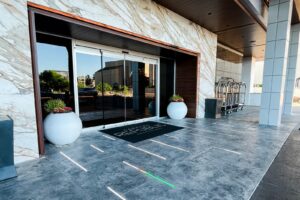When Japanese airline All Nippon Airways introduced all-new first- and business-class suites back in July 2019, I couldn’t wait to fly them.
Designed by famed architect Kengo Kuma, who also created Japan’s stunning new National Stadium for the Tokyo Olympics, the ANA suites are gorgeous but understated, with wood paneling that harkens to Japan’s lush forests, innovative layouts inspired by traditional Japanese living spaces and closing panels for added privacy.
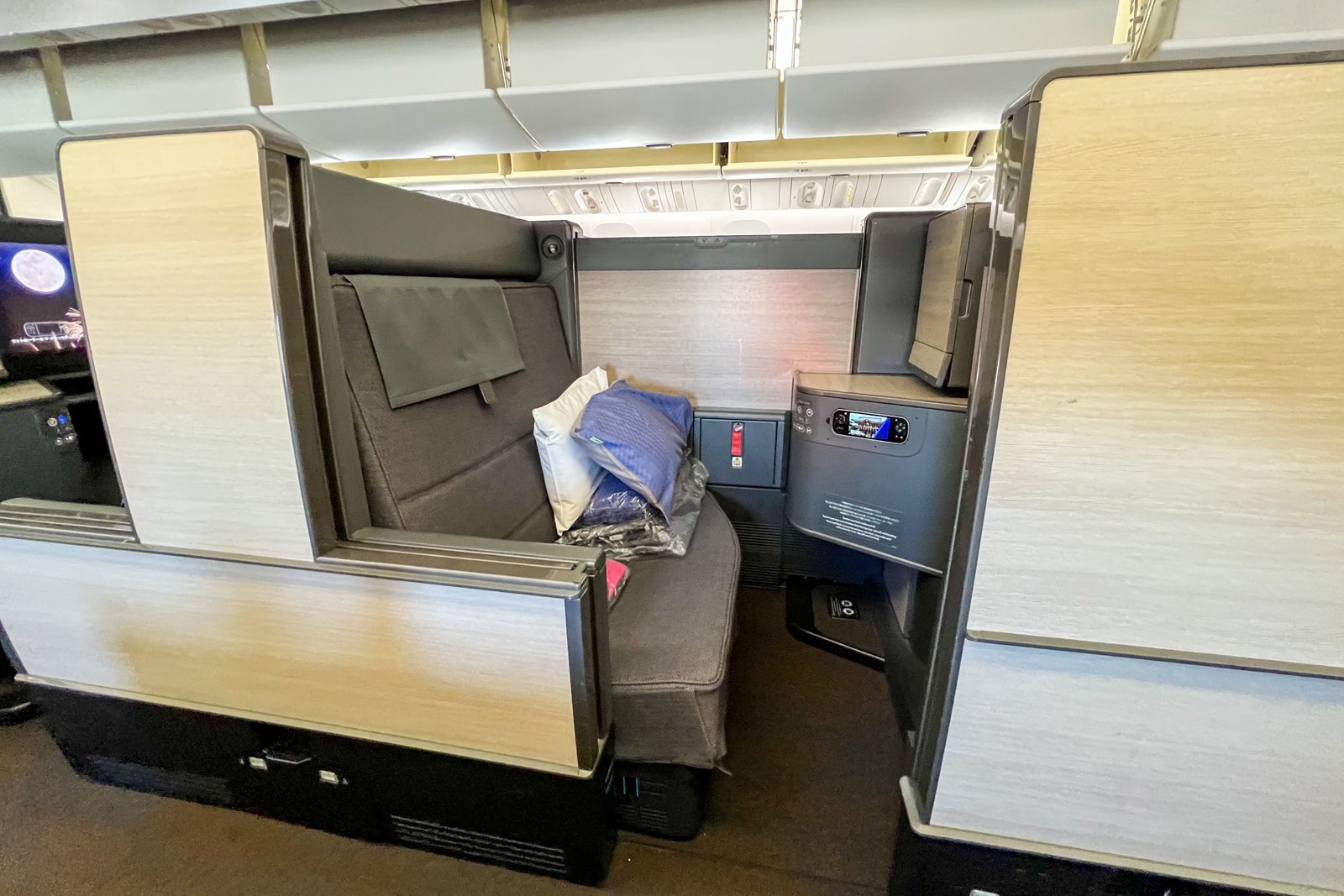
Unfortunately, I didn’t get to experience the new suites before the pandemic limited travel to Japan. But as travel restrictions to Asia loosened earlier this year, including making it easier for international travelers to transit through Japanese airports (the country is now fully reopened to tourists), I went on the search for an award ticket so I could get to fly in at least one of these singular seats.
My chance finally came in September, when I booked an award ticket that would have me traveling from Los Angeles International Airport (LAX) to Tokyo’s Narita International Airport (NRT) in ANA’s “The Room” business class as part of a longer itinerary.
Though I have yet to try the new “The Suite” first class, my long-haul flight in ANA business class was an outstanding experience on its own thanks to the innovative seat’s features and the excellent service on board.
Here’s what it’s like flying in ANA’s The Room business-class suite — and why it is worth booking.
A 10-hour flight is a lot more snooze-able in first class – see how many points away you are from a cozy, 30,000 foot slumber with the free TPG App!
Booking
With skyrocketing airfares, there was no way I could afford the thousands of dollars a trip in ANA business class would have cost me. Instead, I conducted a months-long search for award tickets that would have me traveling at least one leg on ANA en route to another destination.
I have American Express Membership Rewards points that would transfer to ANA’s own Mileage Club program as well as to Air Canada Aeroplan and Virgin Atlantic Flying Club, whose miles and points you can also use to book tickets on ANA. I also have Chase Ultimate Rewards points, which transfer to Air Canada Aeroplan, Virgin Atlantic and United MileagePlus, which is a Star Alliance partner with ANA.
I decided to try to use United miles since I already had a sizable stash of those and it was easier to use them to book my entire itinerary as a single award ticket rather than trying to use either Aeroplan or Flying Club.
Searching both United.com and AirCanada.com, I found a few days with award availability on ANA from Los Angeles, where I’m based, to both NRT and Haneda Airport (HND) in Tokyo on the way to various destinations in Southeast Asia.
The new business- and first-class suites are only aboard some, but not all, of ANA’s Boeing 777-300ERs, and not the airline’s other jet types, so I was careful only to search routes and specific flights where I was sure the new suites would be in service.
If in doubt, when you find an award ticket on an ANA 777-300ER, you can search for the same flight on ANA’s site and it will denote whether the flight has The Room on board. Otherwise, you can also look at the seat map for your flight: If it has 16 rows of business class running from rows 5-20, you should be set.
I ended up booking an itinerary that would have me flying ANA The Room business class from LAX to NRT, then on to Bangkok’s Suvarnabhumi Airport (BKK) in the airline’s older business class aboard a Boeing 787-9 after a brief layover. I’d overnight in Bangkok before continuing on to Bali’s Ngurah Rai International Airport (DPS) on Thai in economy.
My ticket totaled 103,500 United MileagePlus miles plus $18.40 in taxes and fees. I found a similar ticket that would only get me to Bangkok using around 87,000 Aeroplan miles with slightly higher taxes and fees, but then I would have needed to purchase my ongoing ticket to Bali, so I stuck with MileagePlus.
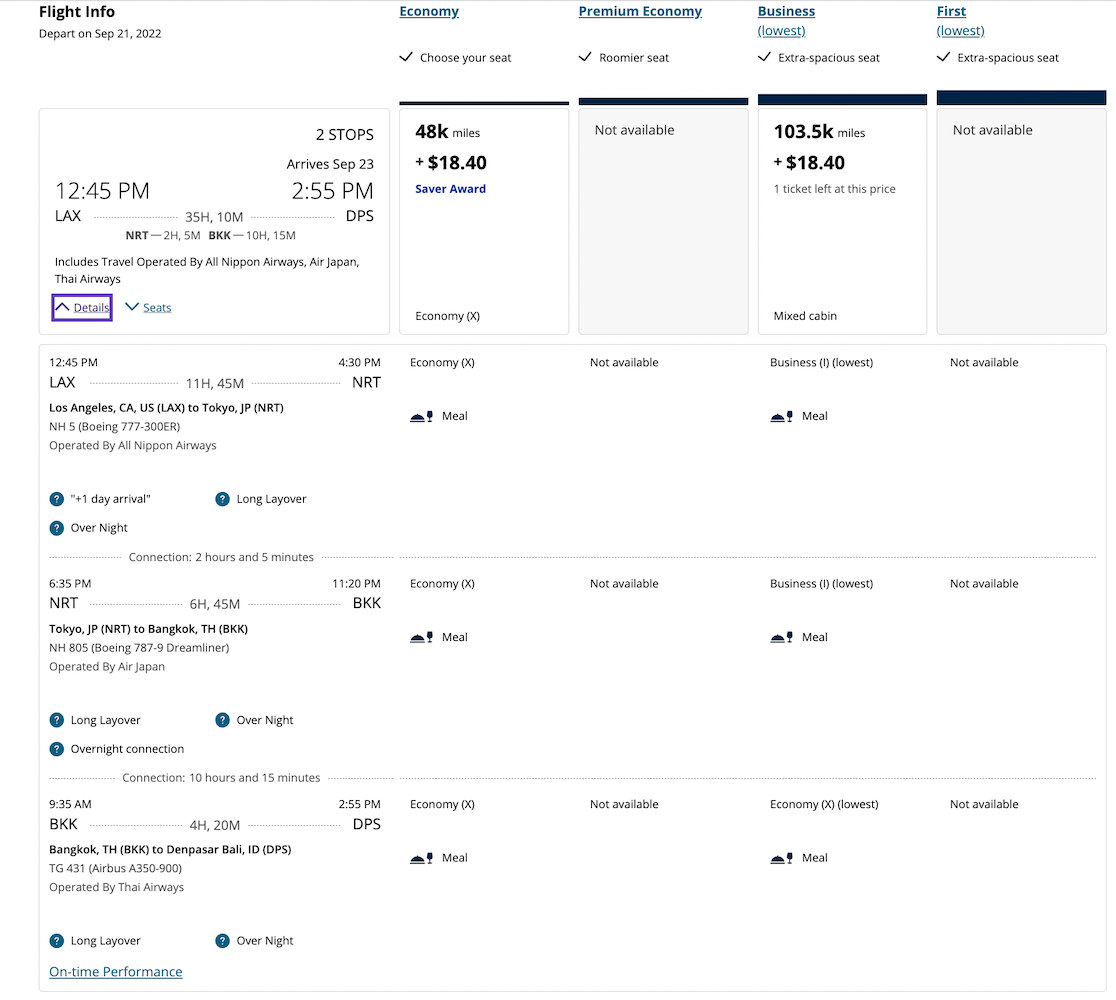
Not that I would (or could) book a paid fare this high, but I priced out my itinerary on Google flights at just over $6,100. Looking at dates over the next few months, the prices for the same itinerary I flew varied at the time from around $4,100 to $7,800. So even at the lower end of that range, I was getting nearly 4 cents per United mile in value. That’s well over the 1.21 cents apiece TPG currently values United MileagePlus miles at.
Airport experience
My flight departed at 12:45 p.m. and I arrived at the airport 2 1/2 hours ahead of that just to have some extra time to get through the traffic at LAX (hopefully the airport’s long-awaited people mover will open next year and cut through some of that congestion) and past security at the airport’s Tom Bradley International Terminal.
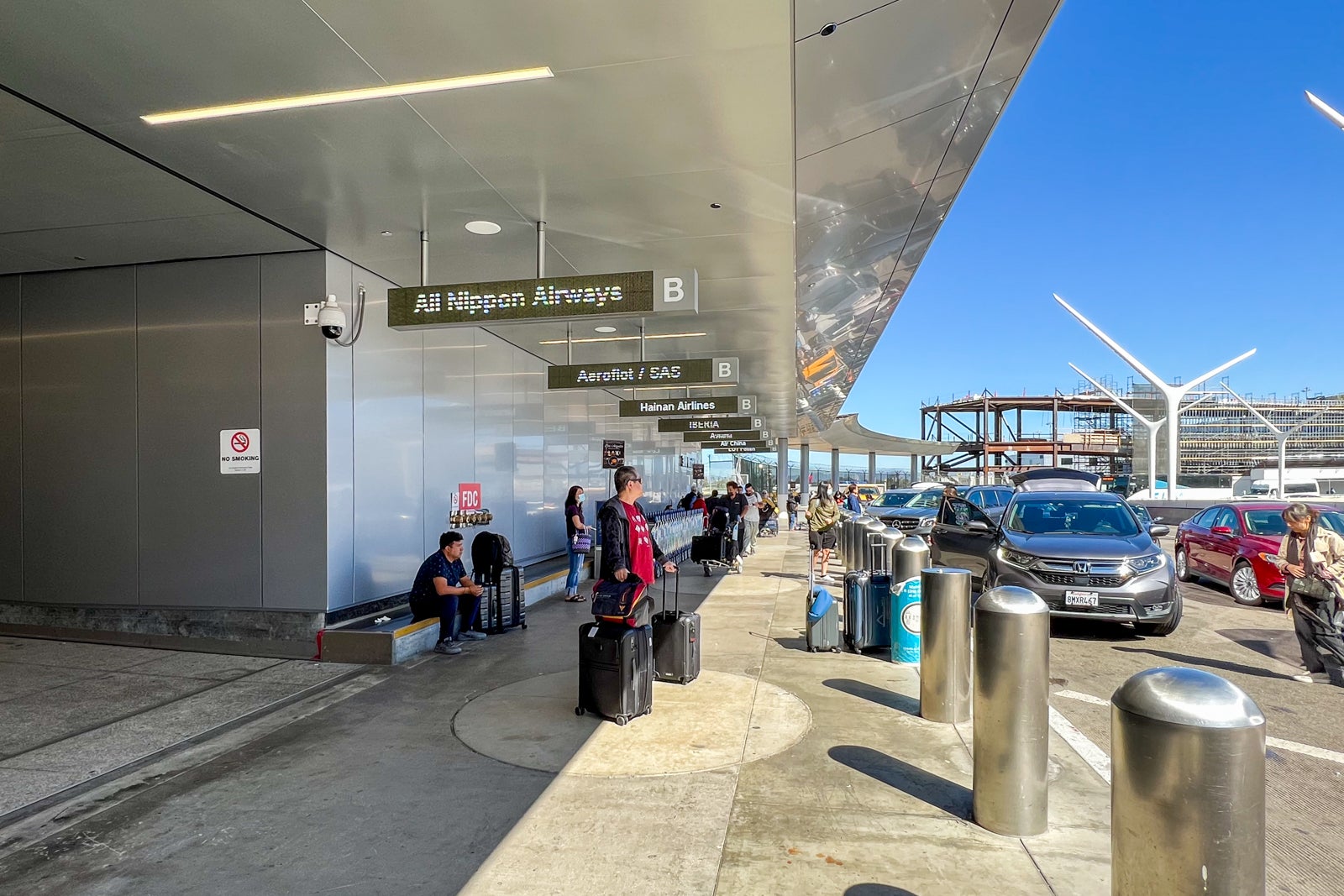
Check-in for my flight was just getting underway when I strolled into the terminal, and there were a few other passengers already waiting in the dedicated line for business-class passengers. This line was also open to passengers in premium economy and travelers with Star Alliance Gold status as well as ANA’s Platinum elite status and Super Flyers Card holders.
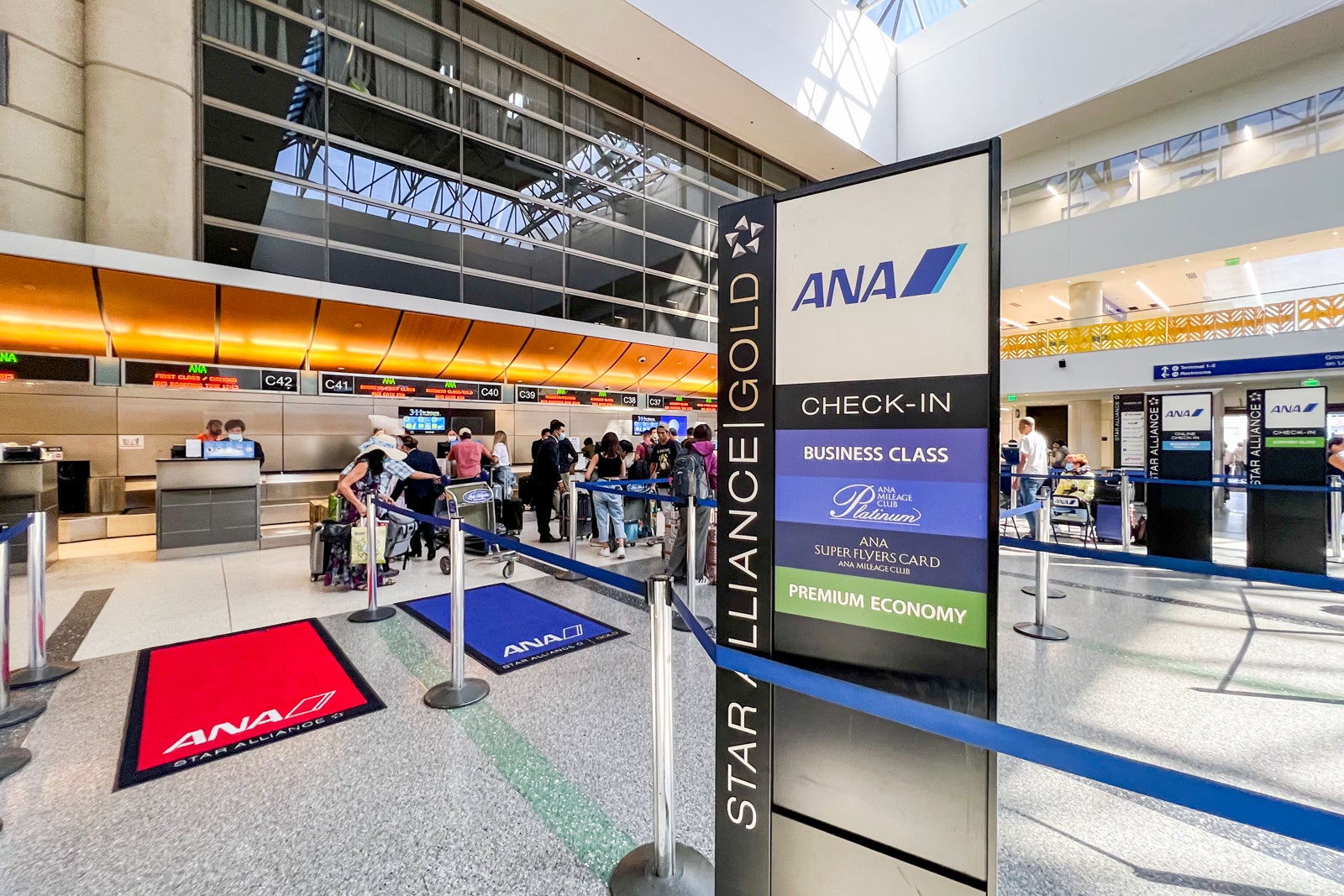
Despite that, it only took about two minutes before an agent waved me over and printed boarding passes for my entire itinerary, including the Thai flight from Bangkok to Bali.
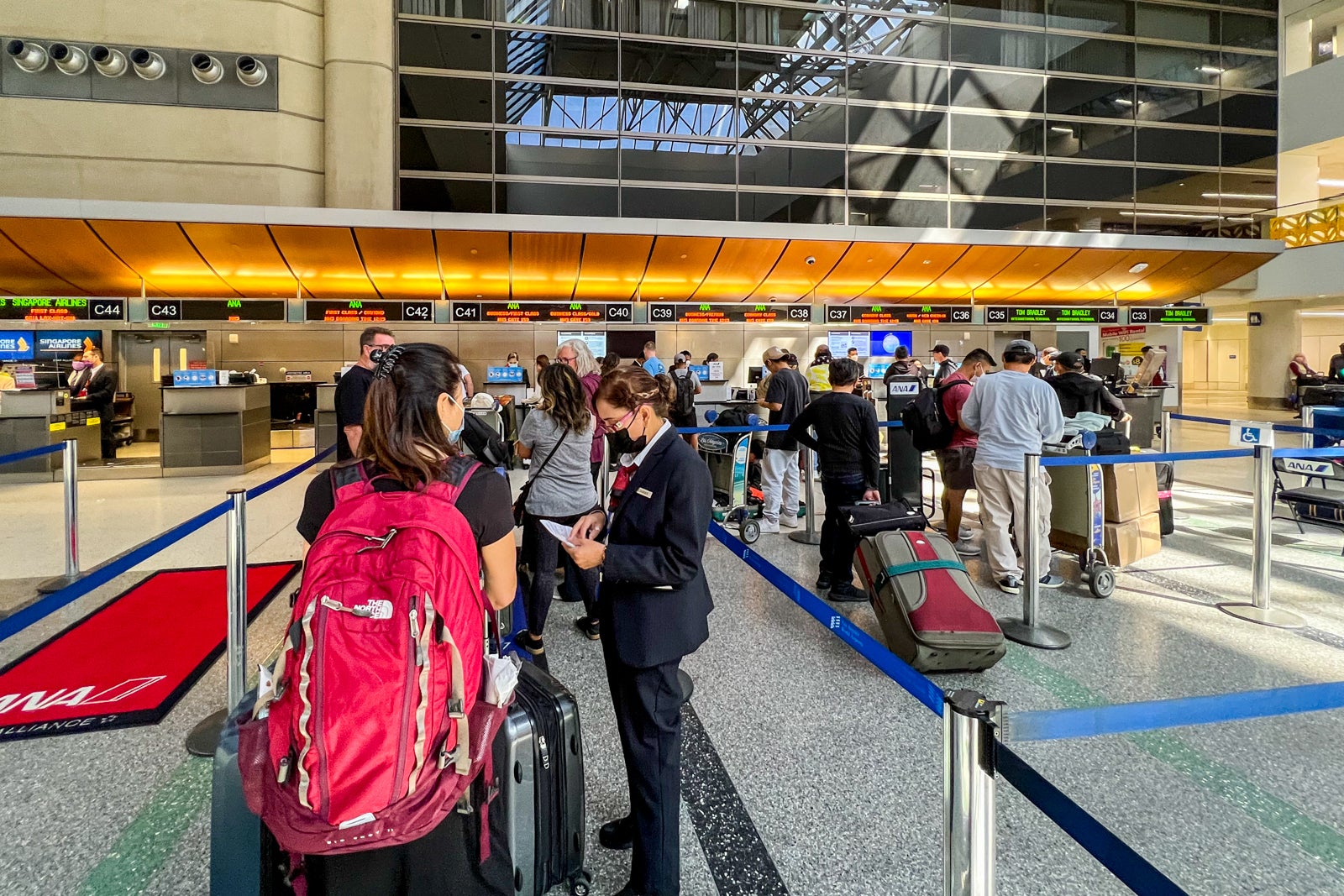
ANA participates in TSA PreCheck, so I was able to use the expedited line and got through security in under two minutes. That left me plenty of time before my flight to head to the Star Alliance lounge, to which my ANA business-class ticket gave me access.
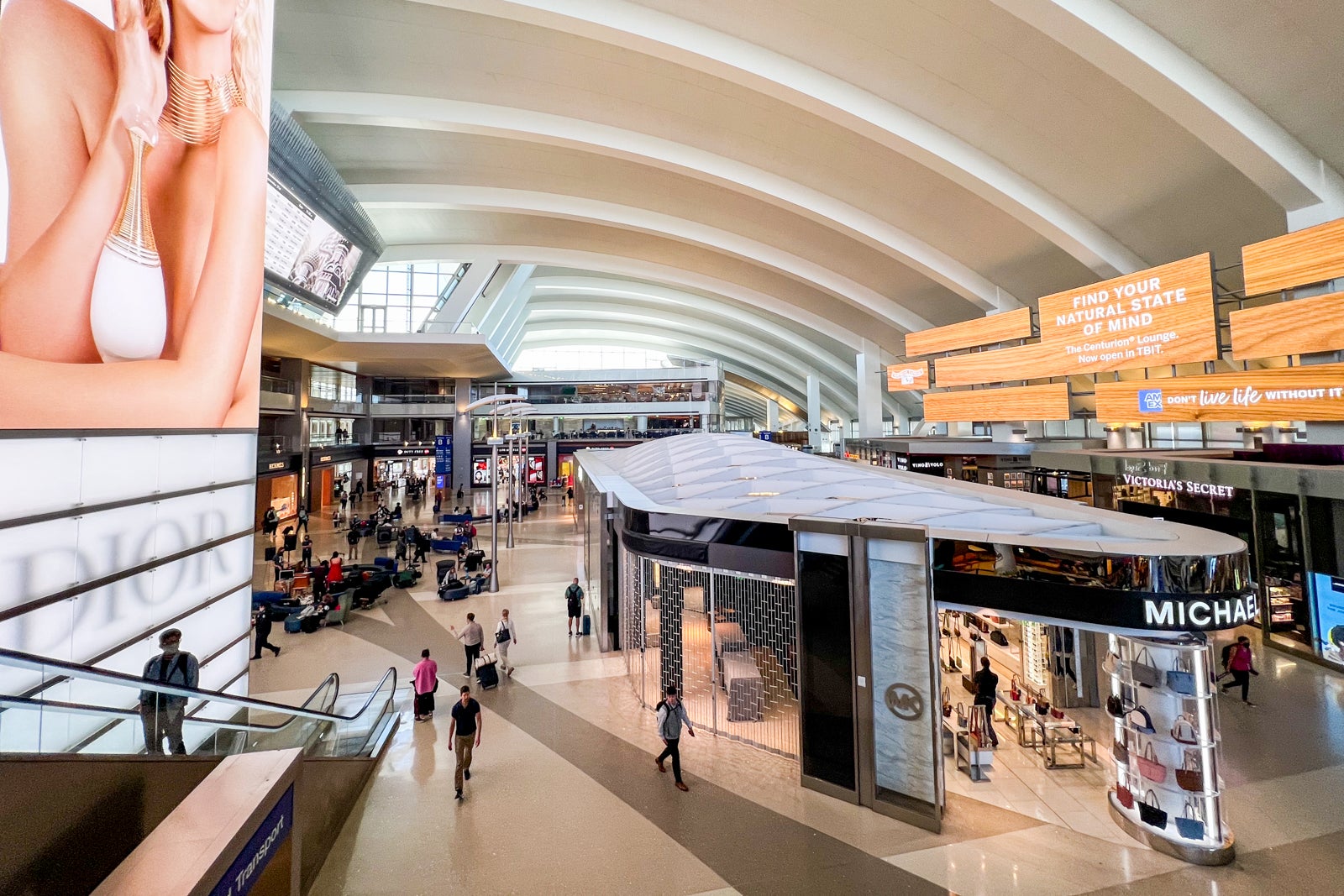
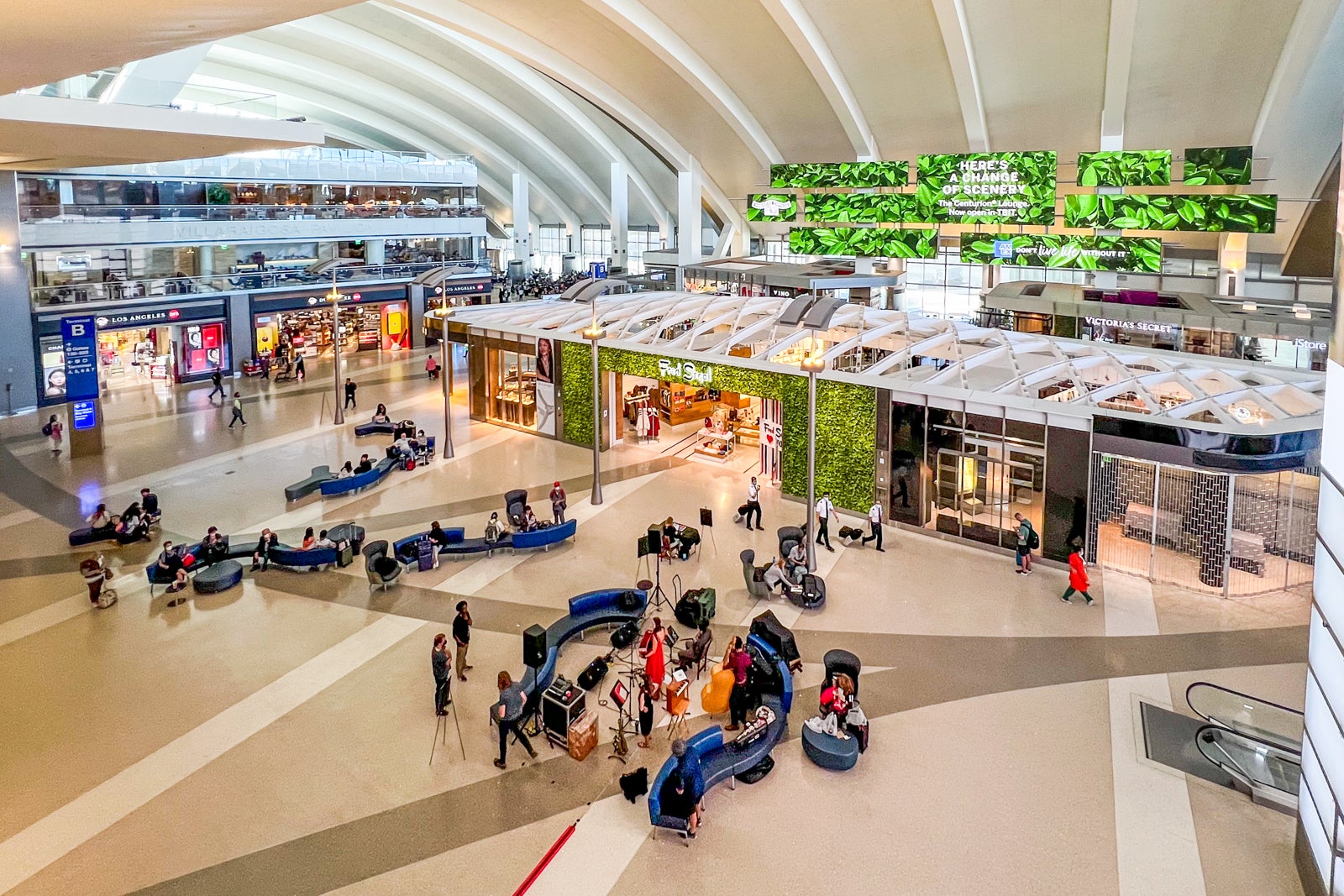
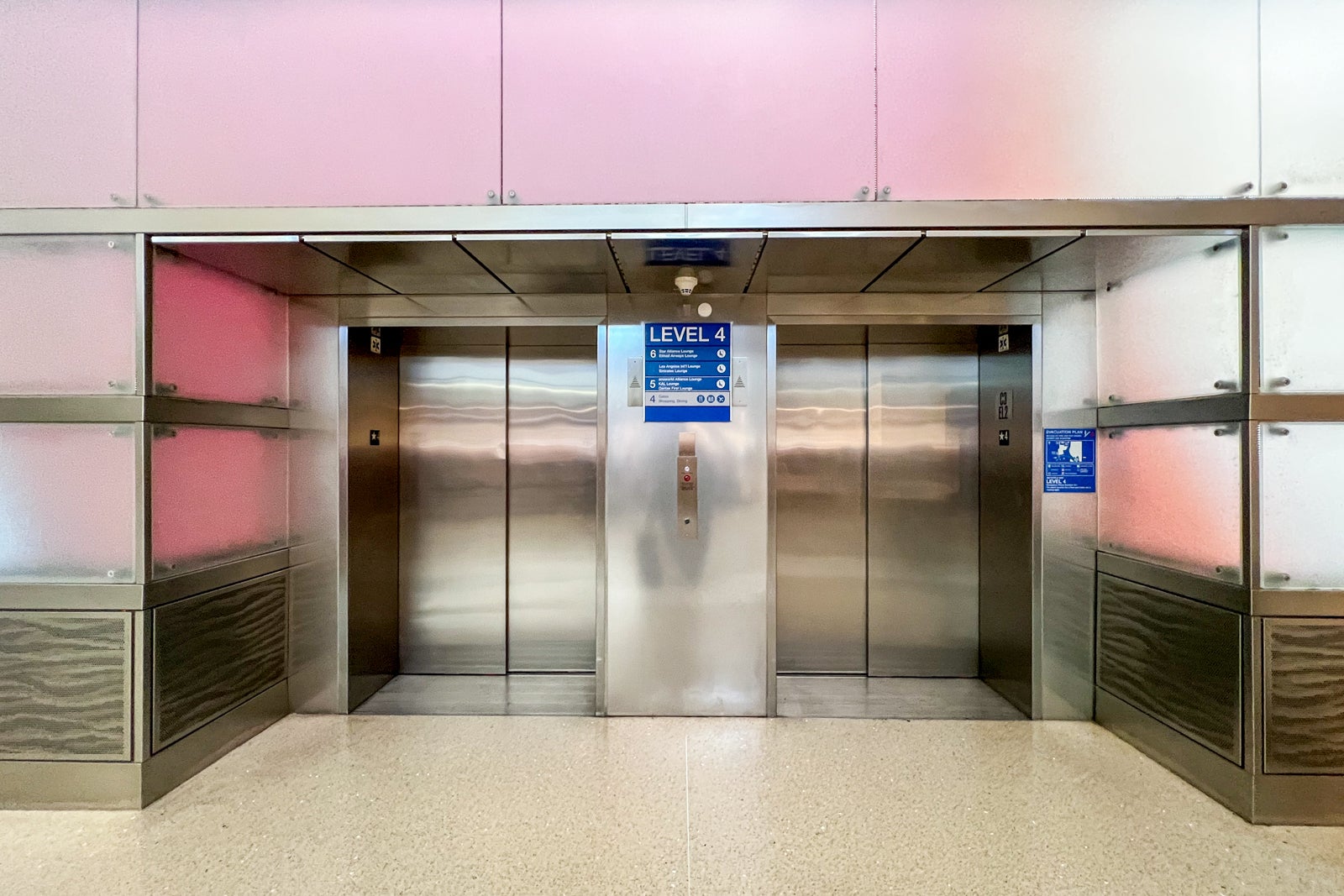
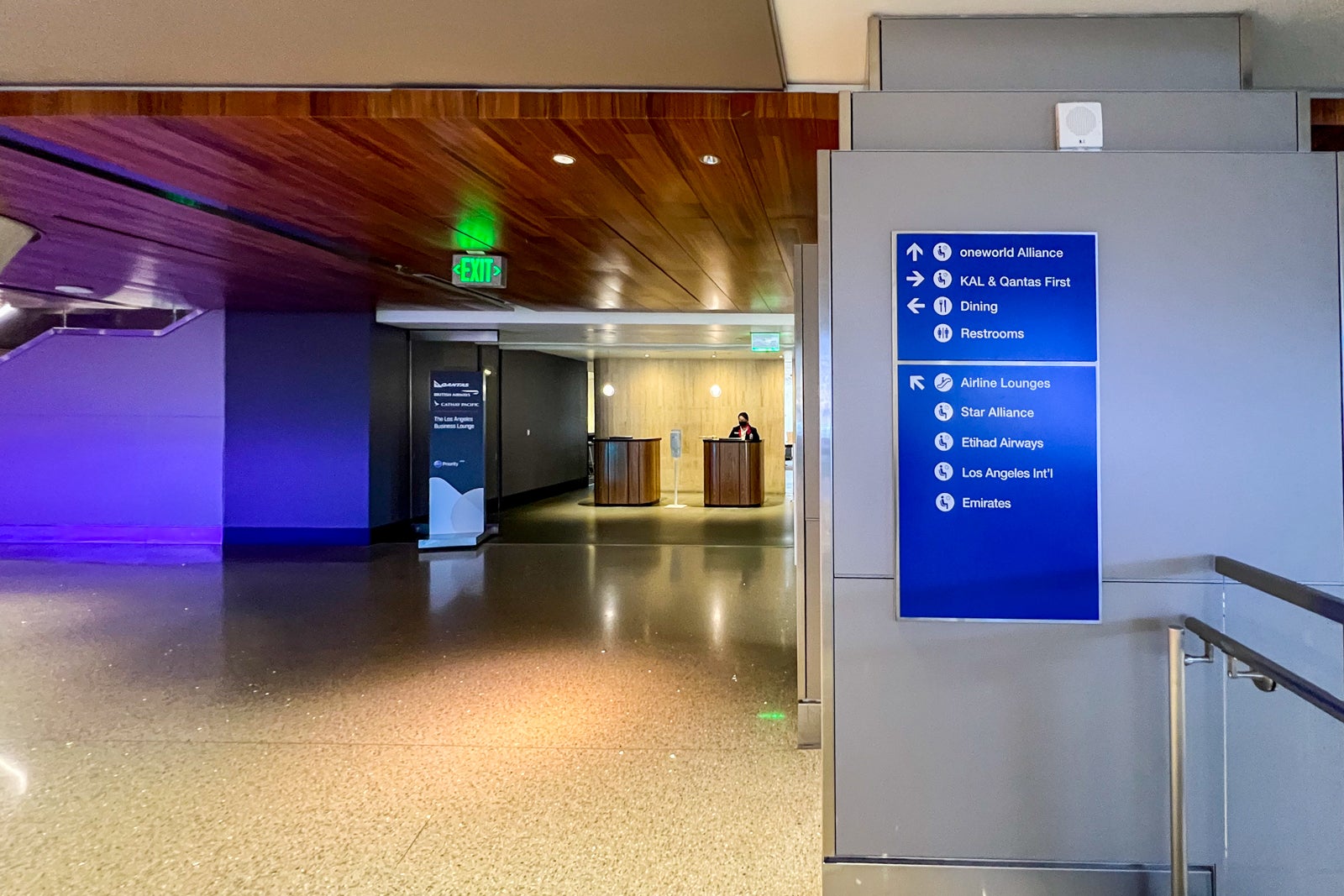
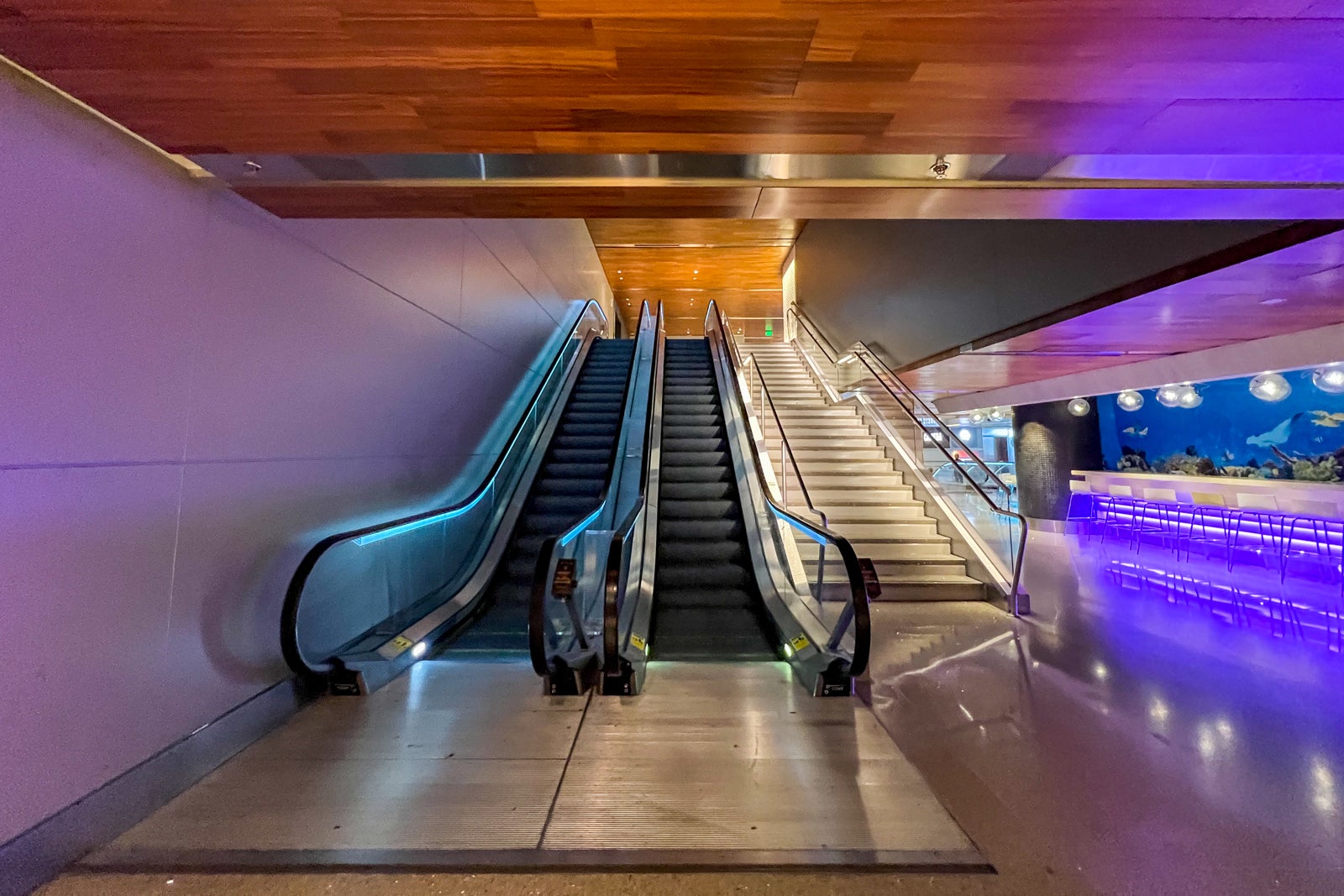
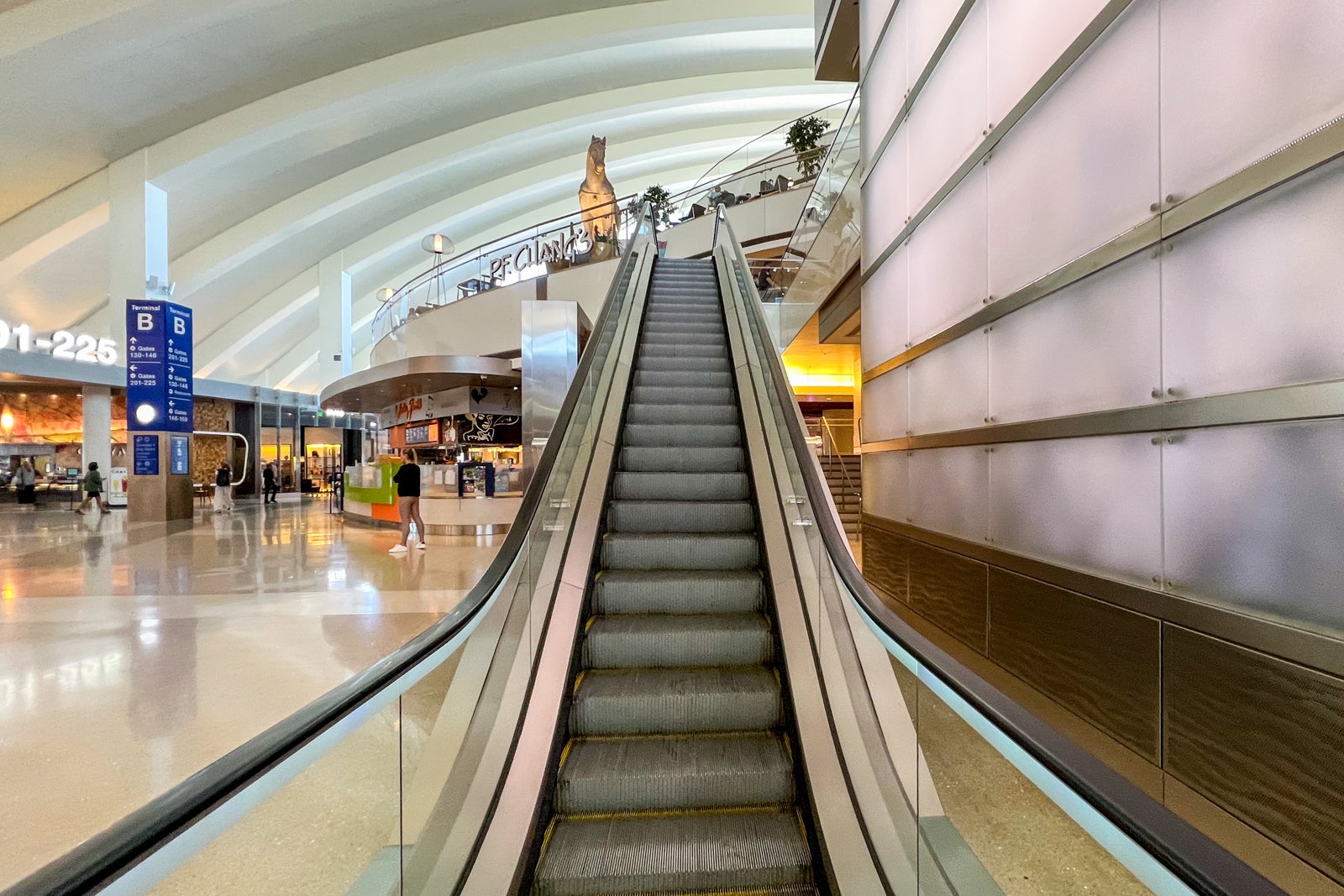
The lounge is located on the sixth floor of the terminal, two levels up from the main concourse. You can either take an elevator or two sets of escalators there.
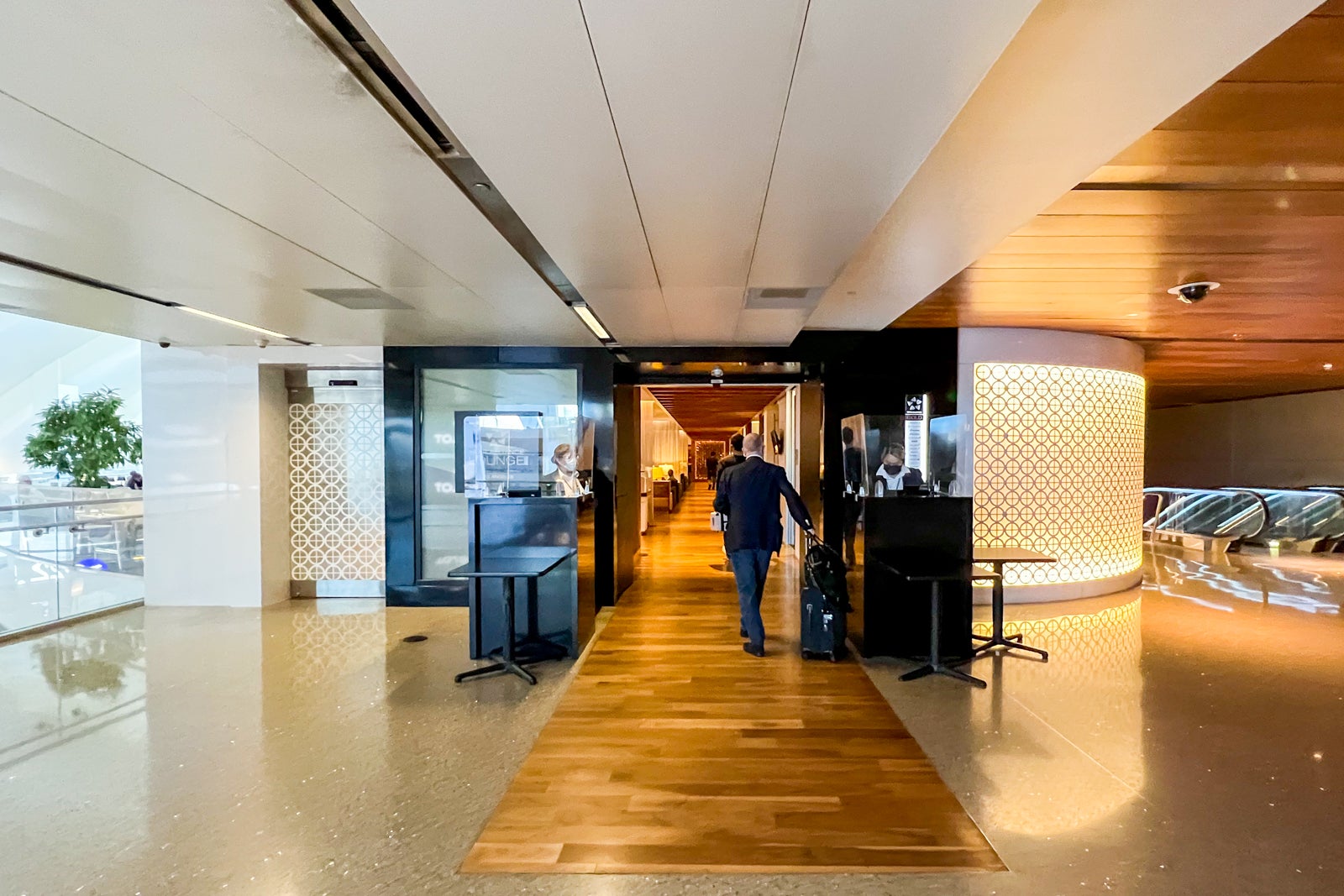
It seems like it’s back to business as usual at LAX’s lounges, including this one. All the facilities, including the buffet, showers, bars and various seating areas were fully open and operational. We’ve covered this lounge in many past reviews and not much has changed, so I won’t go into granular detail here.
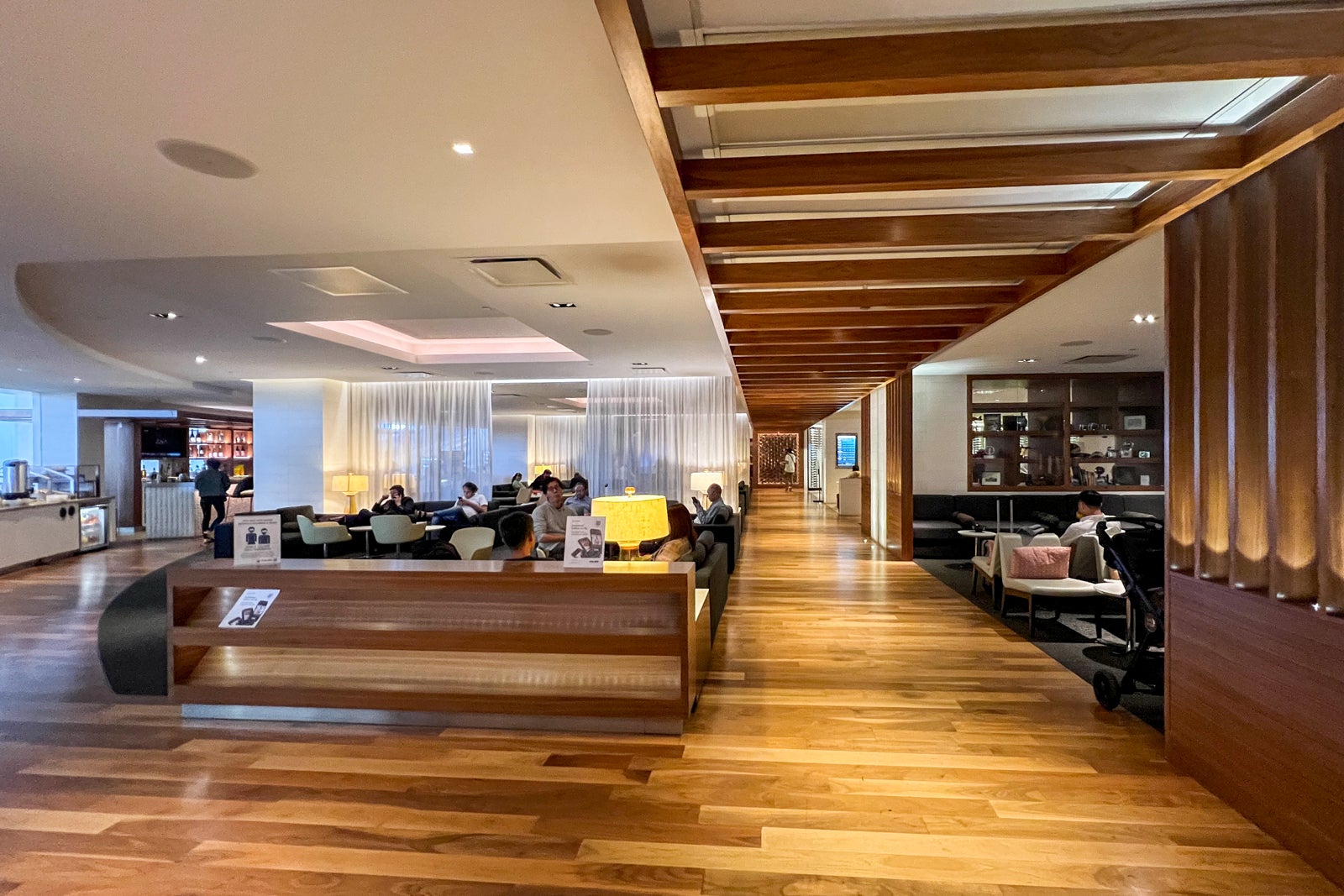
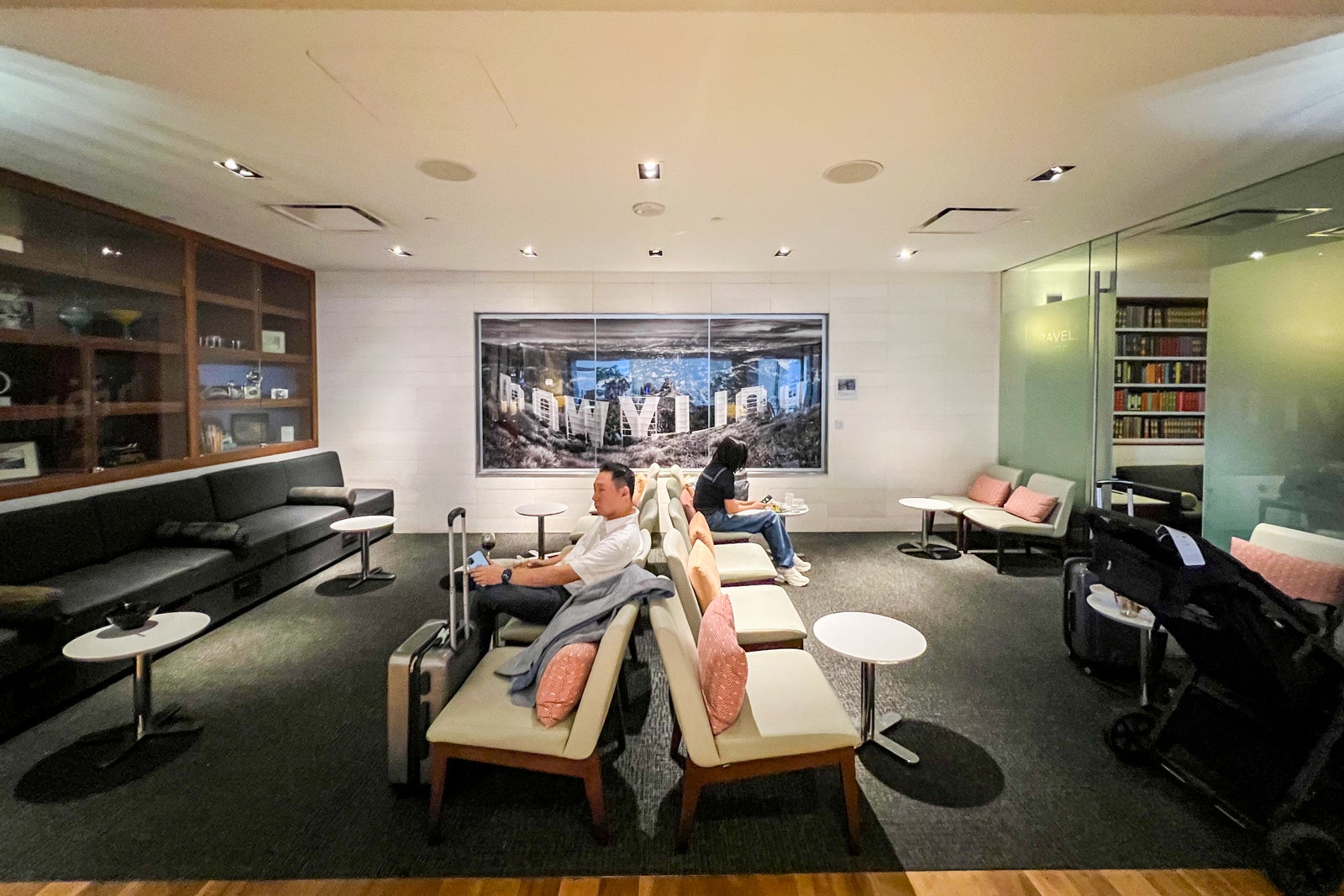
The main lounge area consists of various seating areas where folks can relax before flights or get some work done. There are a few smaller rooms including the so-called Library, complete with book-lined shelves and a media room with a flatscreen television playing the news. I especially appreciate the photographic prints of various L.A. landmarks you can spot around the space.
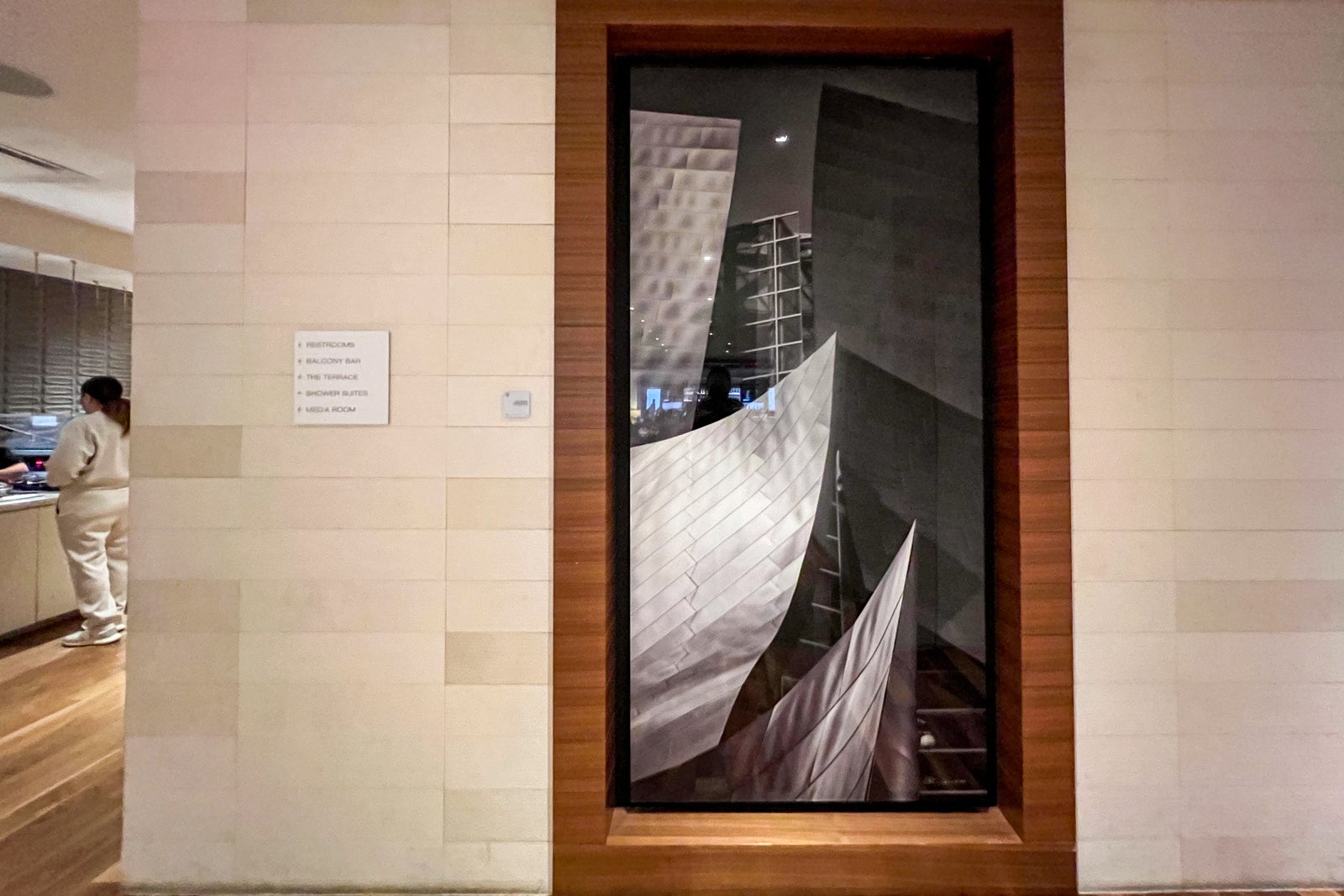
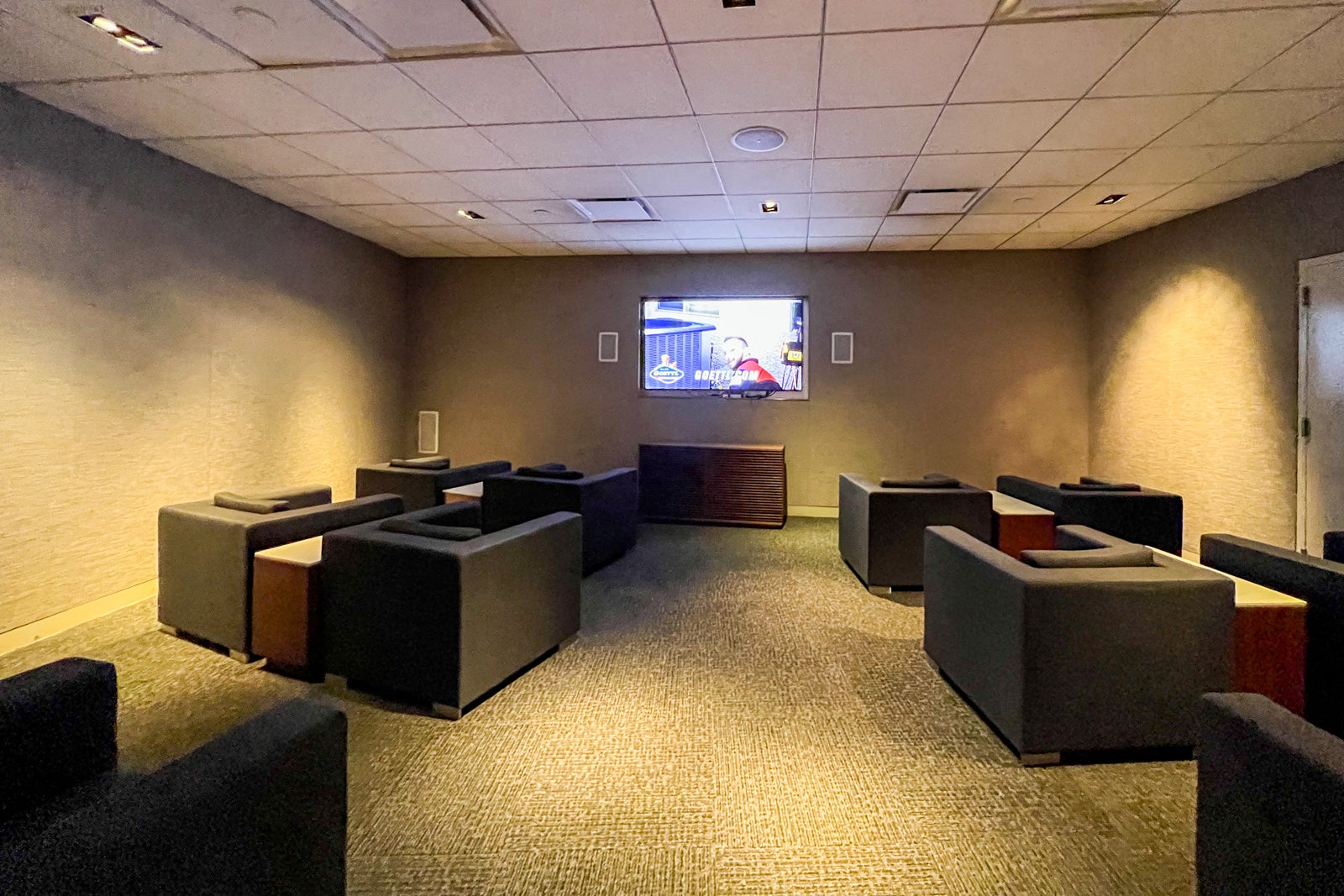
If you veer to the left after you enter, you can snag a seat on the “alfresco” deck, which is still inside the terminal but overlooks the main concourse and has lots of low seating areas. If you head back to the interior space from here, there is a staffed bar serving wine, beer and spirits.
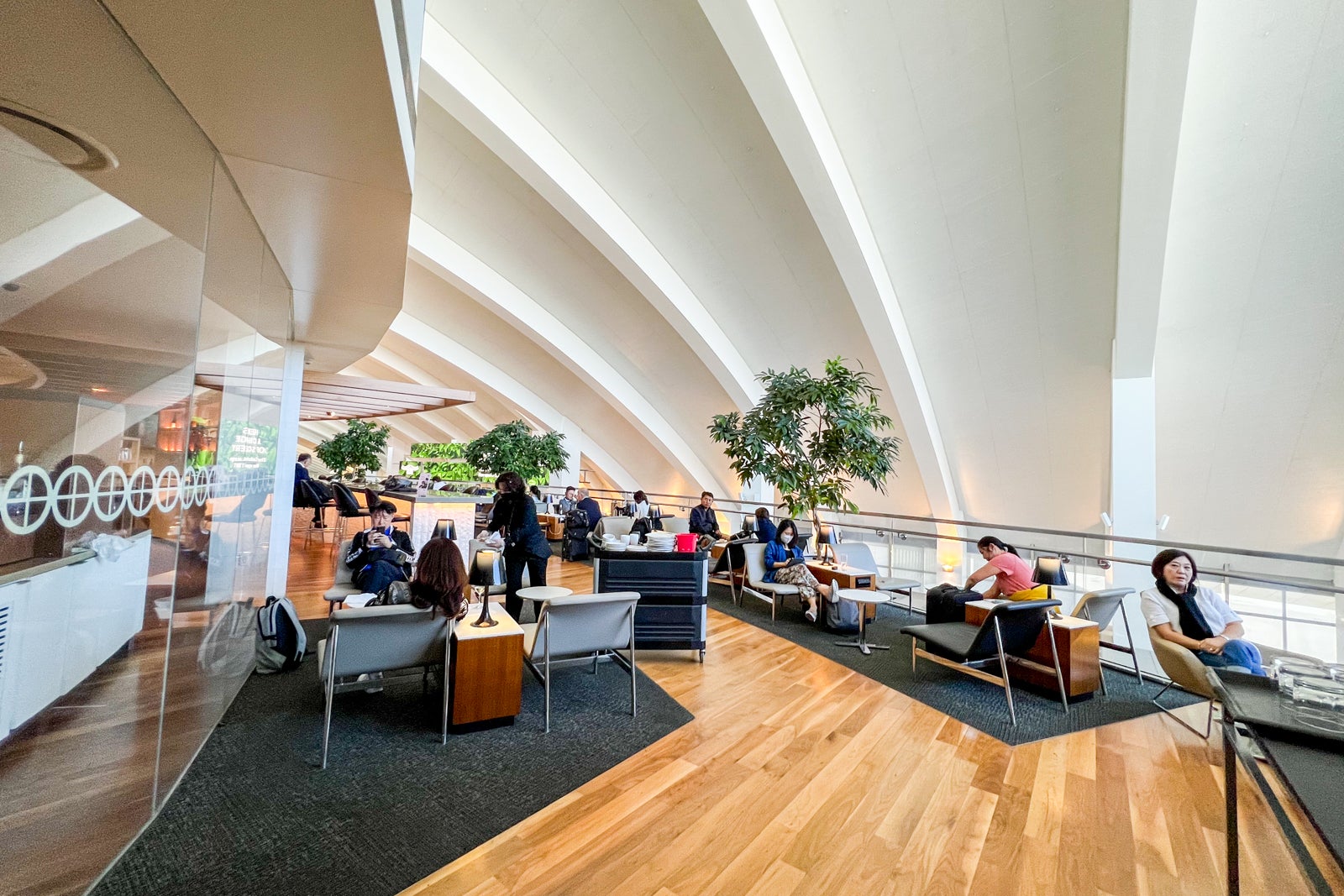
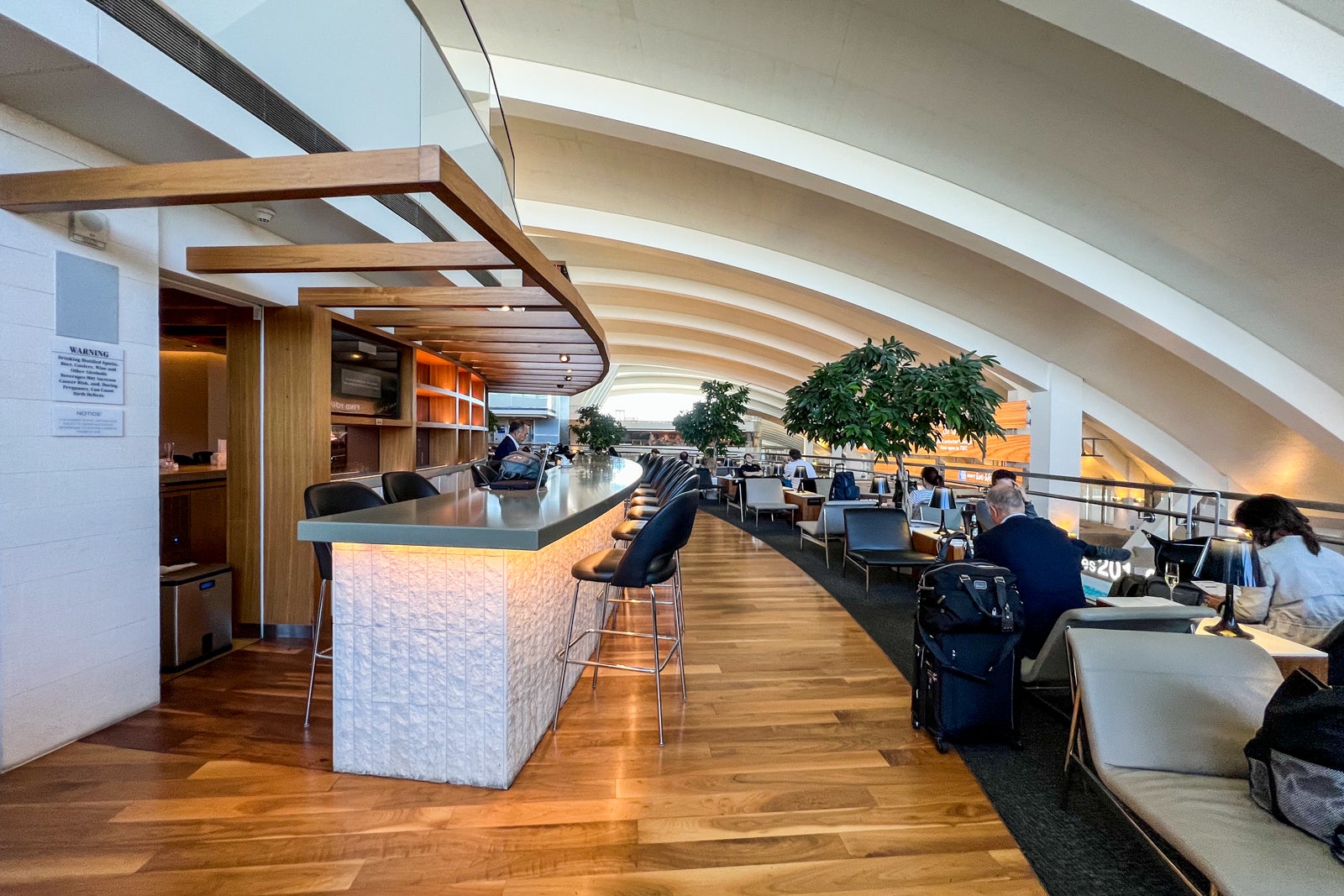
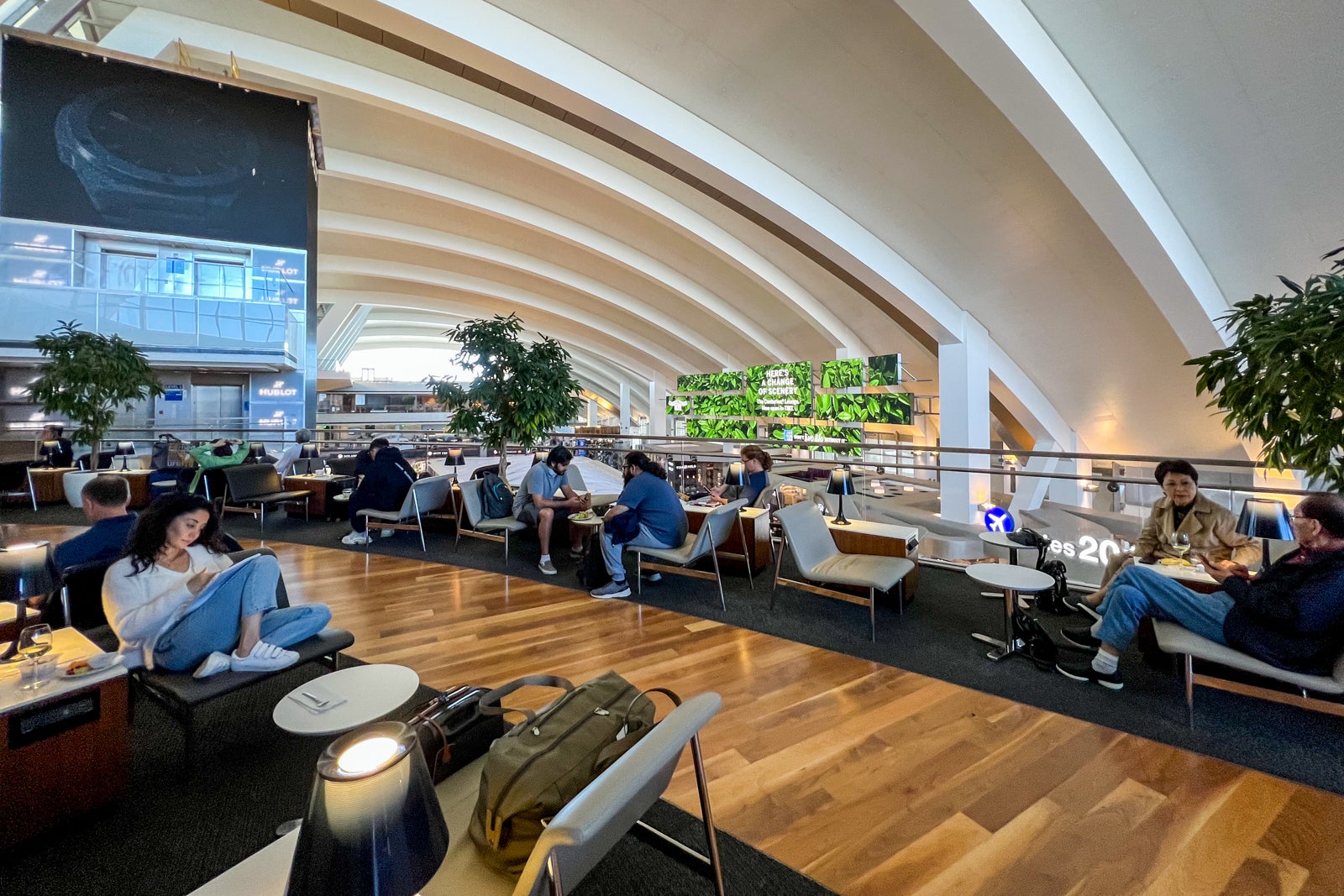
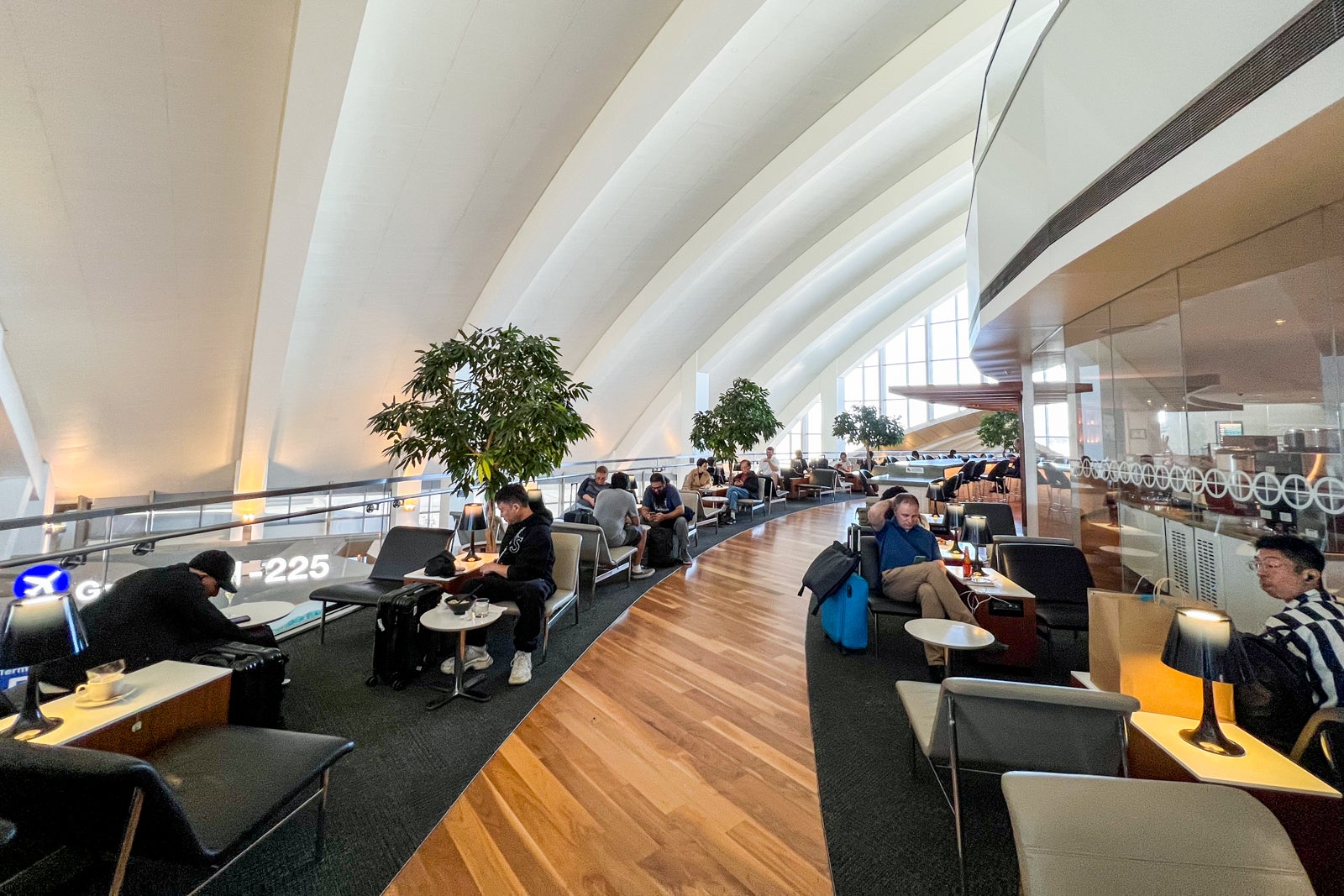
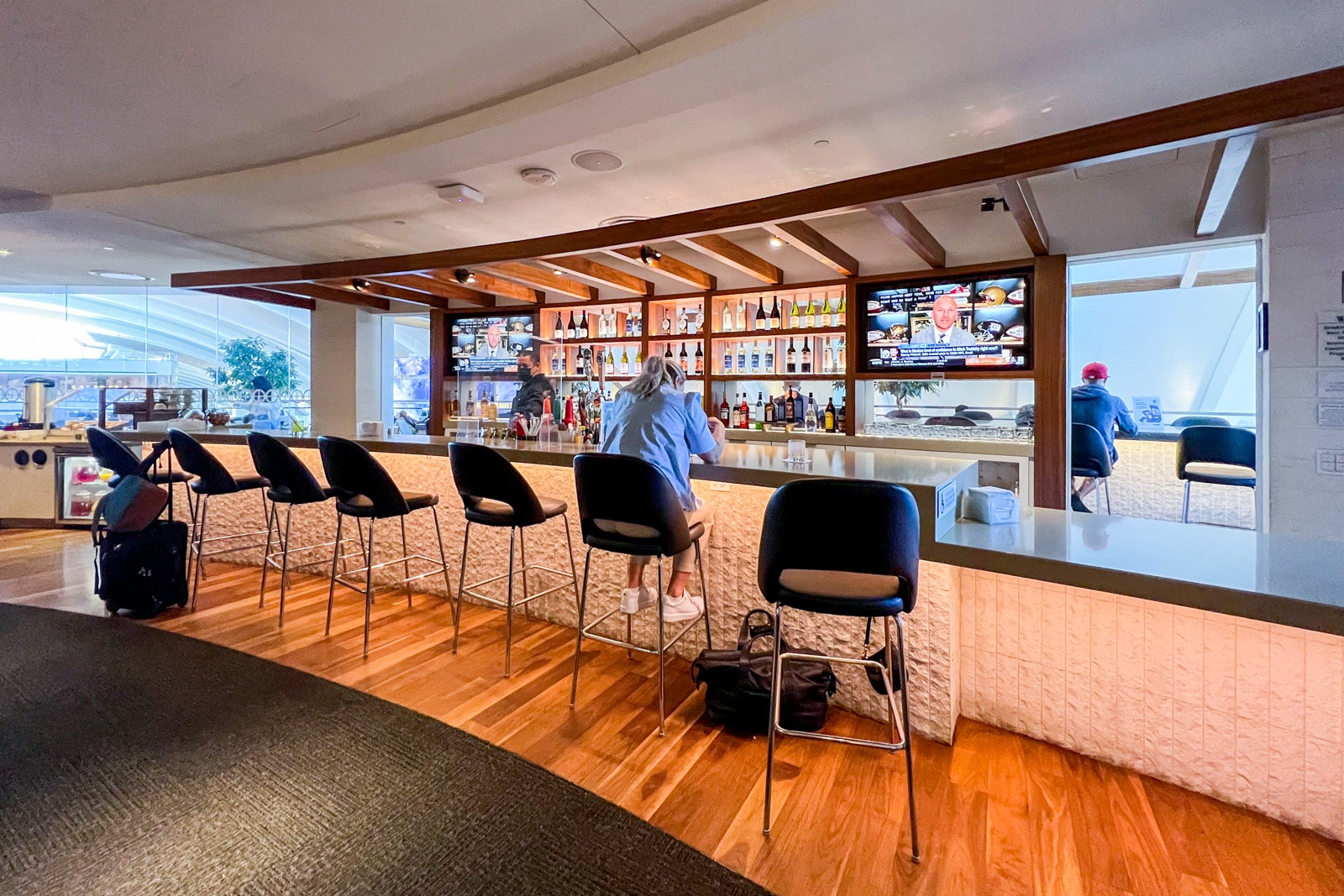
Across the main seating area from here is a section with cafe tables and chairs adjacent to the buffet. During my mid-morning visit, the staff put out fresh salads, curried chicken with rice, pasta with tomato sauce and caprese sandwiches, among other nibbles.
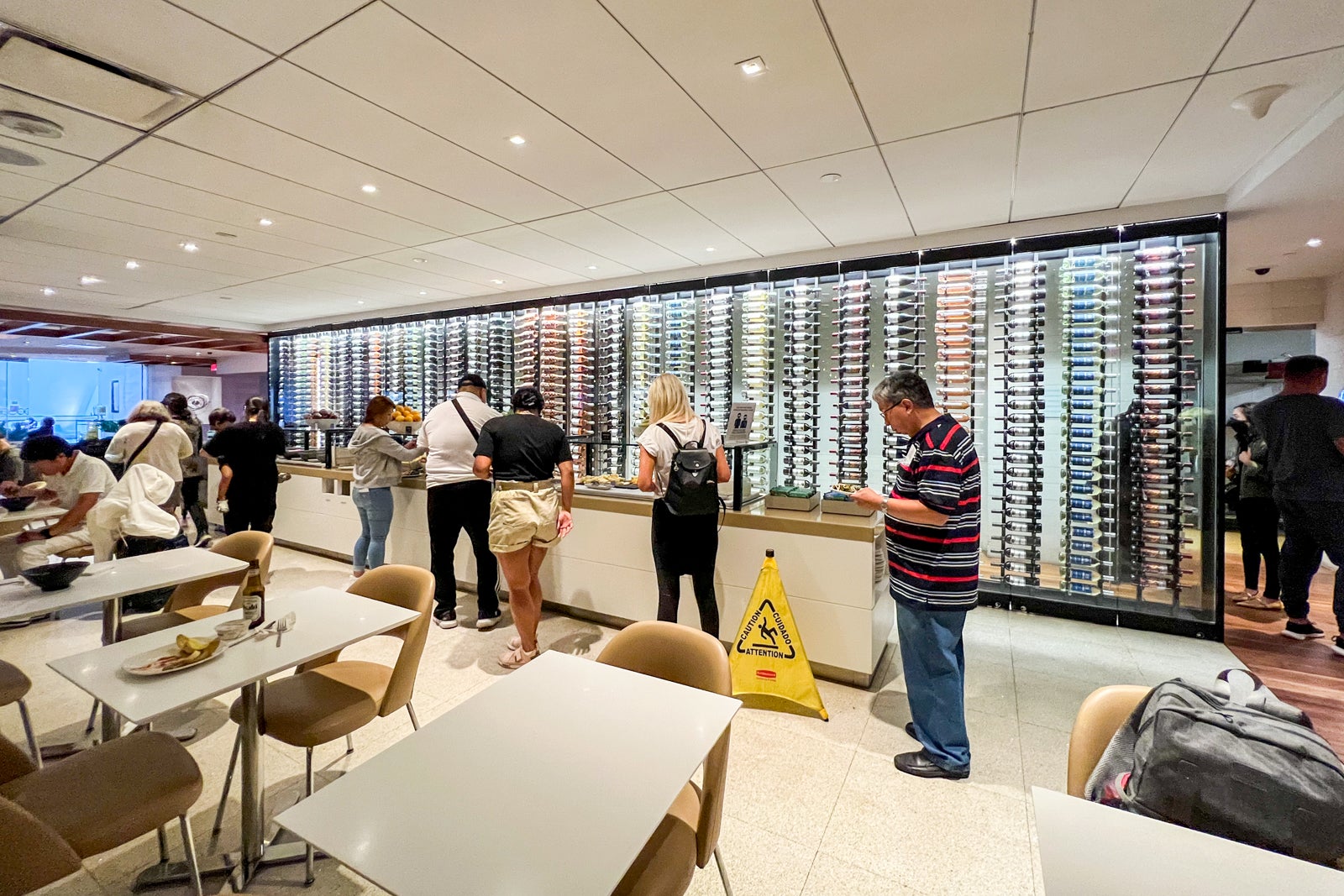
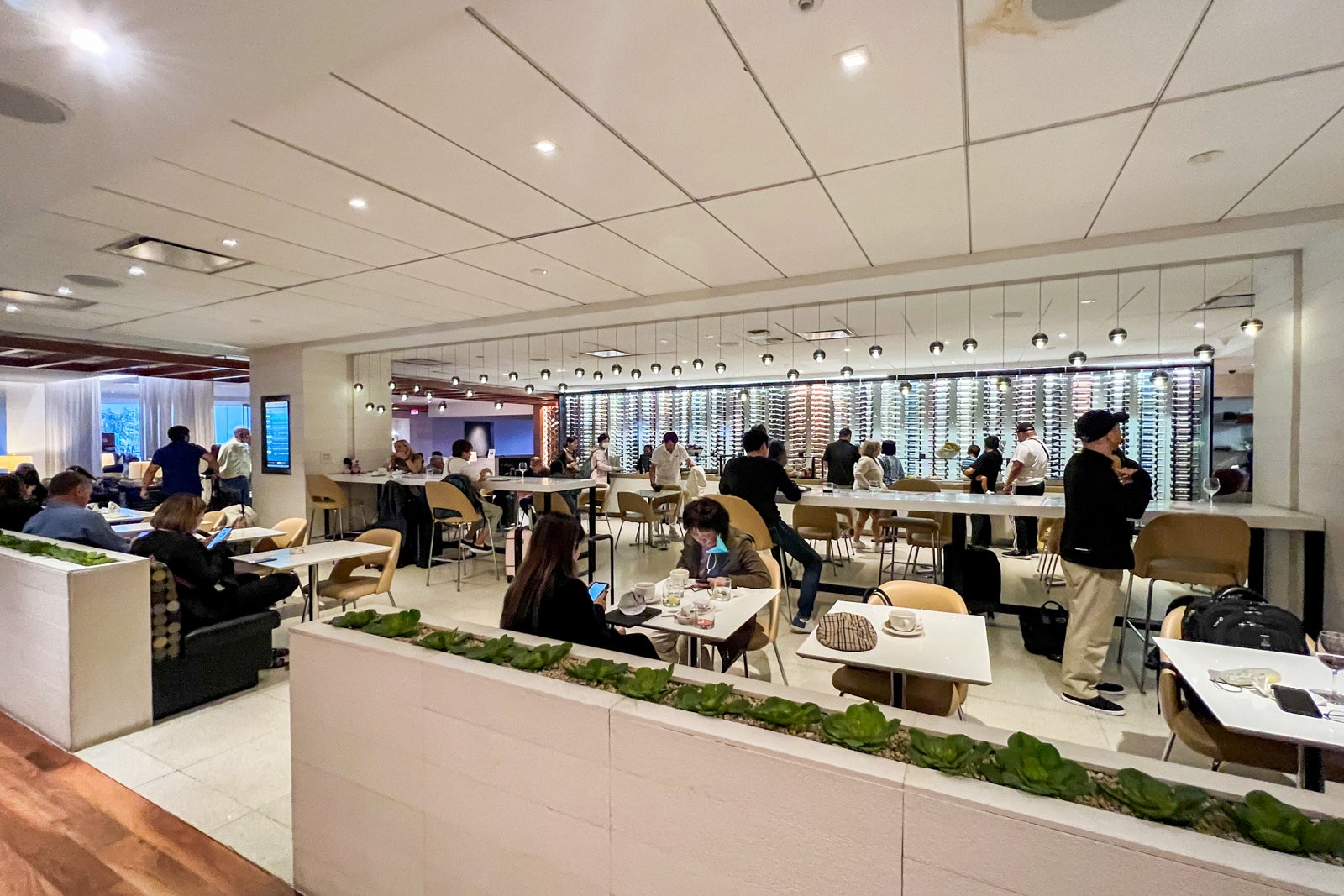
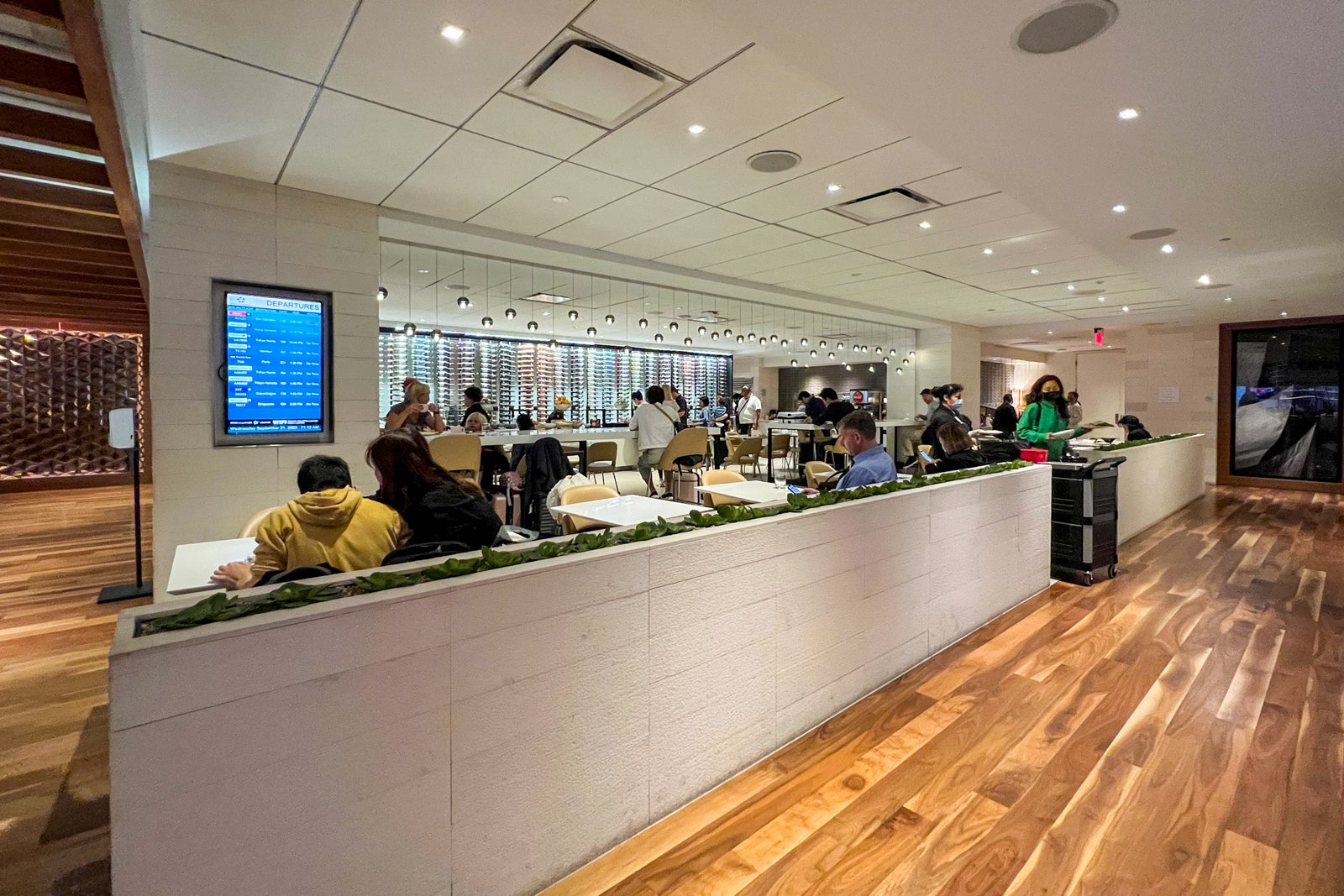
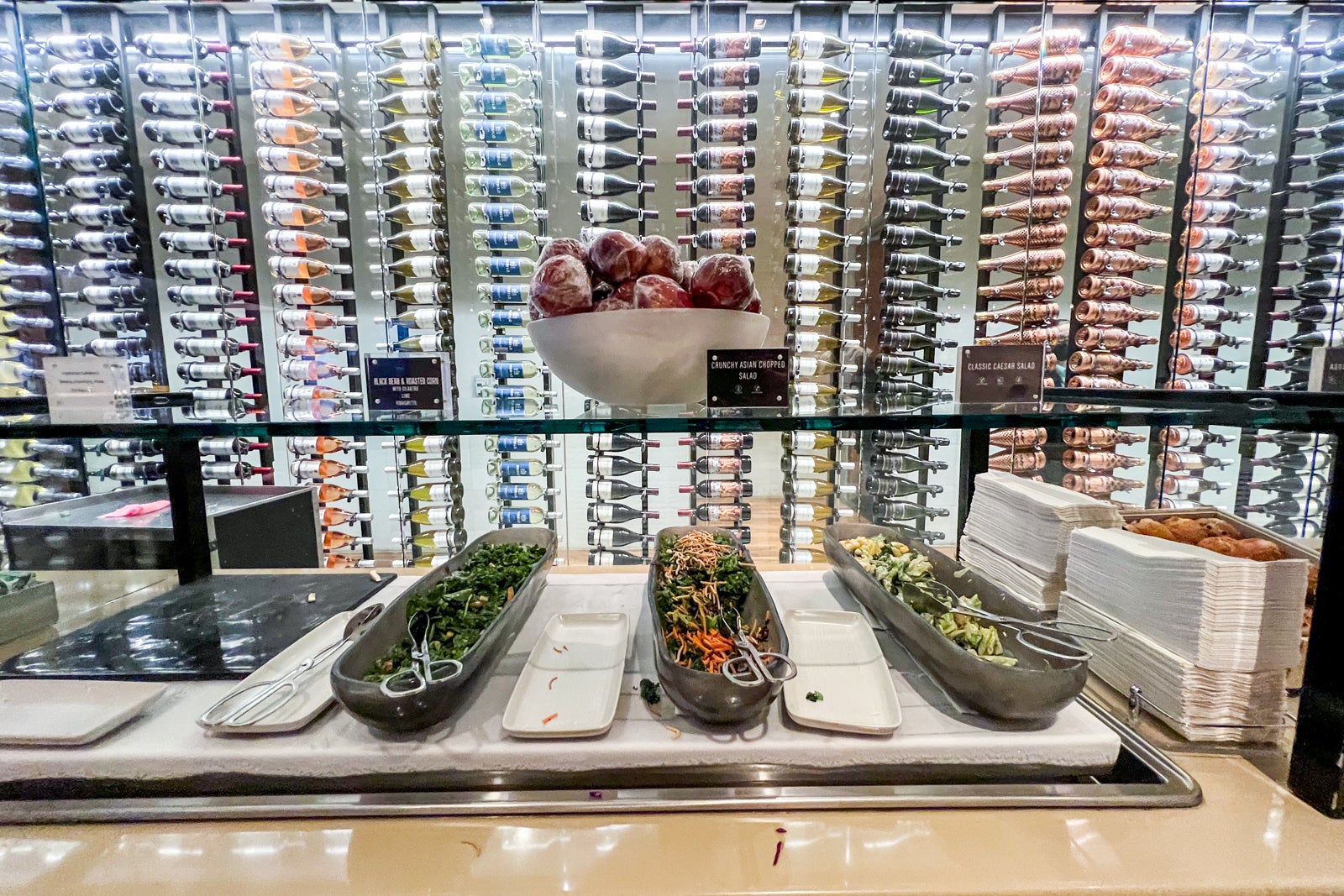
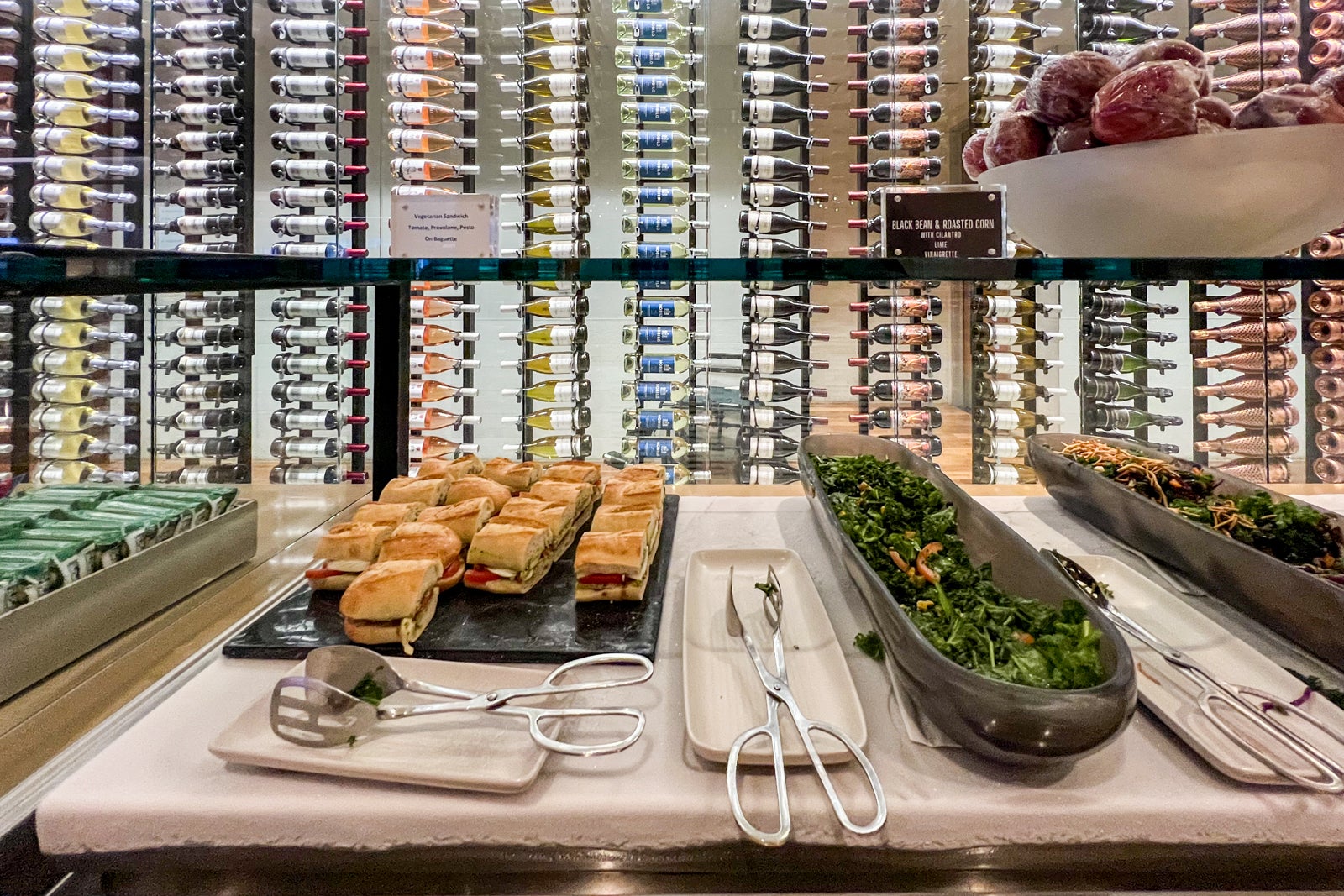
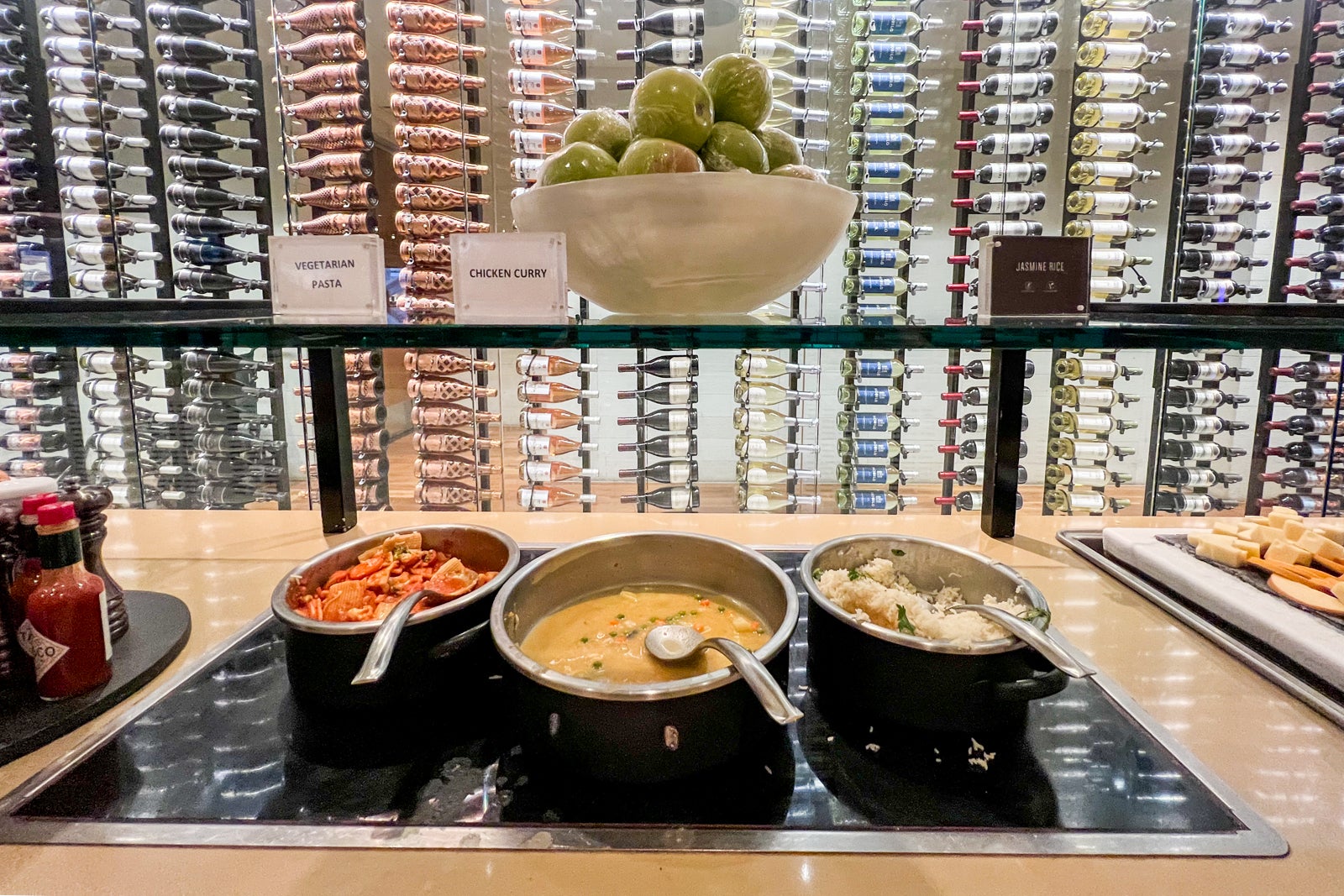
My favorite part of this section is probably the glassed-in wine wall with illuminated bottles on display.
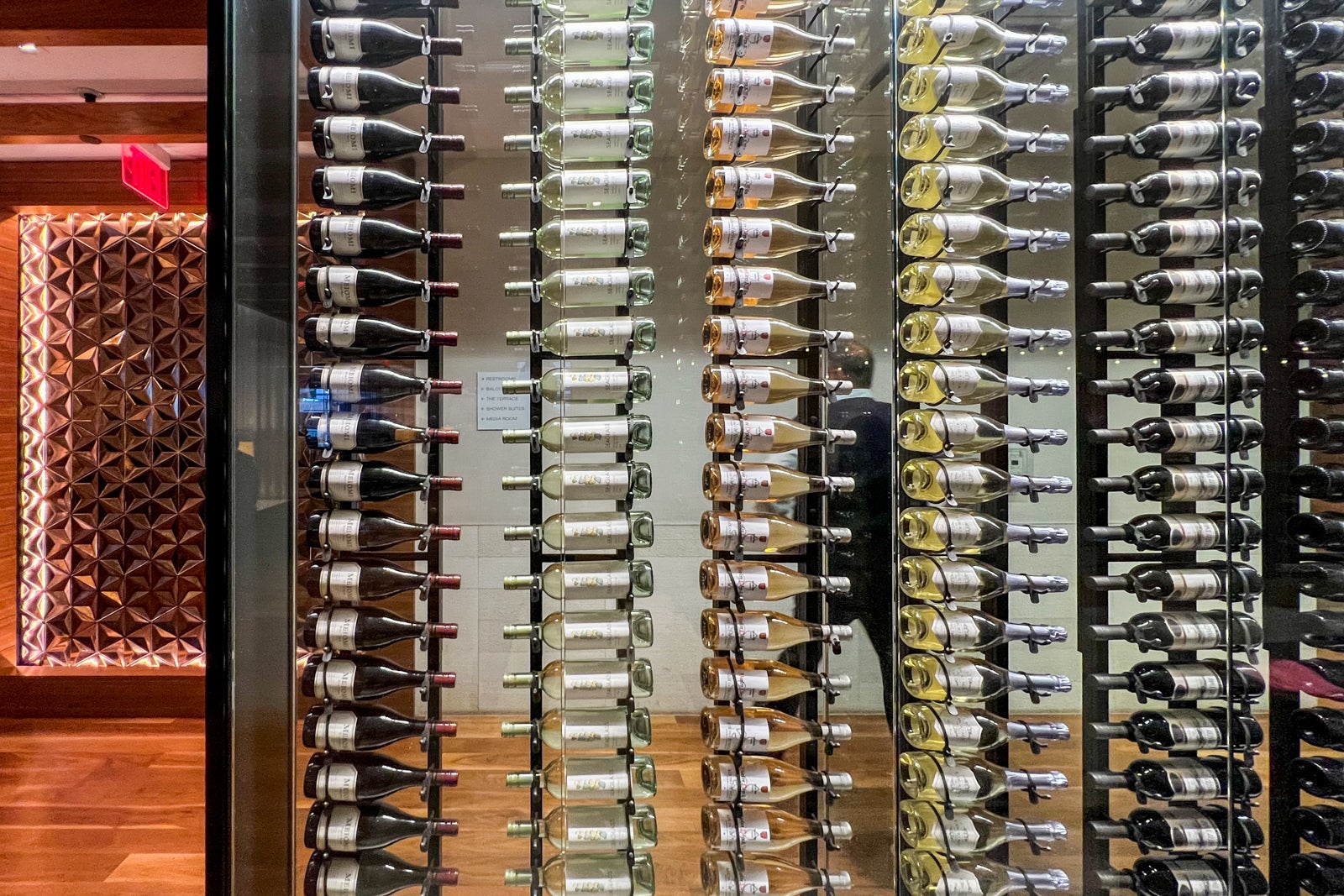
Those in the know continue toward the back of the buffet area to the soup and noodle bar. During my visit, there were selections like tomato-basil and chicken broth. But you can also select precomposed bowls of noodles, load them up with toppings like crab, chicken, tofu, serrano chiles, carrots, green onions and cilantro, ladle broth over them and create your own noodle soup. It’s a very popular option.
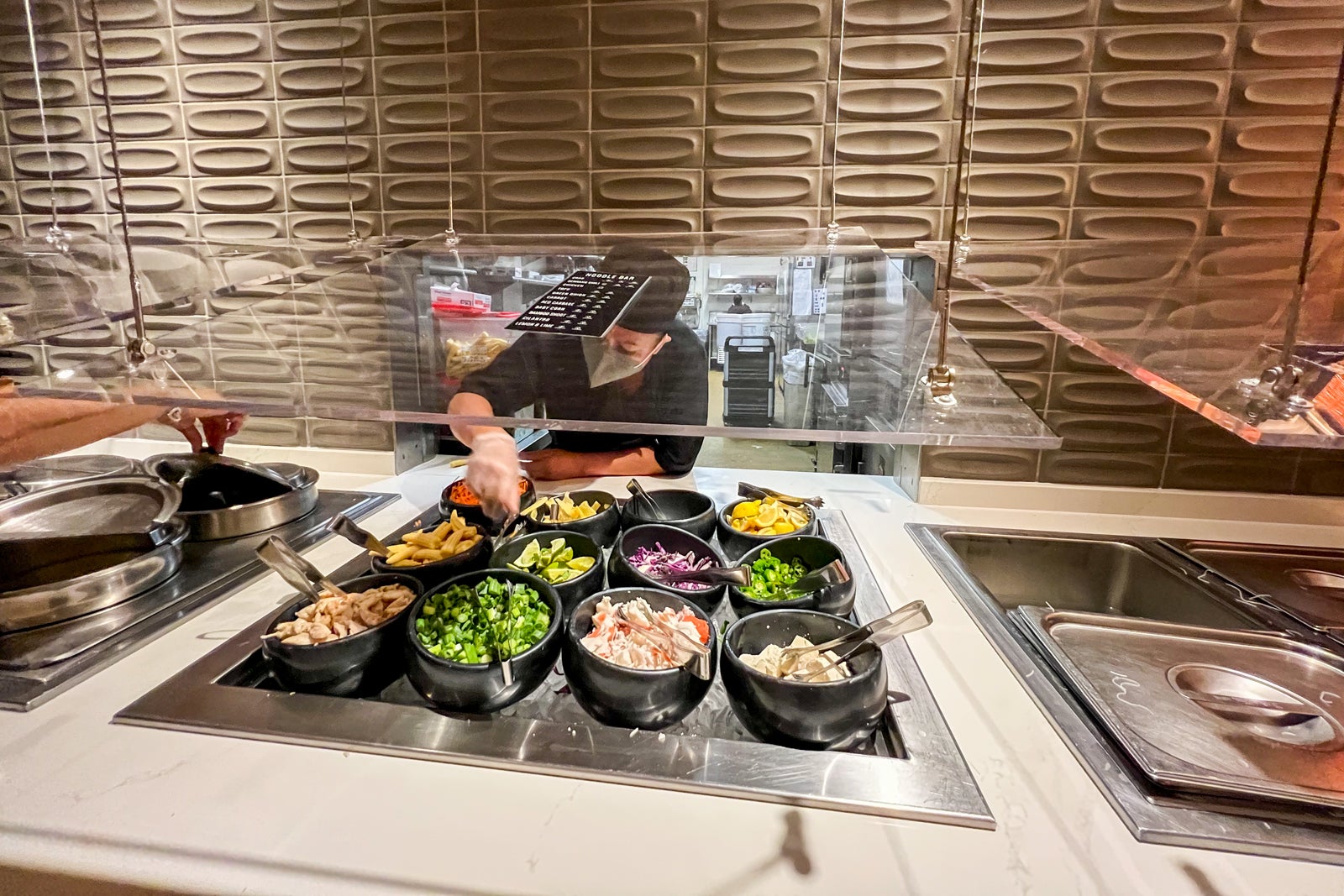
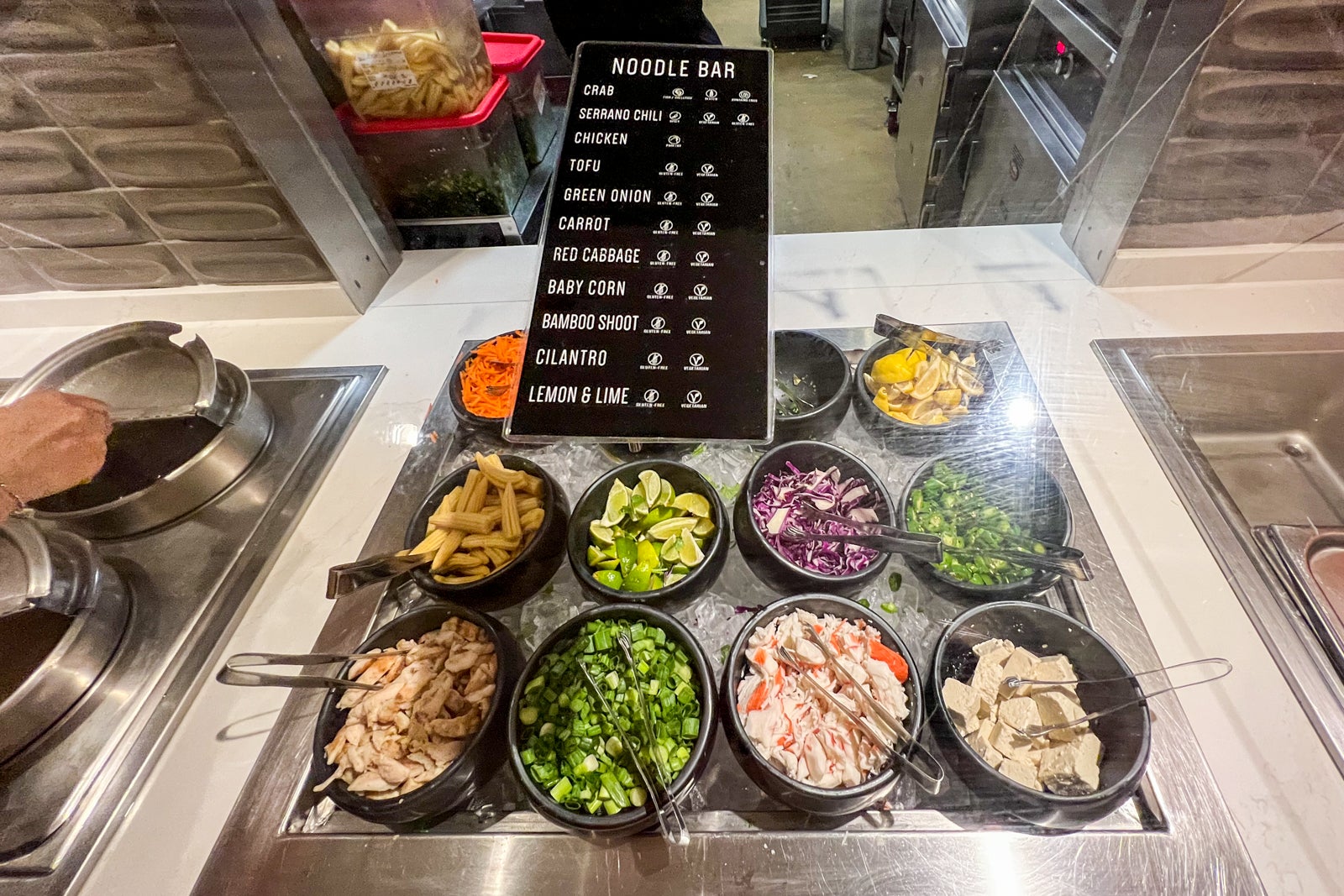
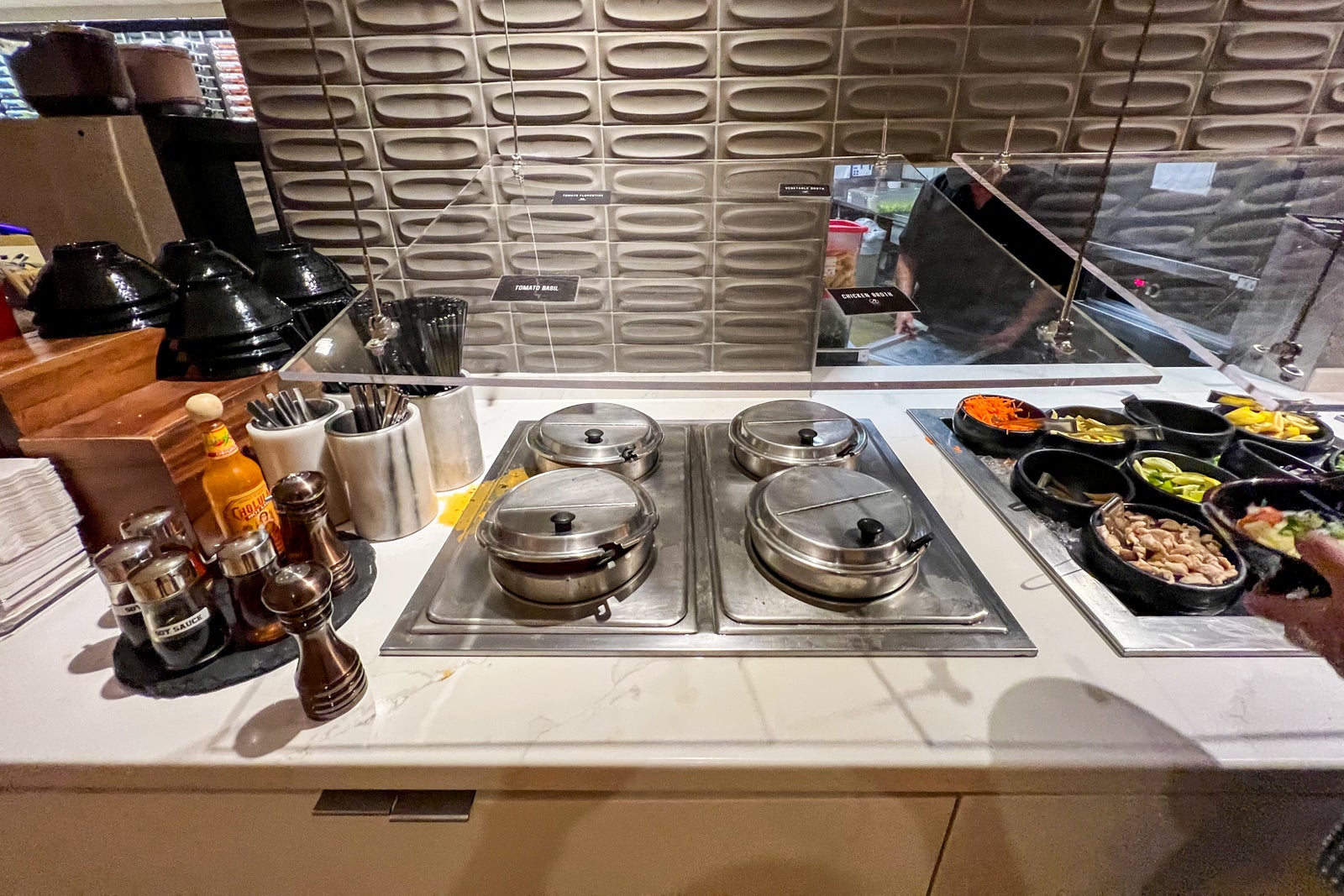
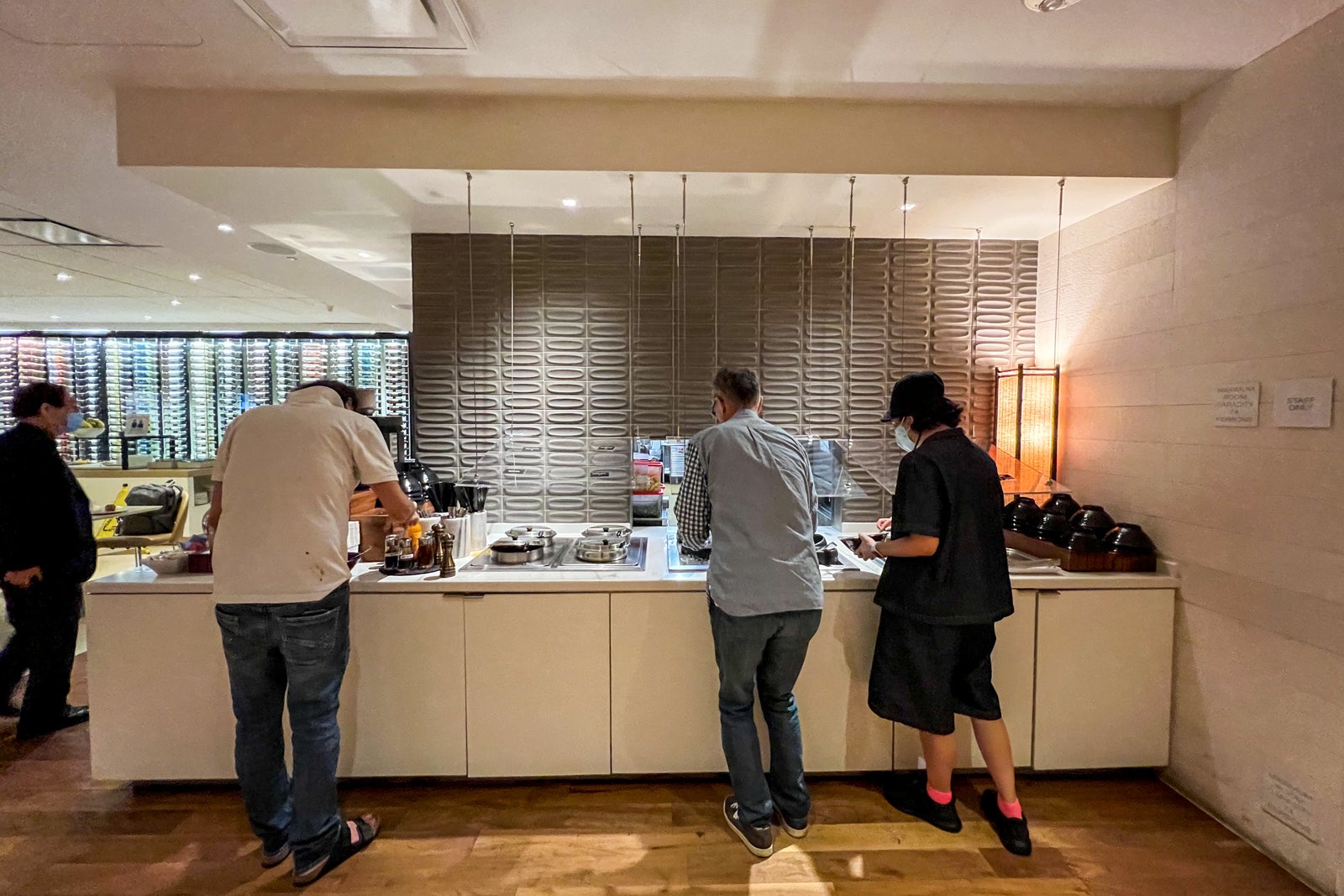
I anticipated a feast in store for me on my flight, so I just made myself a cappuccino at one of the self-serve machines and got a glass of sparkling water from one of the taps. Then I headed past the area with shower suites to my favorite area of the lounge, the outdoor terrace.
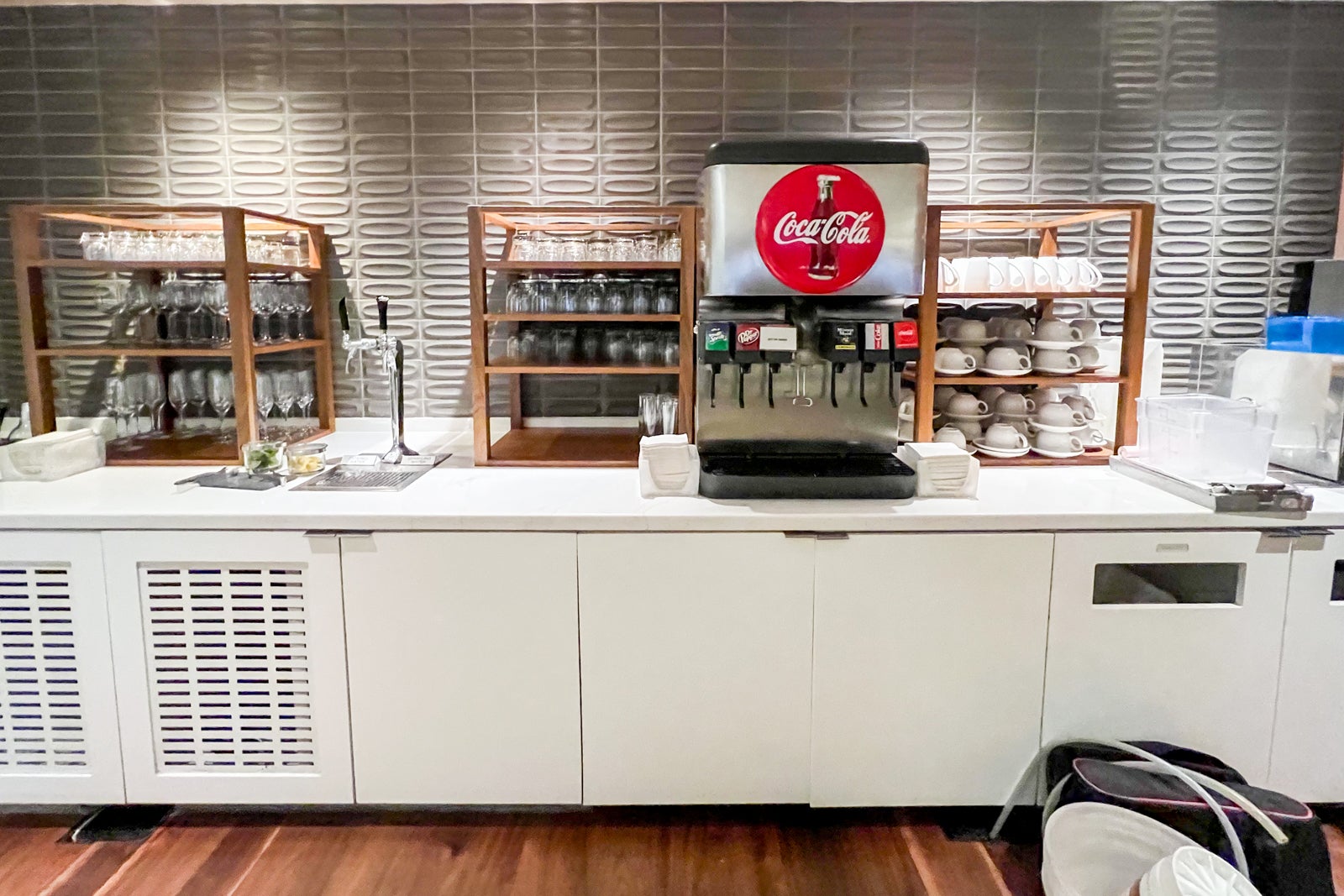
There were only a few other people out there that day, but the weather was sunny and warm and I spent a few minutes watching planes taxi across the tarmac before hunkering down to work thanks to the free Wi-Fi, which worked perfectly well out there.
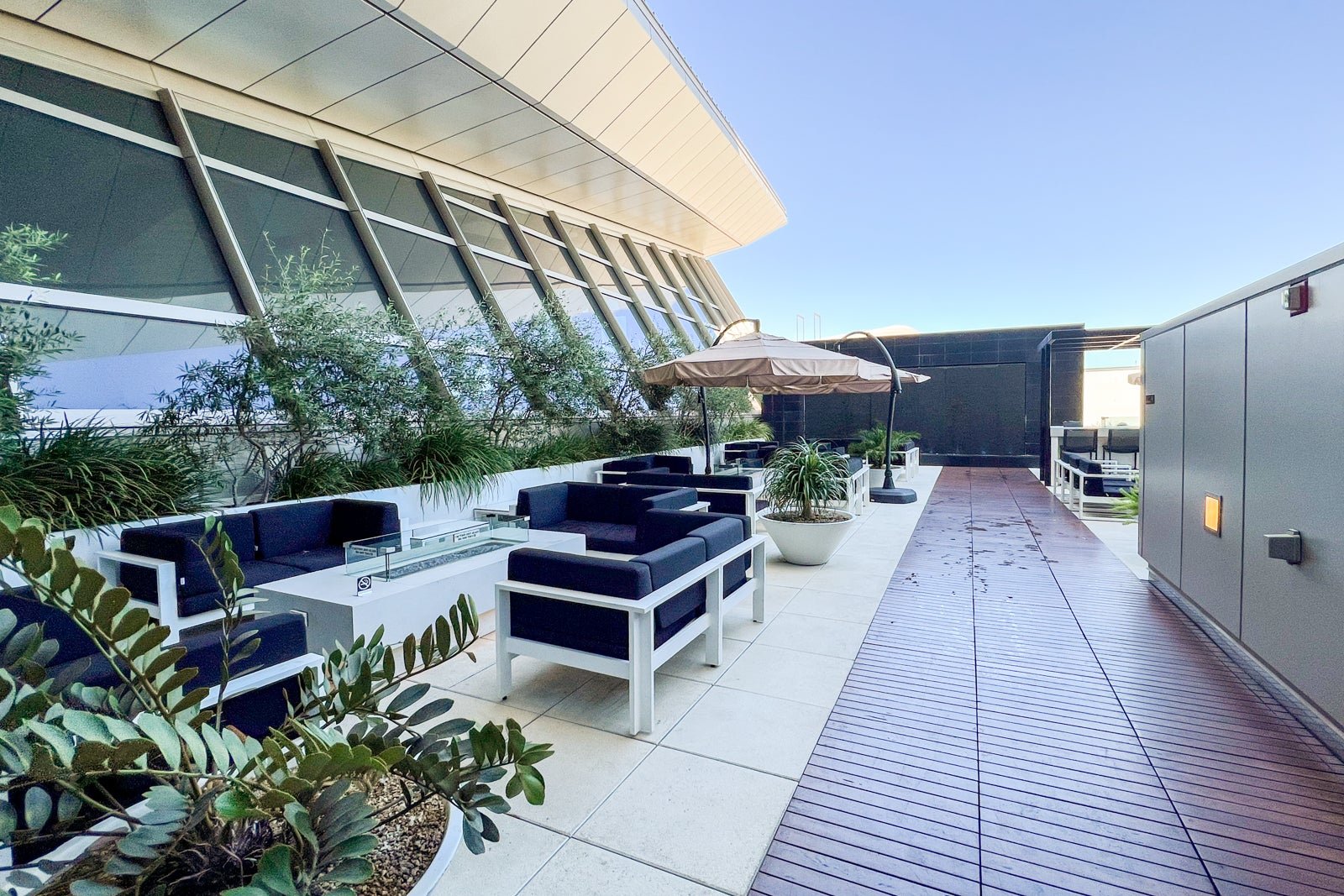
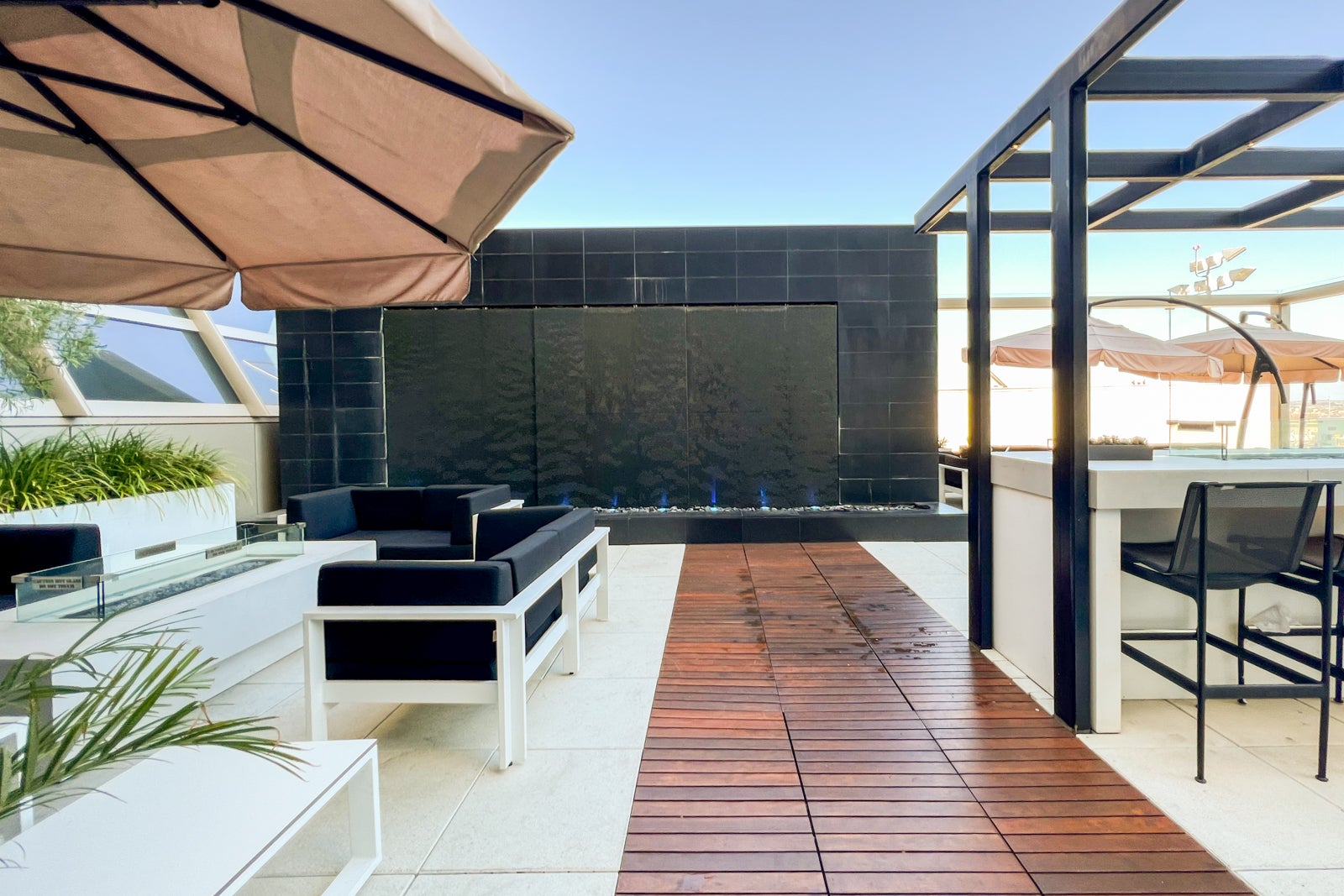
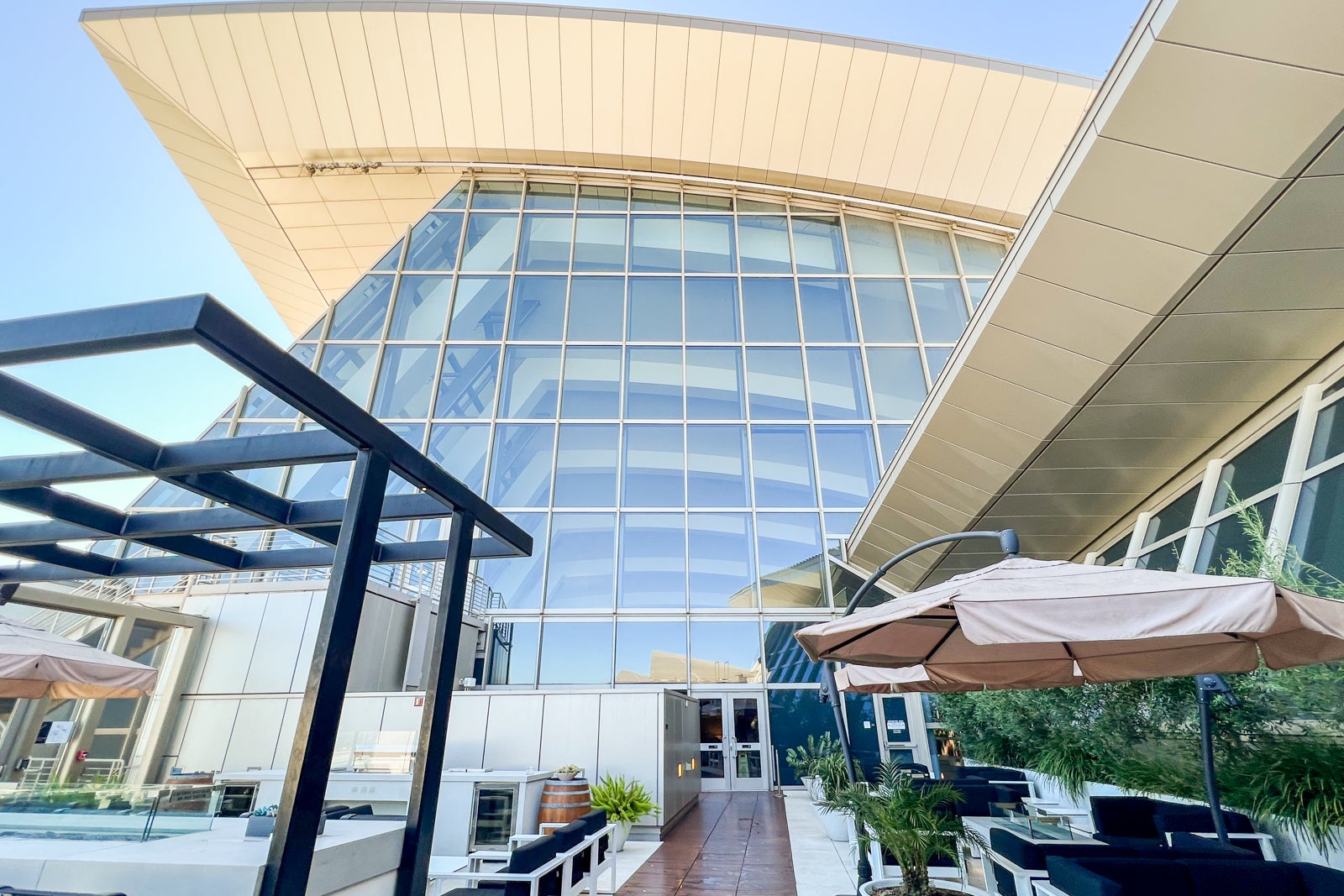
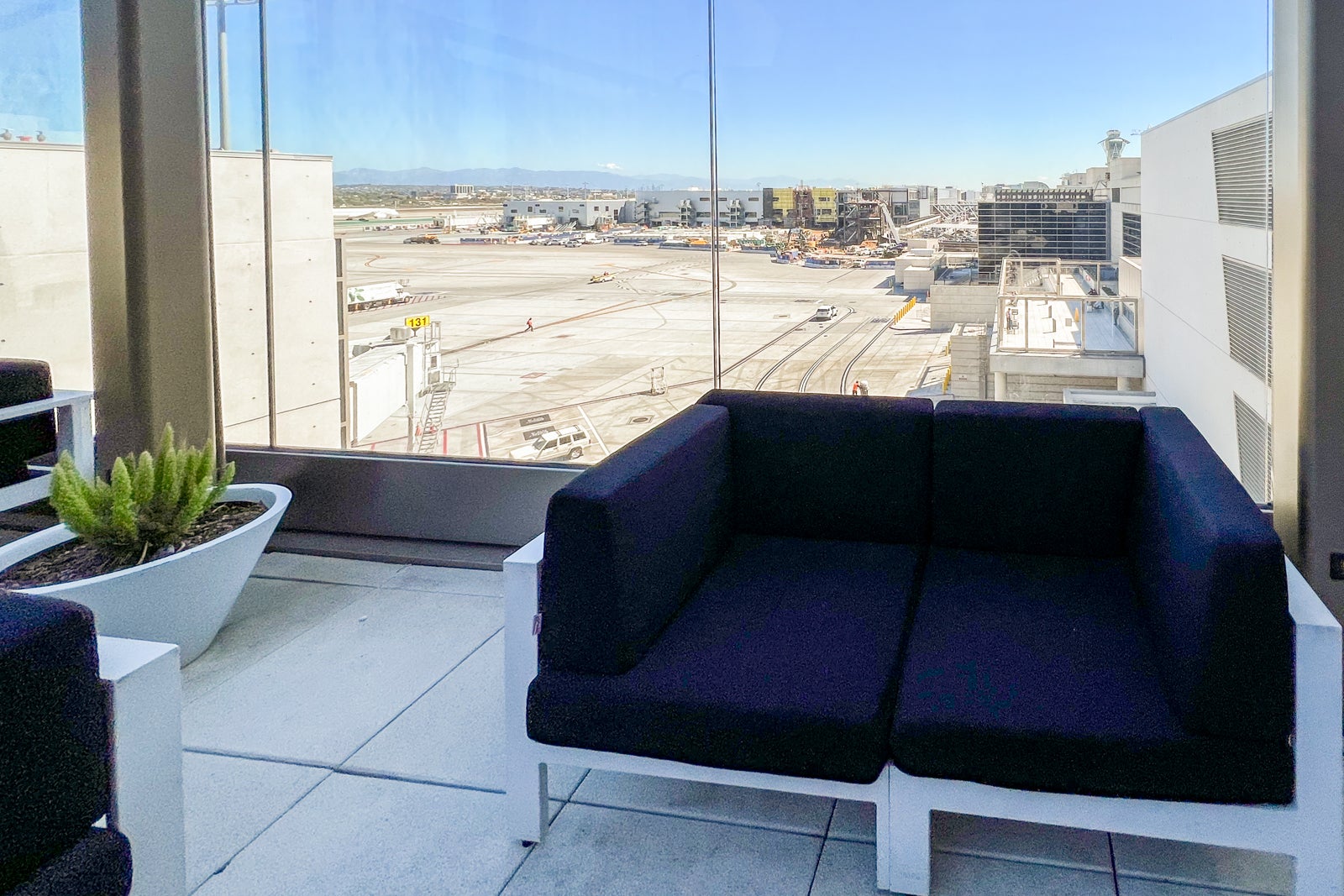
I left the lounge at around 11:45 a.m., an hour before departure and 30 minutes before boarding was set to begin, because I wanted to try to get on the plane before most passengers in order to get some pictures and video.
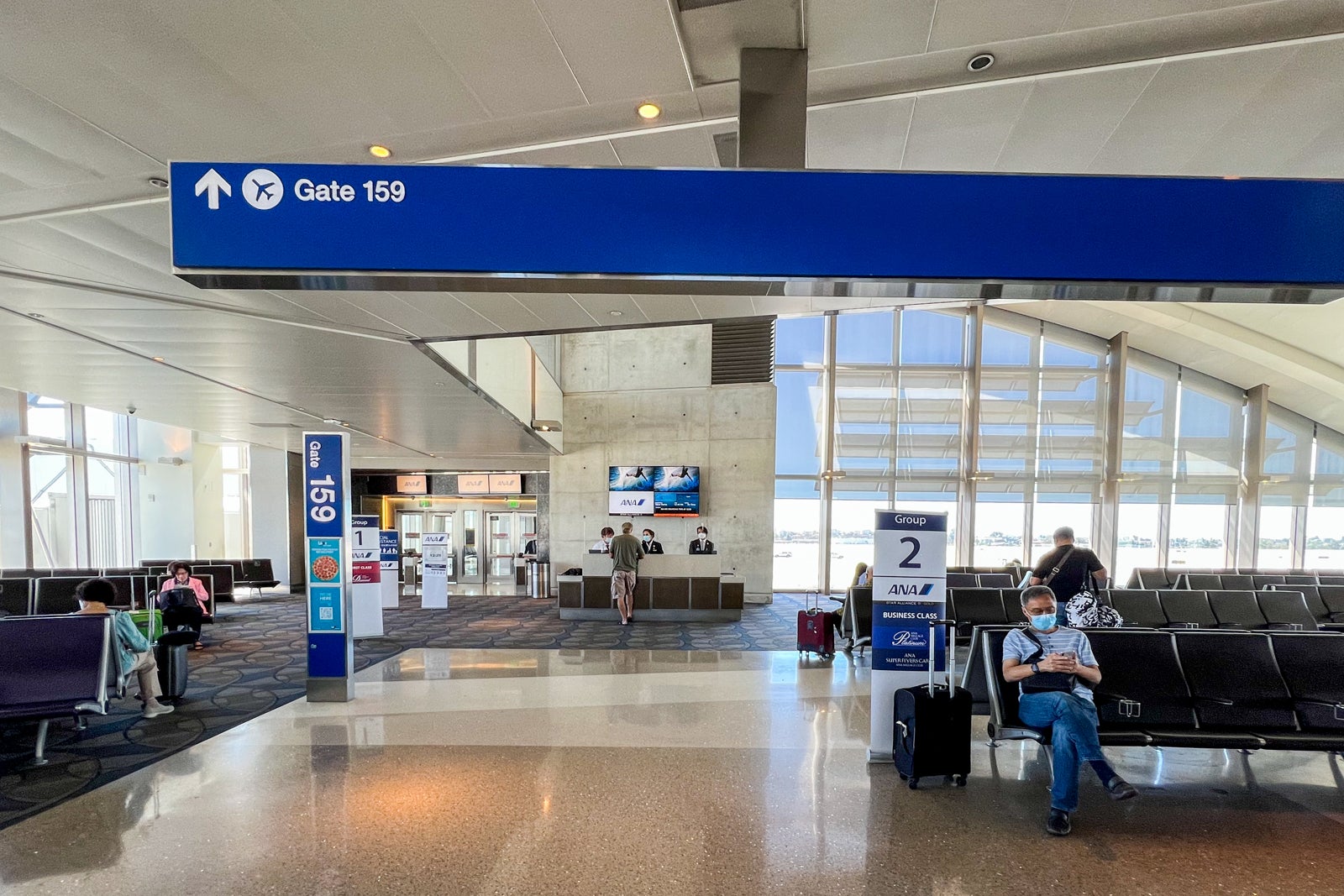
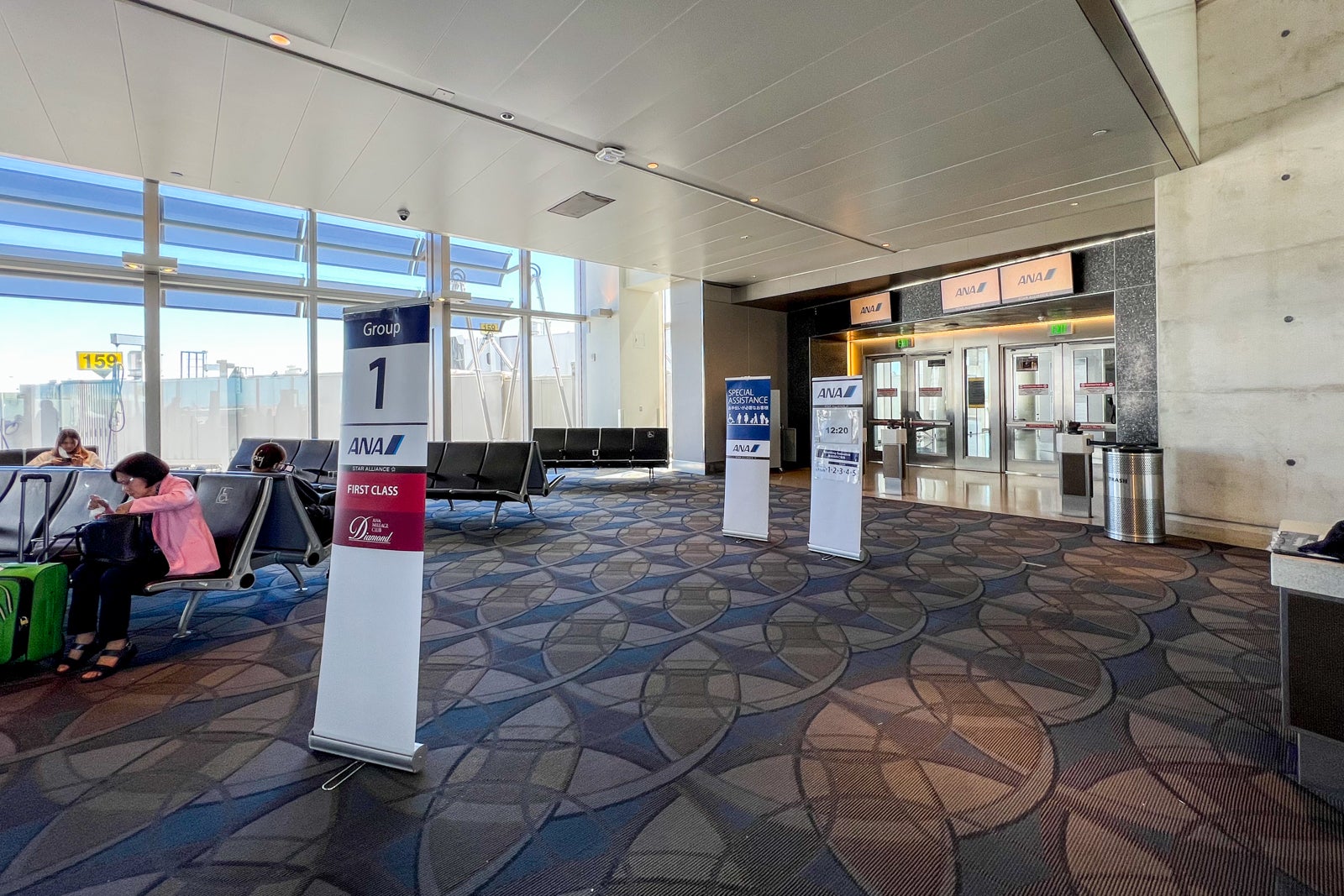
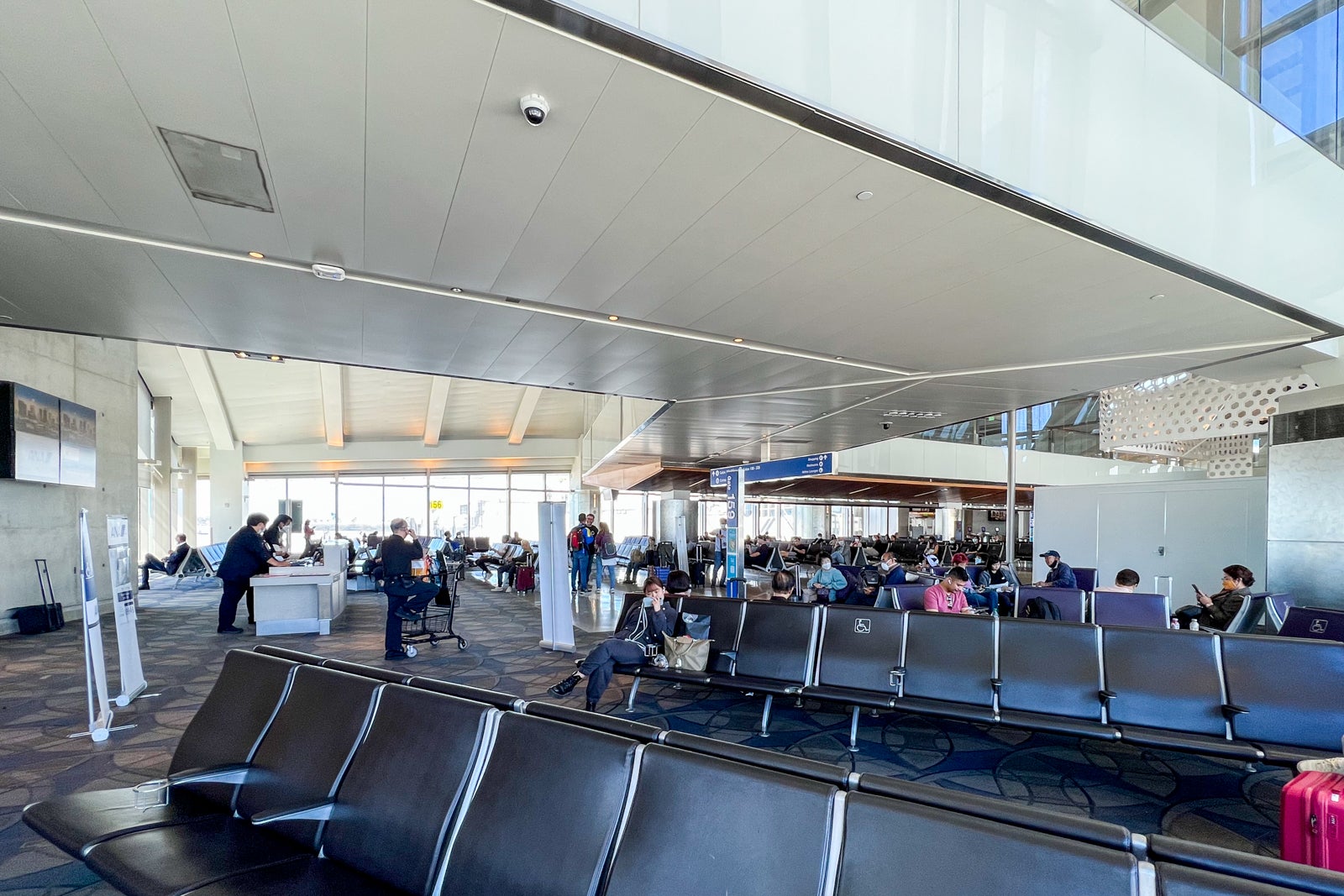
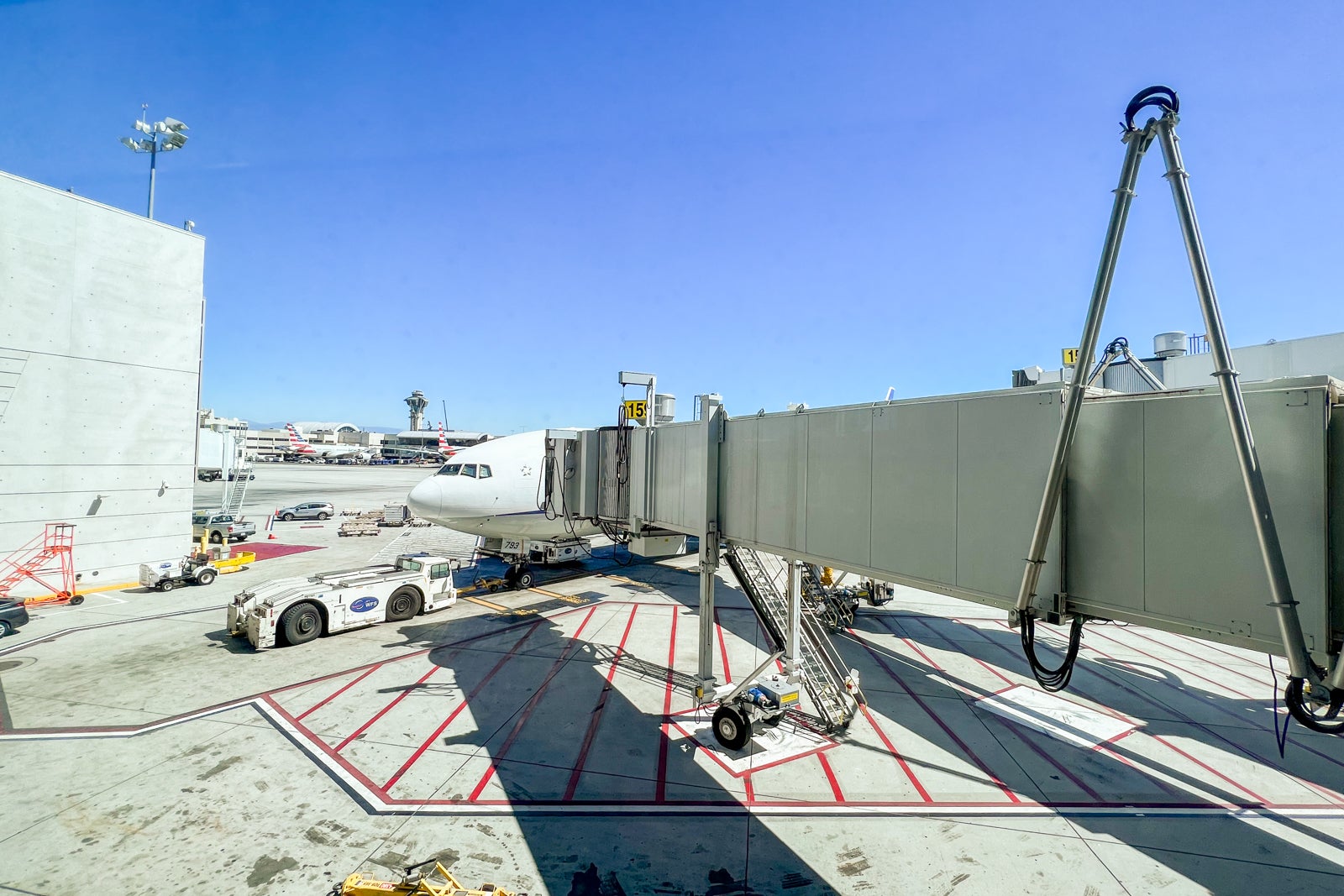
The gate was at the far southern end of the terminal, so it was a brisk eight-minute walk (not counting some diversions to snap photos of other planes at their gates). When I arrived, only a few other passengers were seated in the area, and I ended up being the first to get on the plane at the start of boarding.
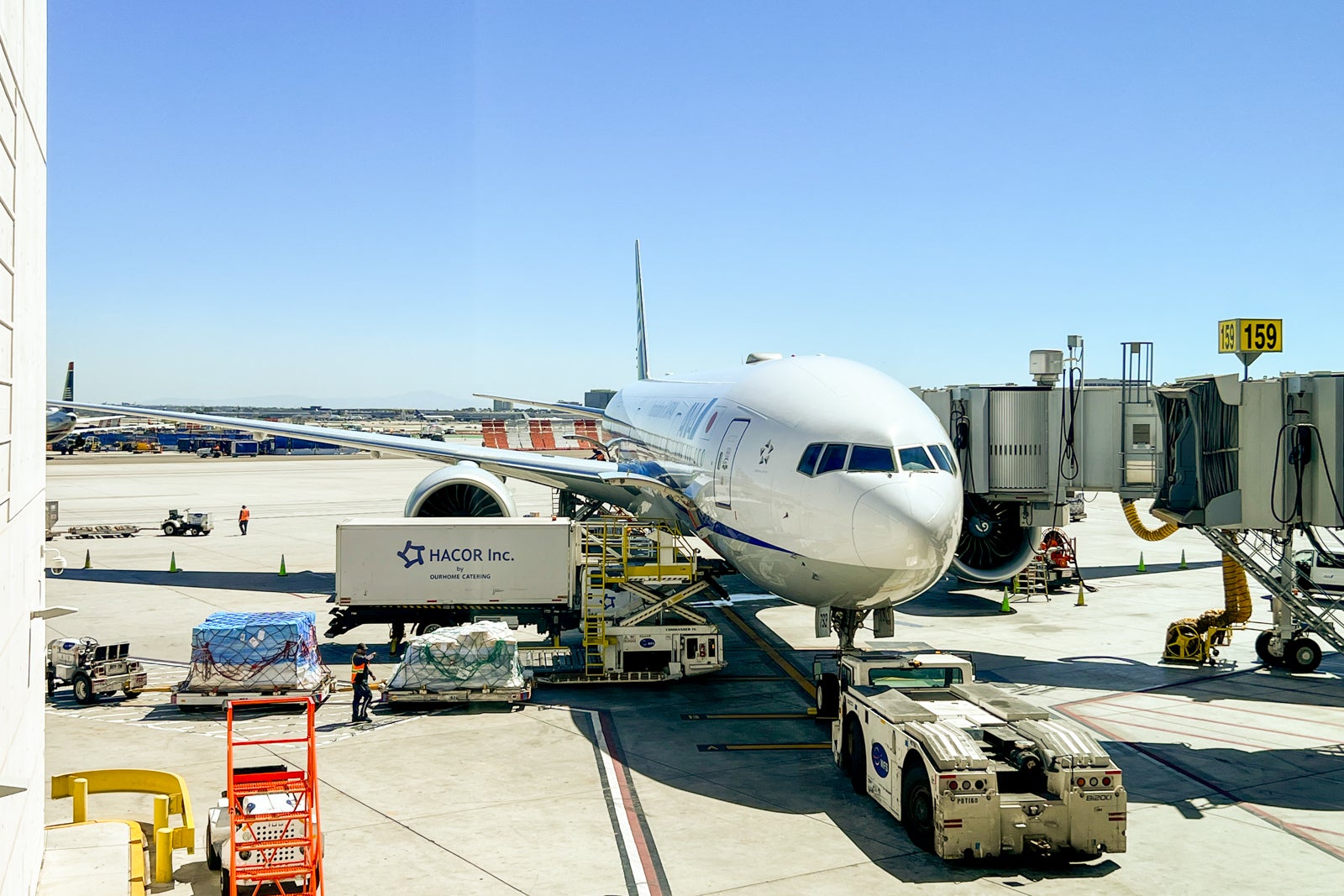
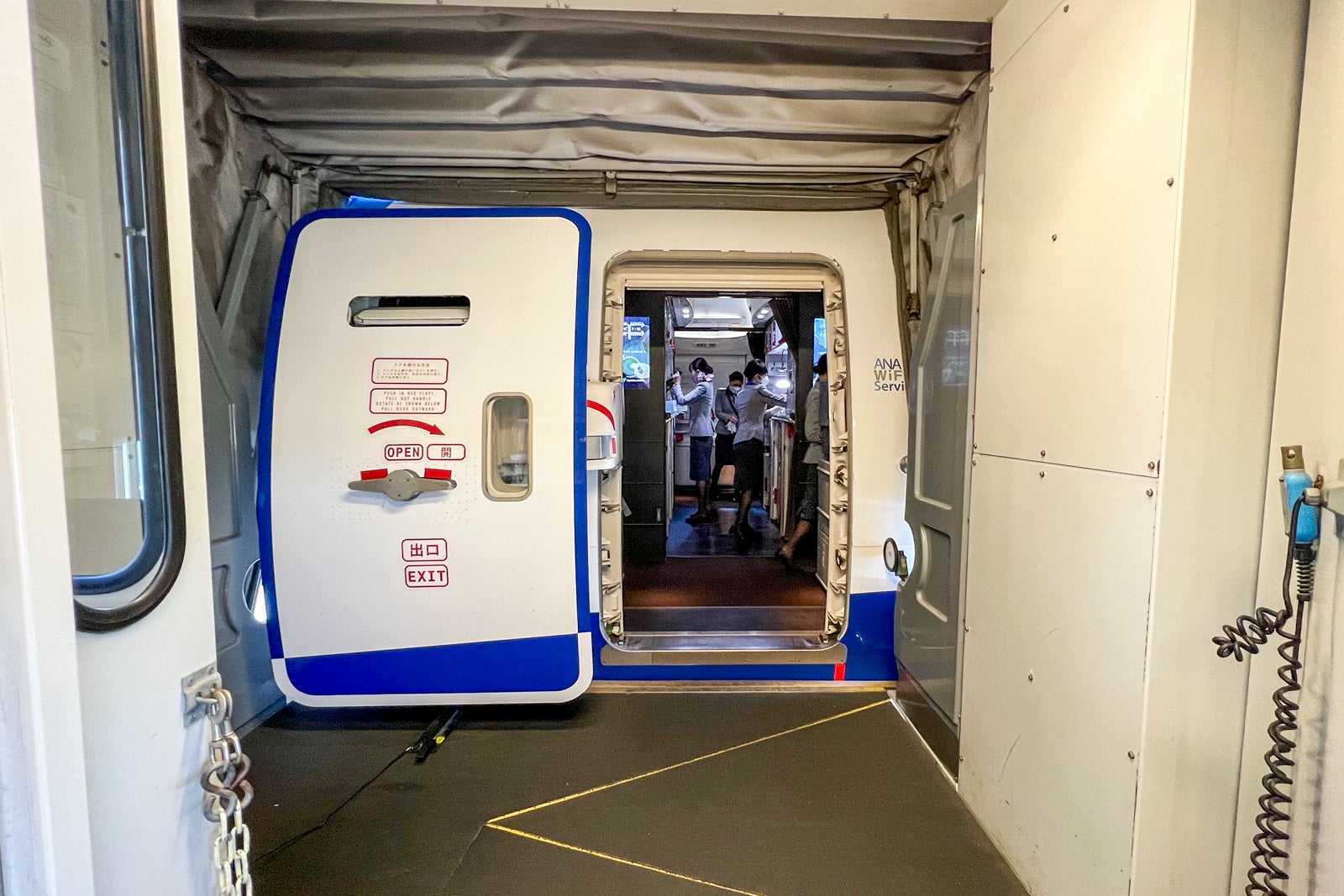
Cabin and seat
ANA’s 777-300ERs with the new first- and business-class suites are configured in an interesting way, with the business-class cabin split into three separate sections.
Moving from the front of the plane to the back, there is a small, first-class cabin with two rows of The Suite configured in a 1-2-1 arrangement for a total of just eight seats. These were positively palatial, with tons of personal space, and I was momentarily sad that I hadn’t been able to snag an award in one of them instead.
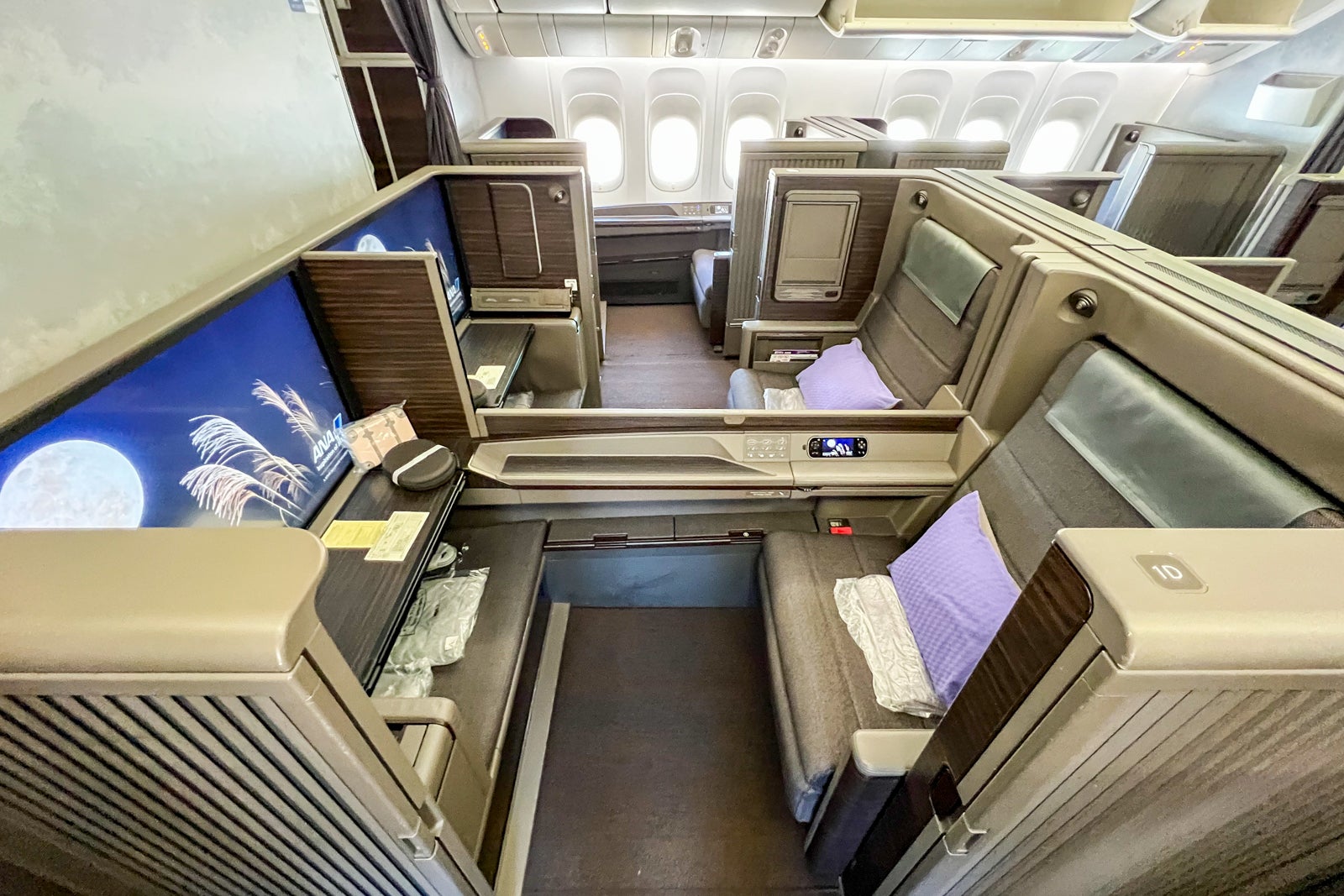
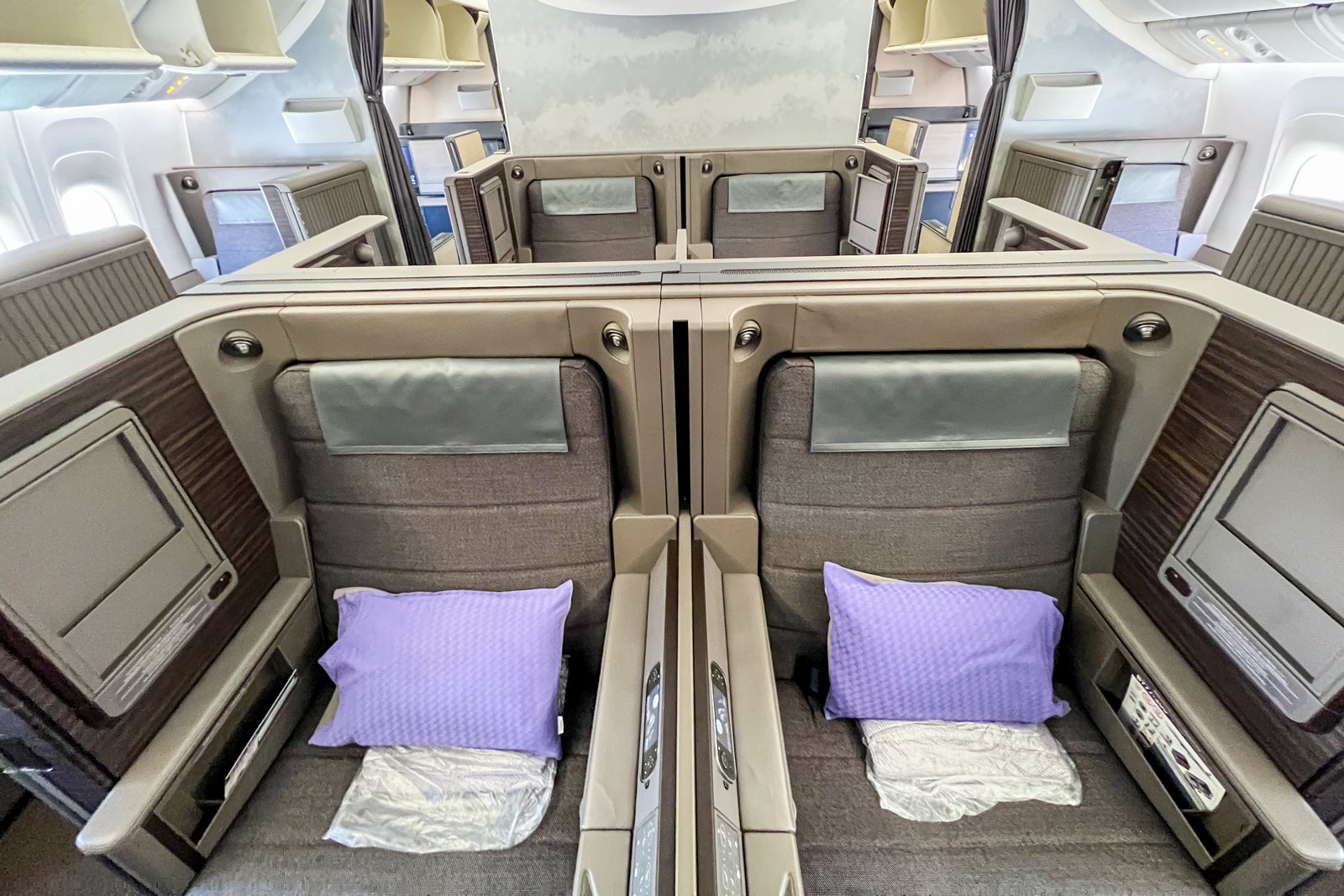
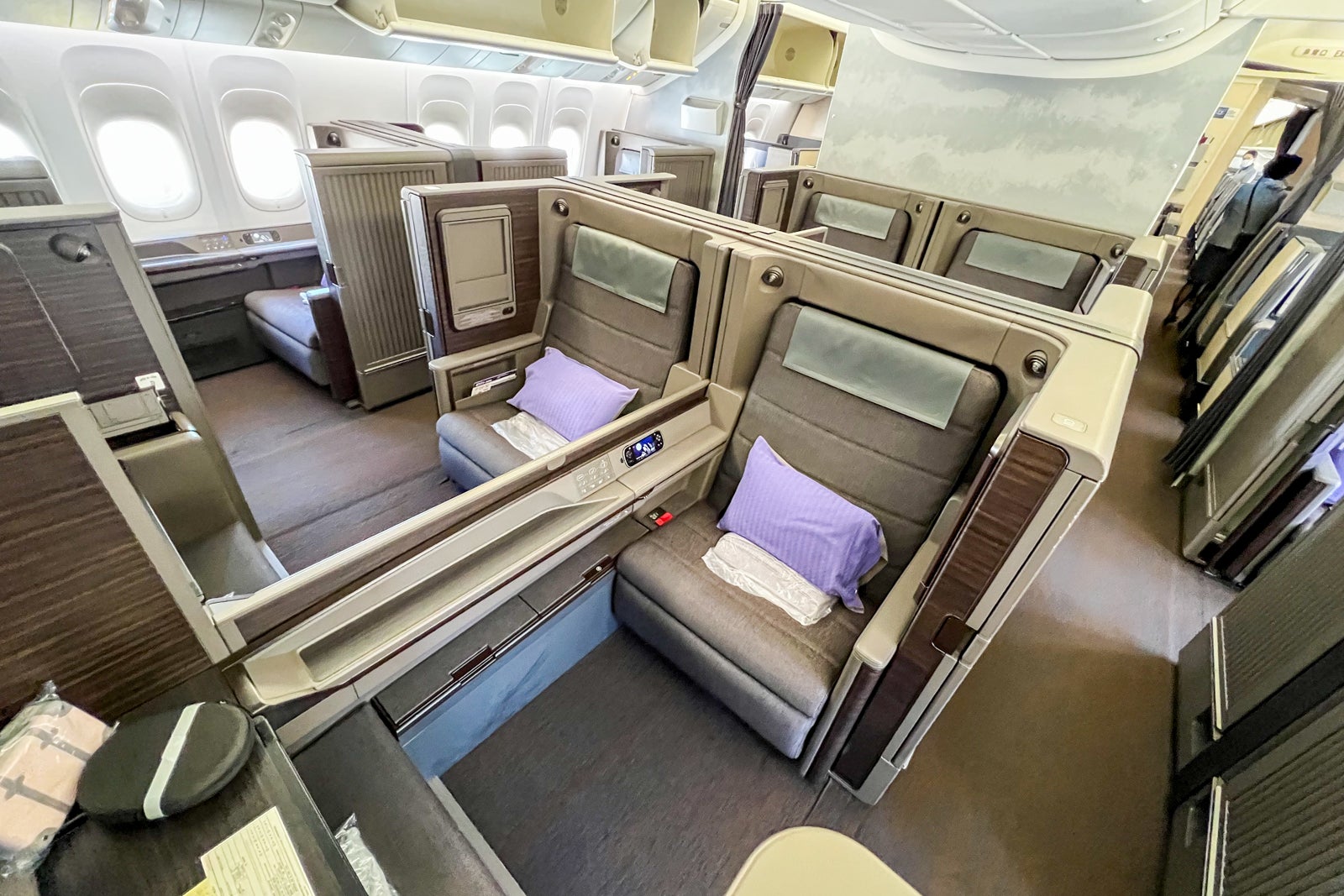
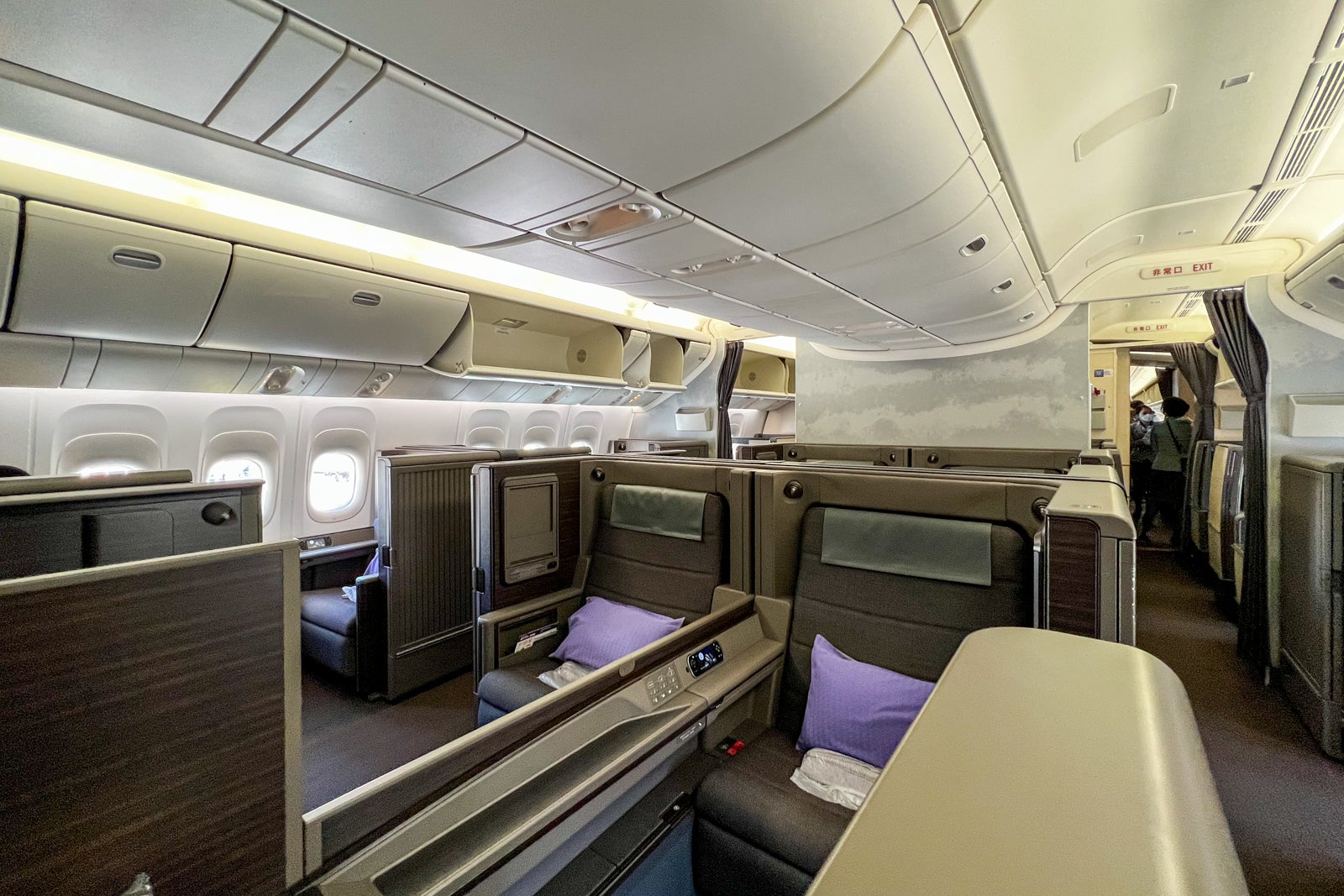
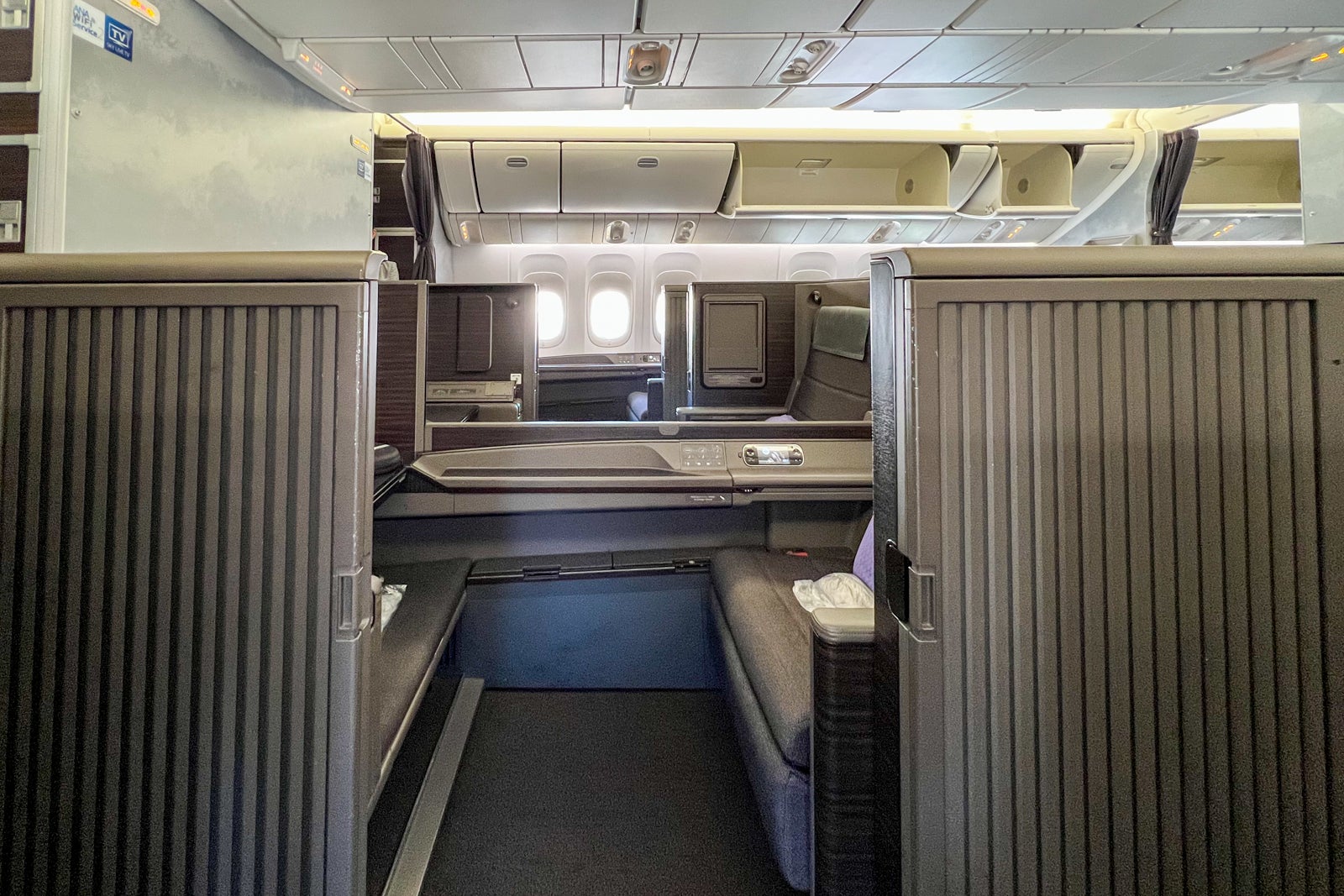
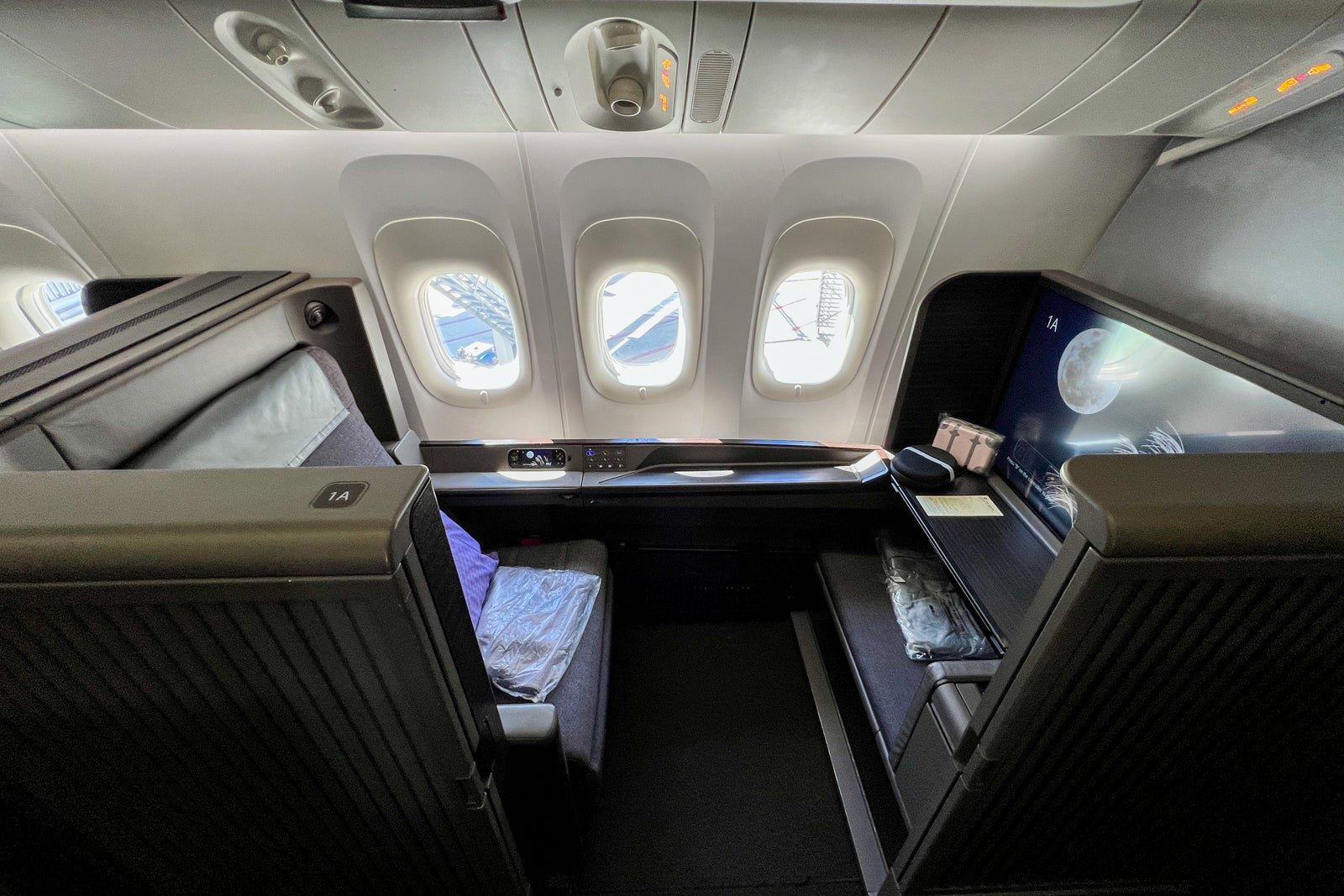
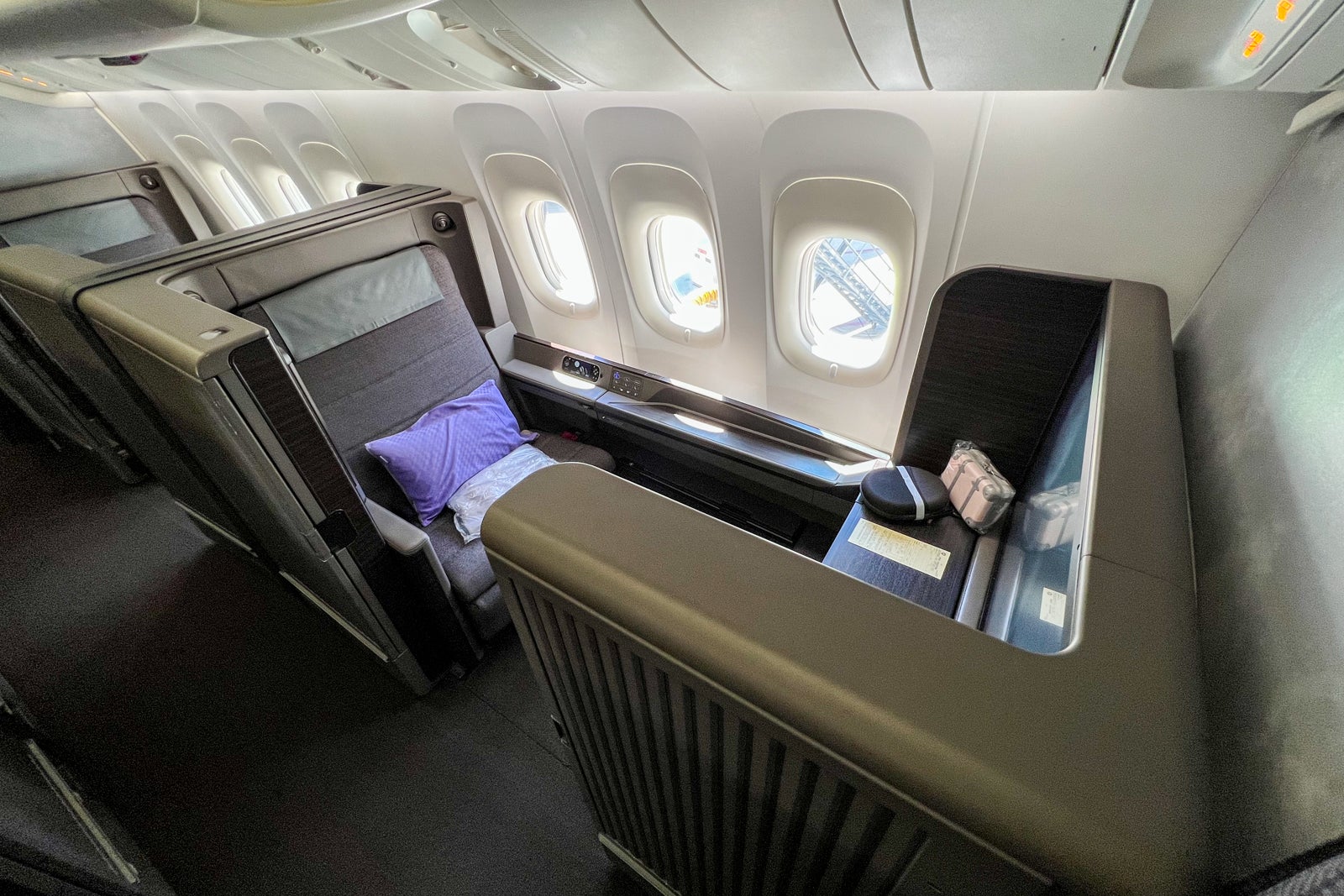
Directly behind that and separated from first class by a curtain is a mini business-class cabin with two rows of The Room arranged in a 1-2-1 pattern.
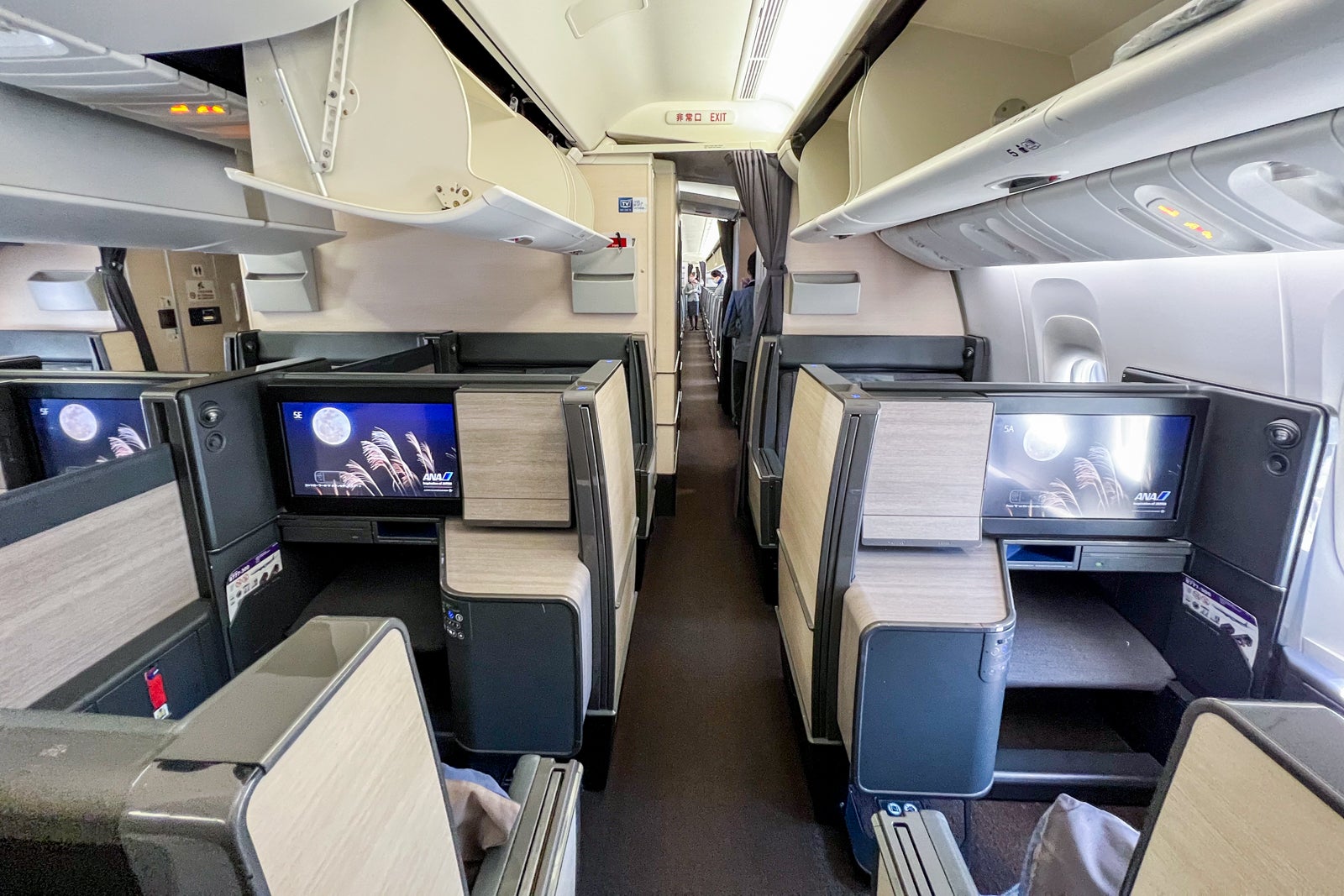
Then, past the boarding door, galley area and two lavatories is the main business-class section, with 10 rows of The Room suites.
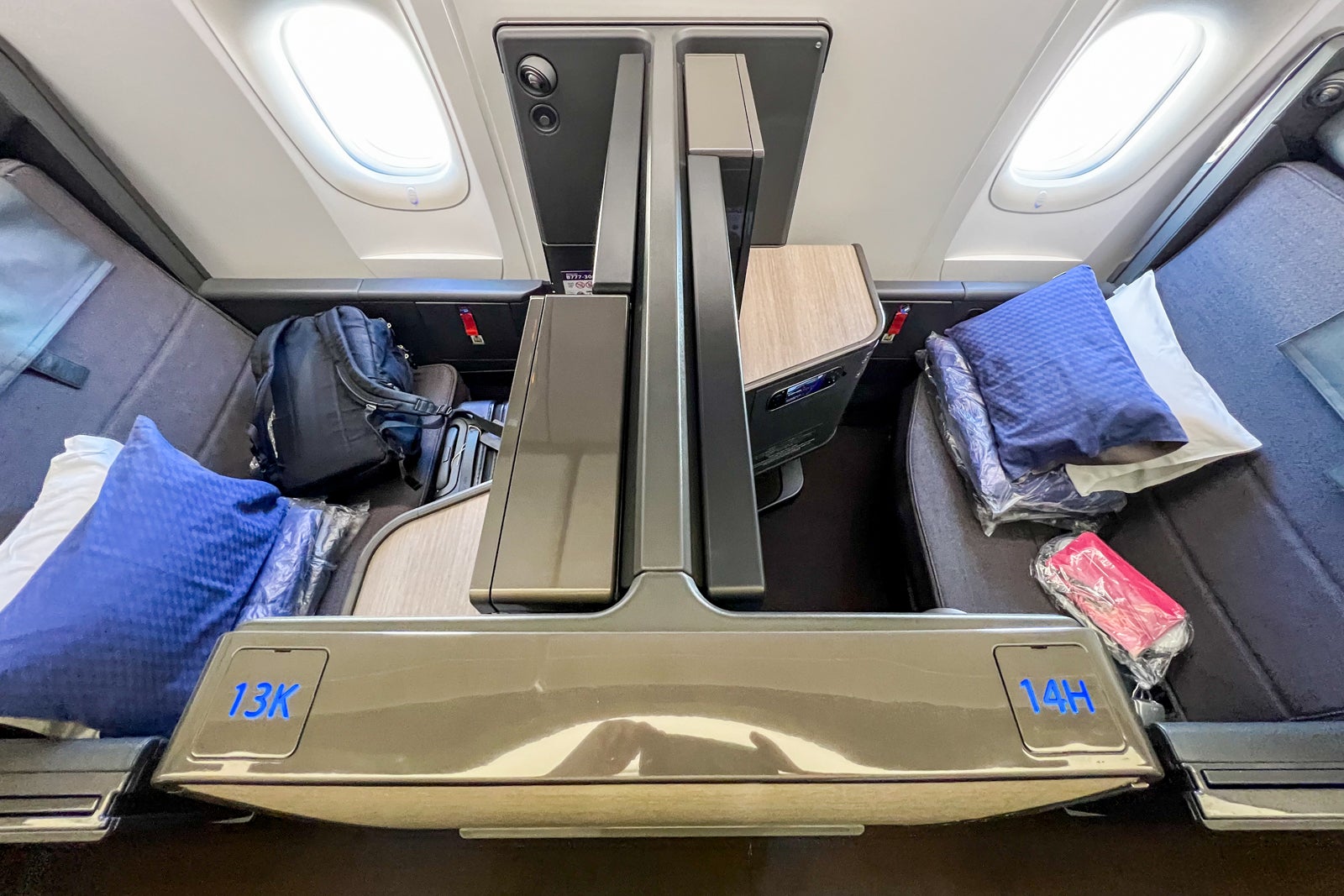
There is another small galley area with two lavatories and a final mini cabin with four rows of The Room, bringing the total seat count to 64.
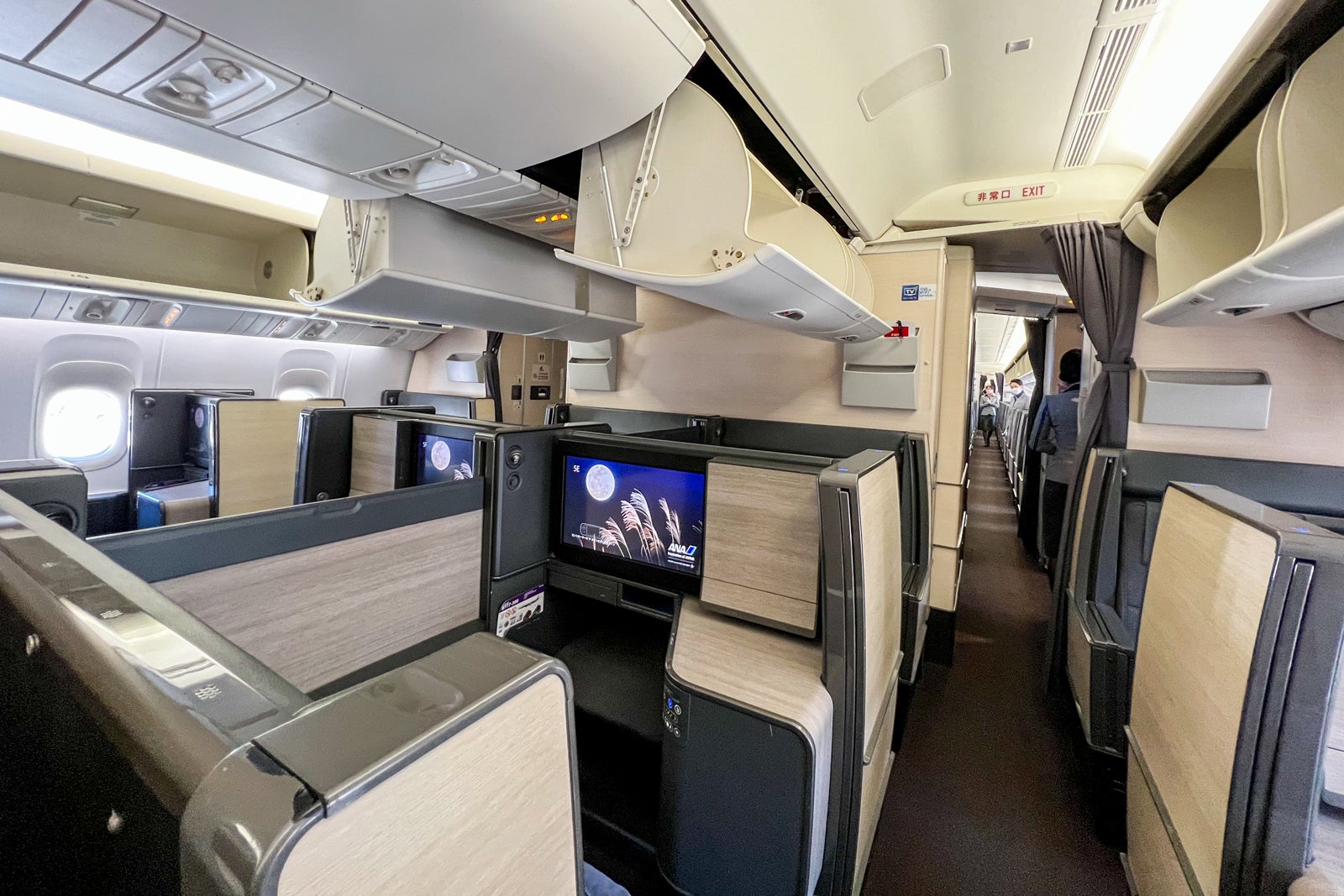
Past a set of curtains, passengers will find the relatively small premium economy cabin, with just three rows of seats laid out in a 2-4-2 configuration.
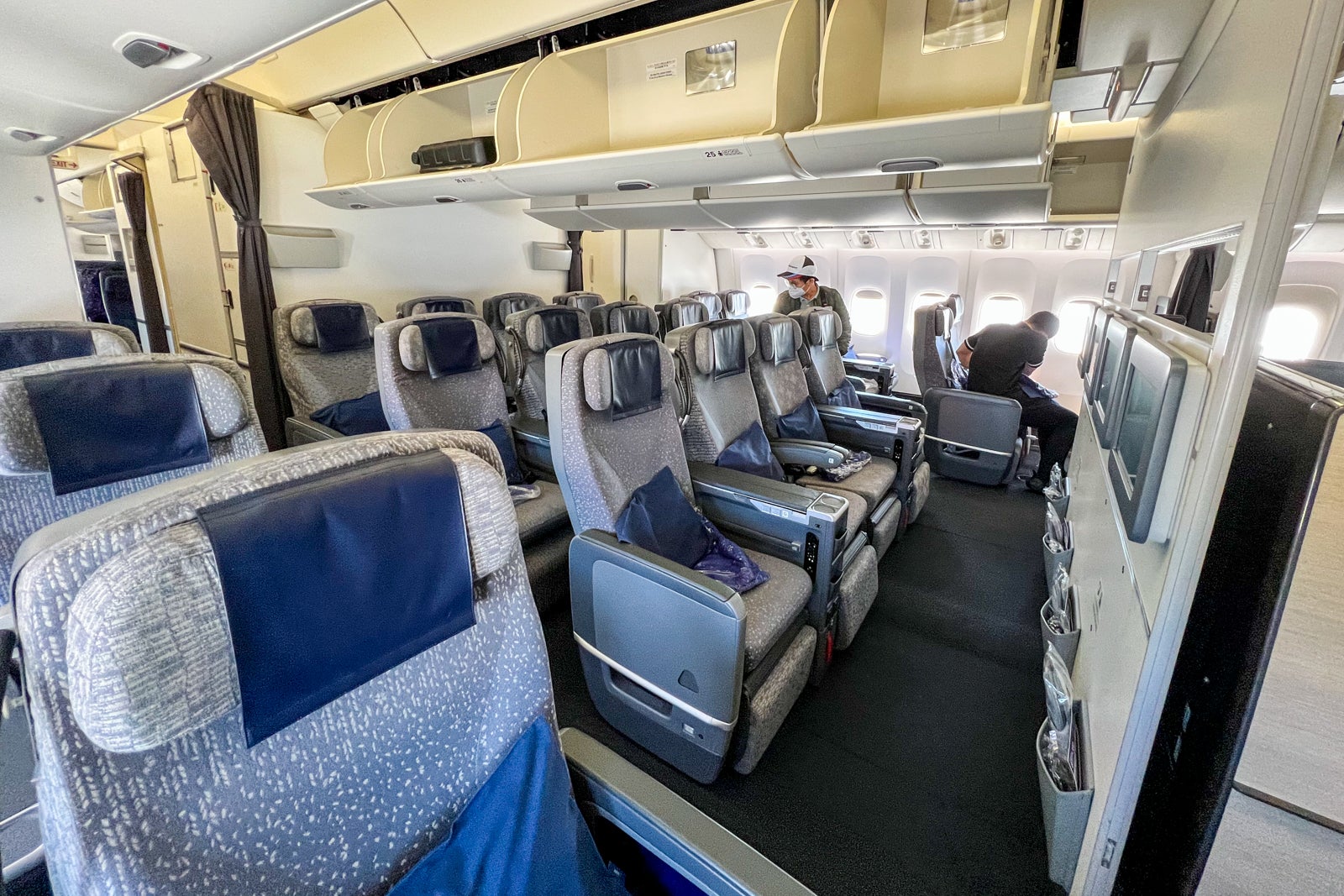
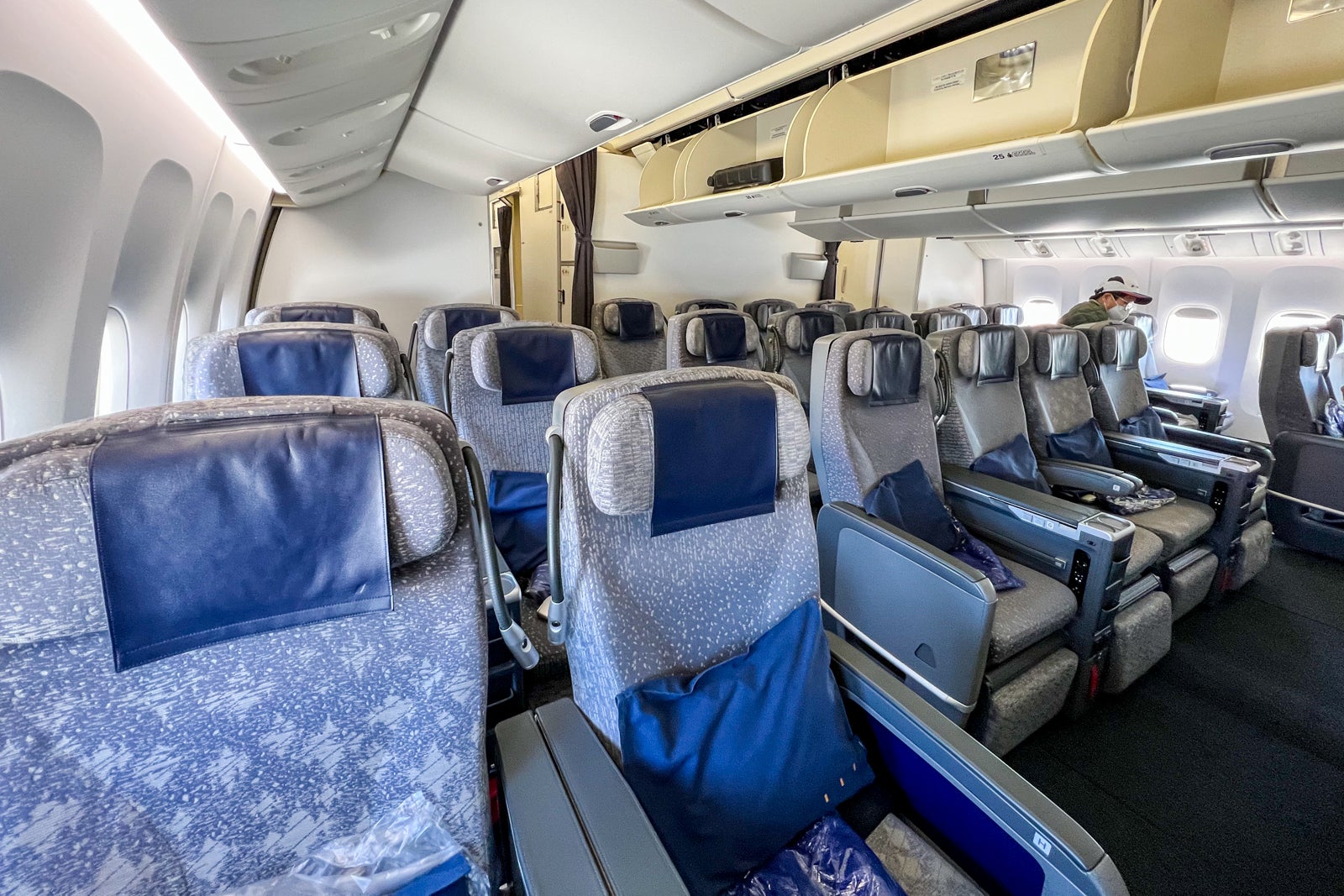
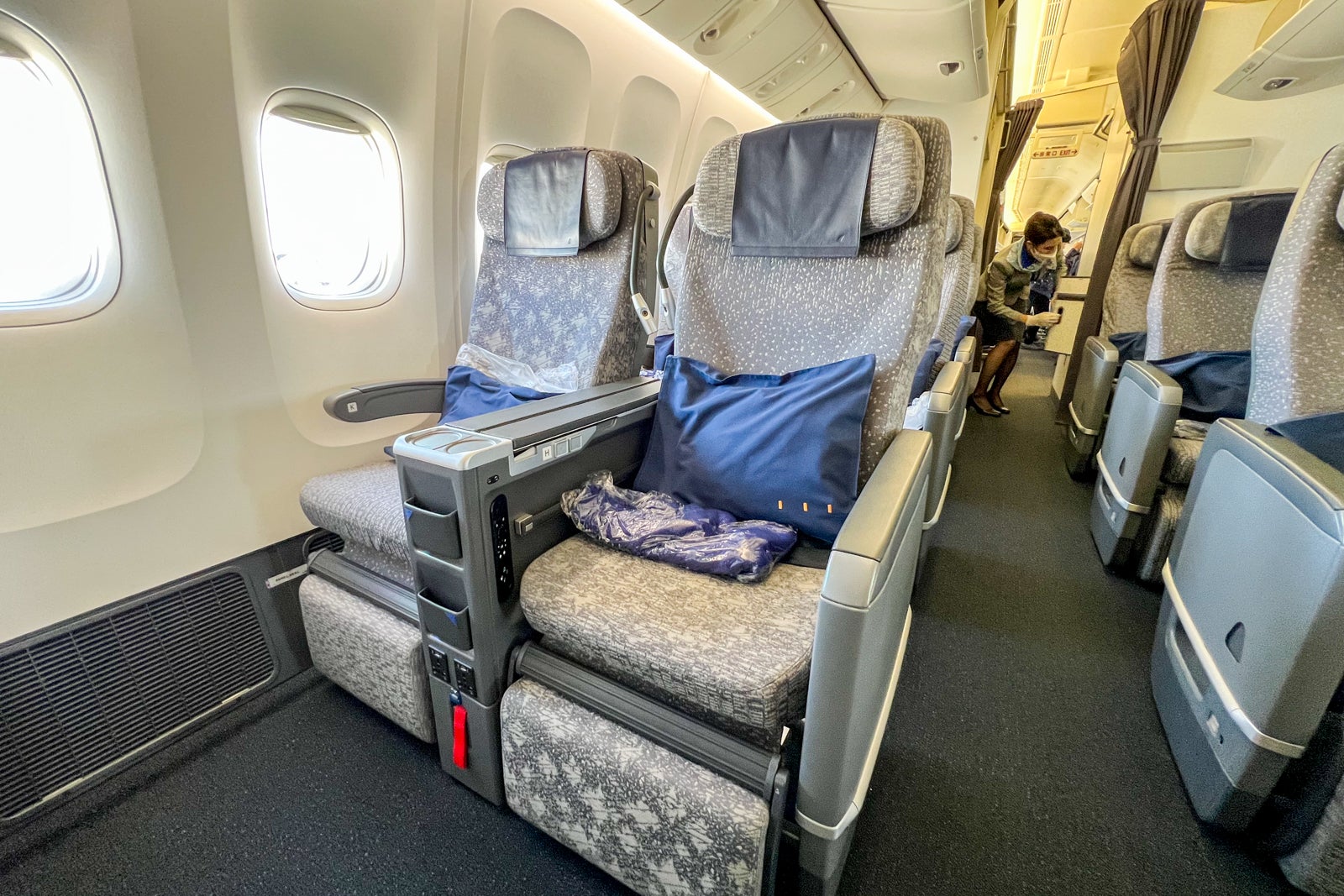
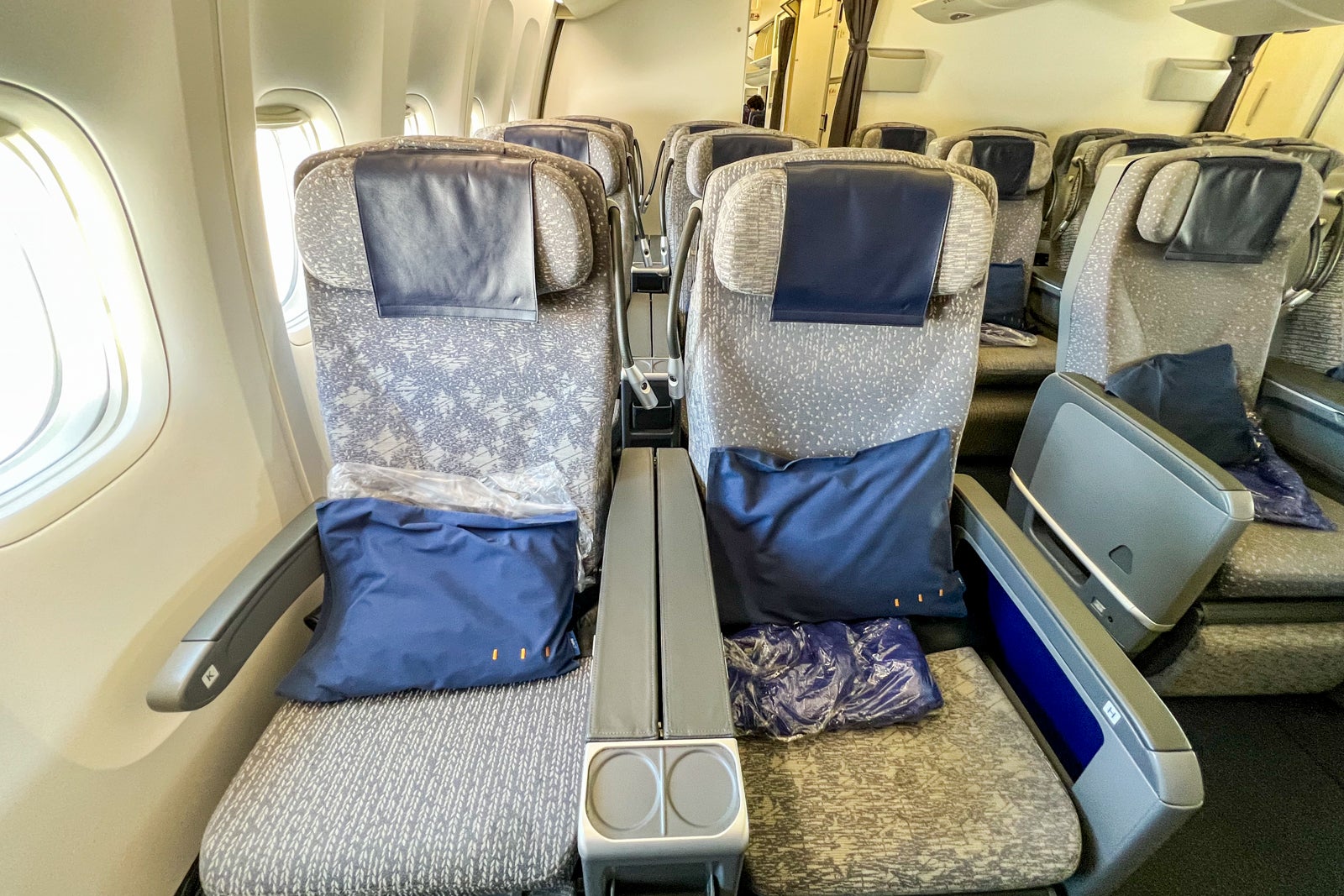
Finally, there is another large galley area and a lavatory with the economy section behind that. Most rows are in a 3-4-3 layout, with some toward the back narrowing to 2-4-2 due to the shape of the aircraft.
All passengers boarded through the second door and passed through the main business-class cabin as well as the smaller one to the aft, then premium economy. So if you’re looking for privacy in business class, try to get a seat assignment in the ultra-private mini-cabin up front in rows 5 or 6.
Like Qatar Airways’ Qsuite, The Room is arranged where rows alternately face backward or forward. The A and K seats along the sides of the cabin face backward and are separated from the aisle by a large console and — of course — those sliding panels for privacy (more on those in a moment). The C and H seats along the sides face forward and have a narrow armrest on the aisle with the wider console next to the window.
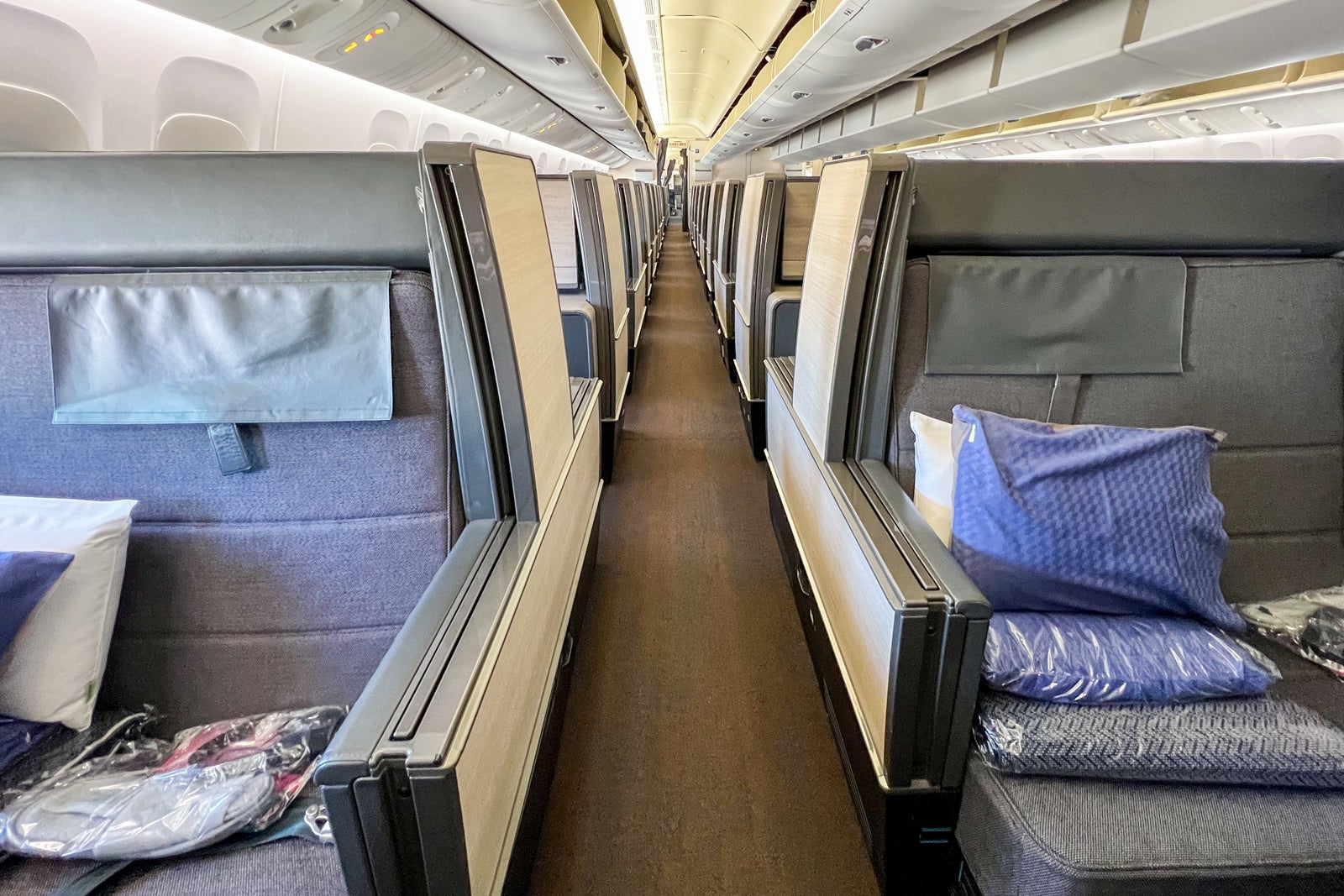
Running through the center of the cabin, seats designated E and F face backward and are closer to one another, with large consoles on their aisle sides, so they’re probably best for friends or couples traveling together, though they do have privacy screens that can be raised between them.
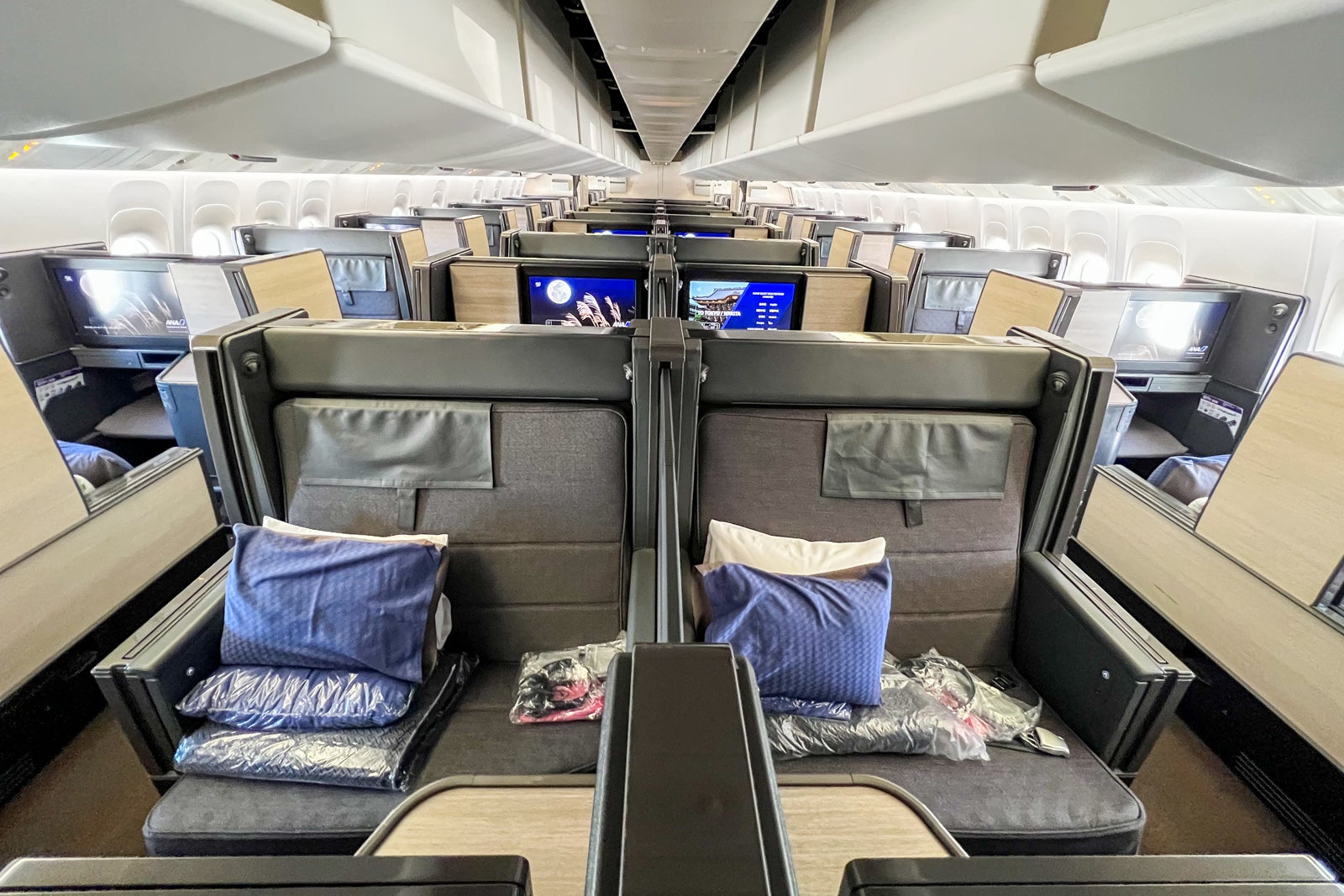
The D and G seats face forward and are spaced farther apart from one another thanks to their large consoles abutting one another. Unlike with Qsuites, you can’t combine certain blocs of four center seats into a type of mega-suite.
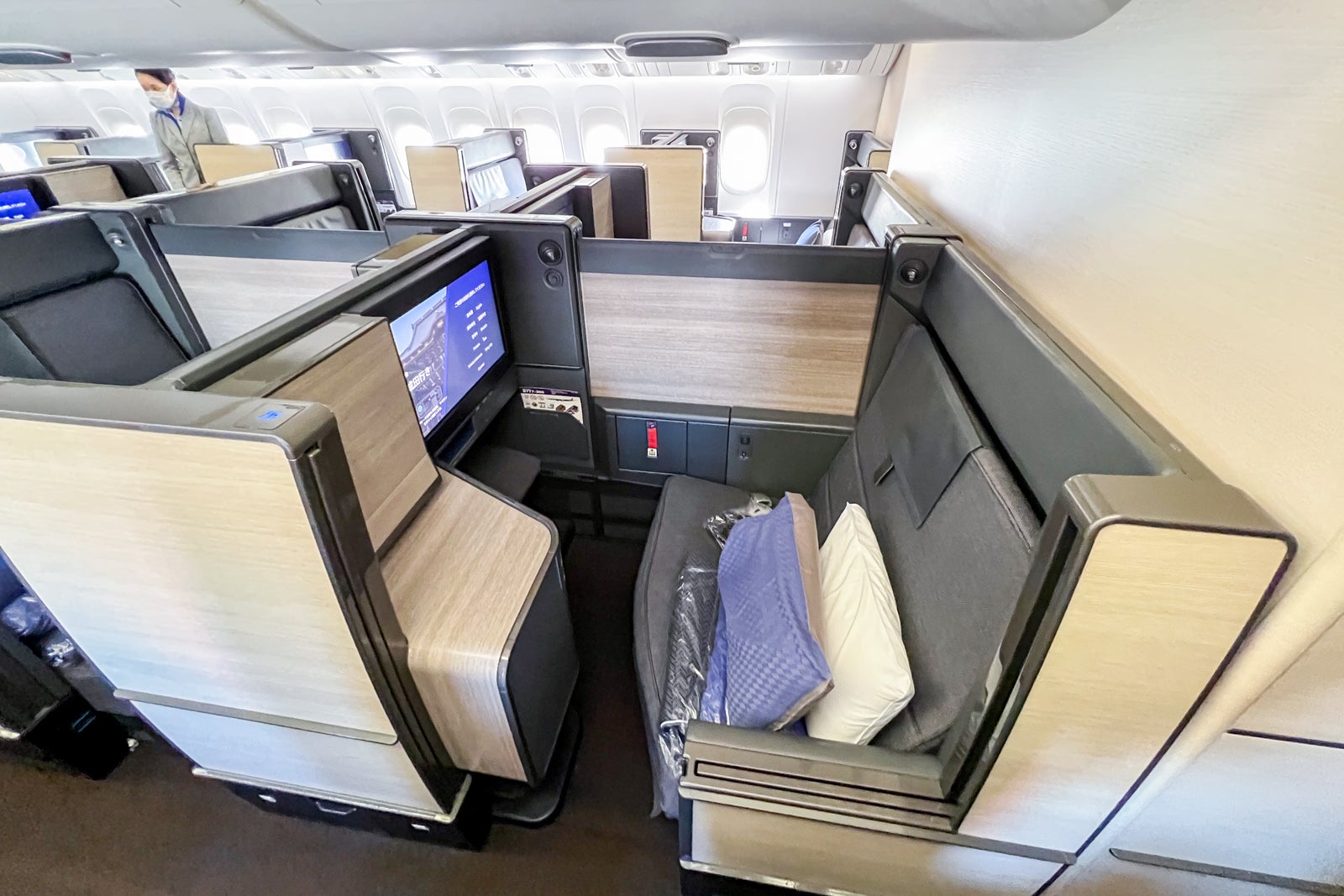
The design for The Room (as well as The Suite) comes courtesy of Acumen, the seat manufacturer behind such other products as United Polaris, though The Room is in an entirely different league.
Each The Room seat measures a whopping 38 inches between the armrest. In other words, they don’t just look like doublewides, they literally are (at least) double as wide as most economy seats out there. They feel a little like Cathay Pacific’s much-loved first-class seats thanks to those dimensions.
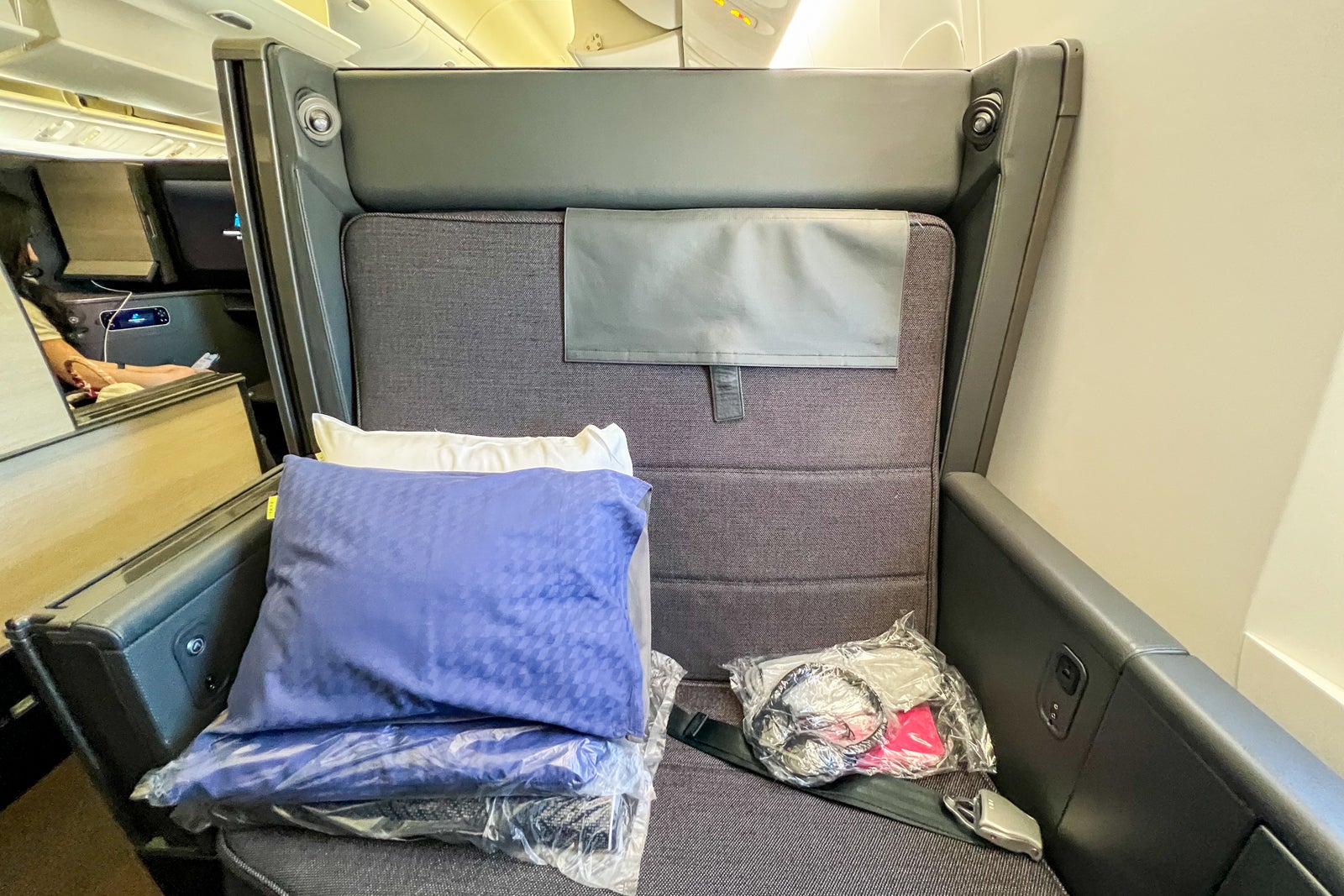
Their seatbacks are 36 inches high from their tops to the seat cushions and are upholstered in a light gray fabric with leather paneling on the interior of the seat shell. The console tops, storage cubbies and side panels are clad in light Japanese ash woodgrain for a subtle but sophisticated finish.
Across from the seat, a tray table in a darker rosewood grain slides out from under the entertainment system and unfolds to 24 inches wide by 15 inches long, so it should accommodate most laptops. The table can slide toward or away from the seat, making it easy for passengers to get out even in the midst of meal service. However, it only lowers about an inch, so it can be a high surface to eat or work on if you’re even slightly reclined.
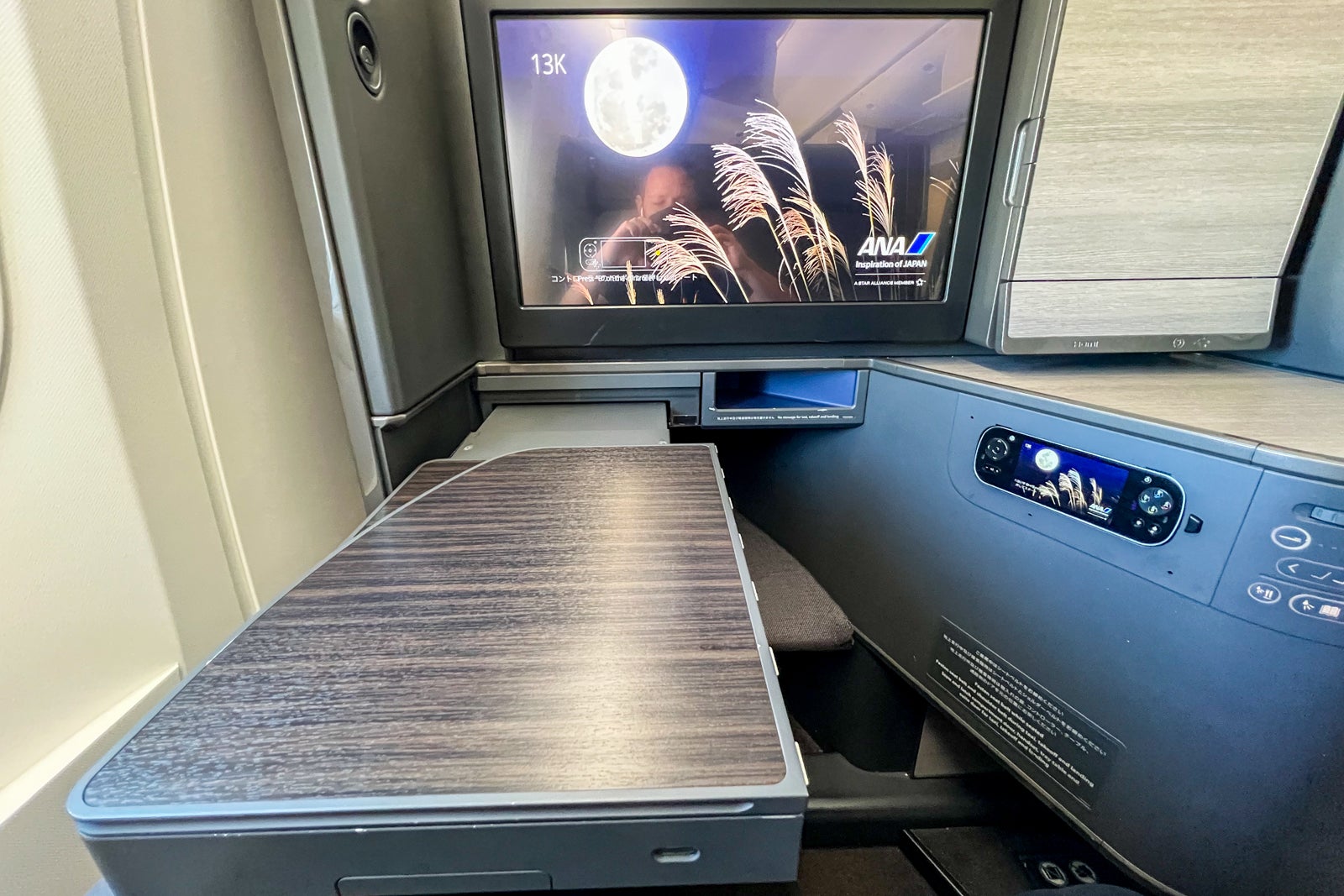
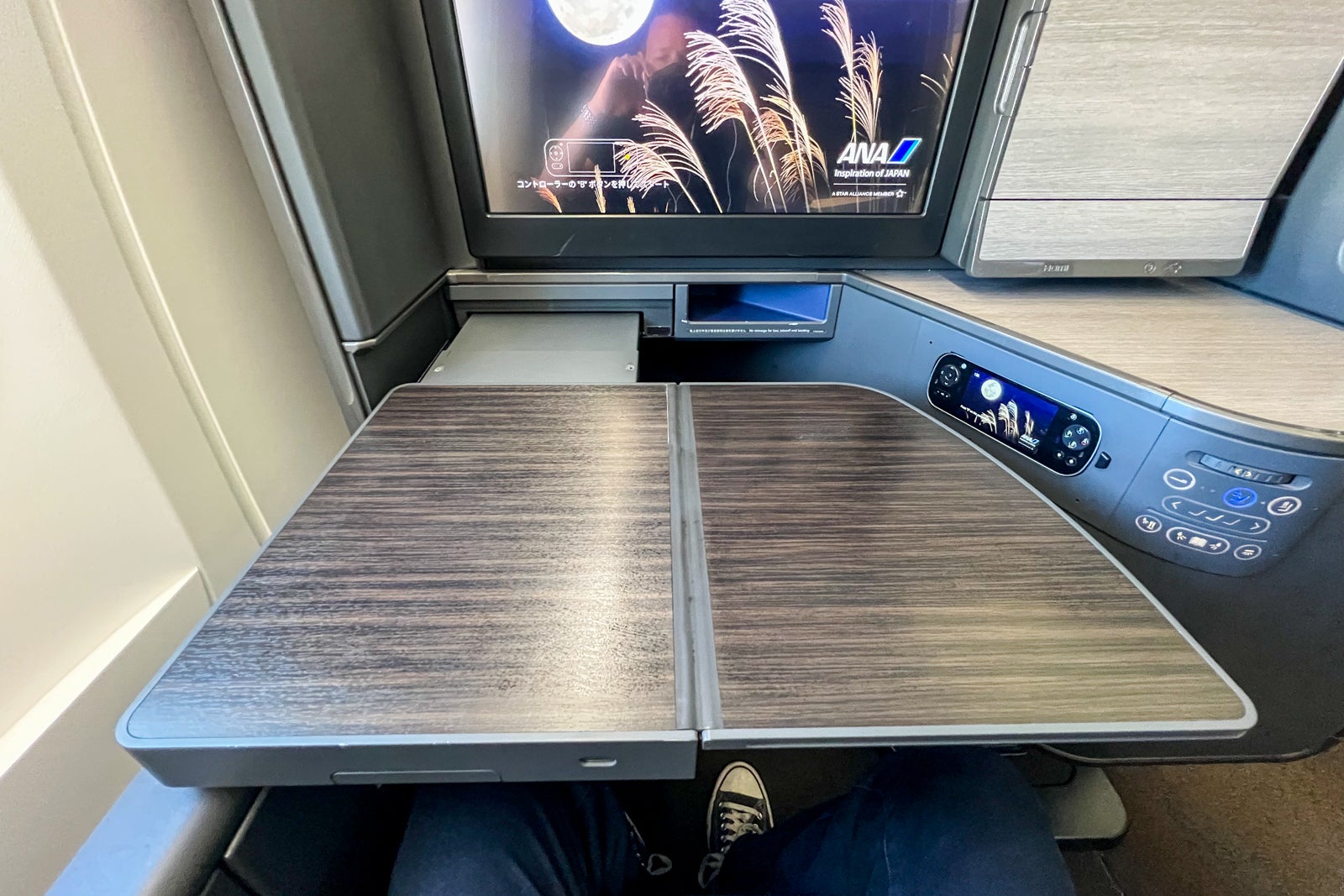
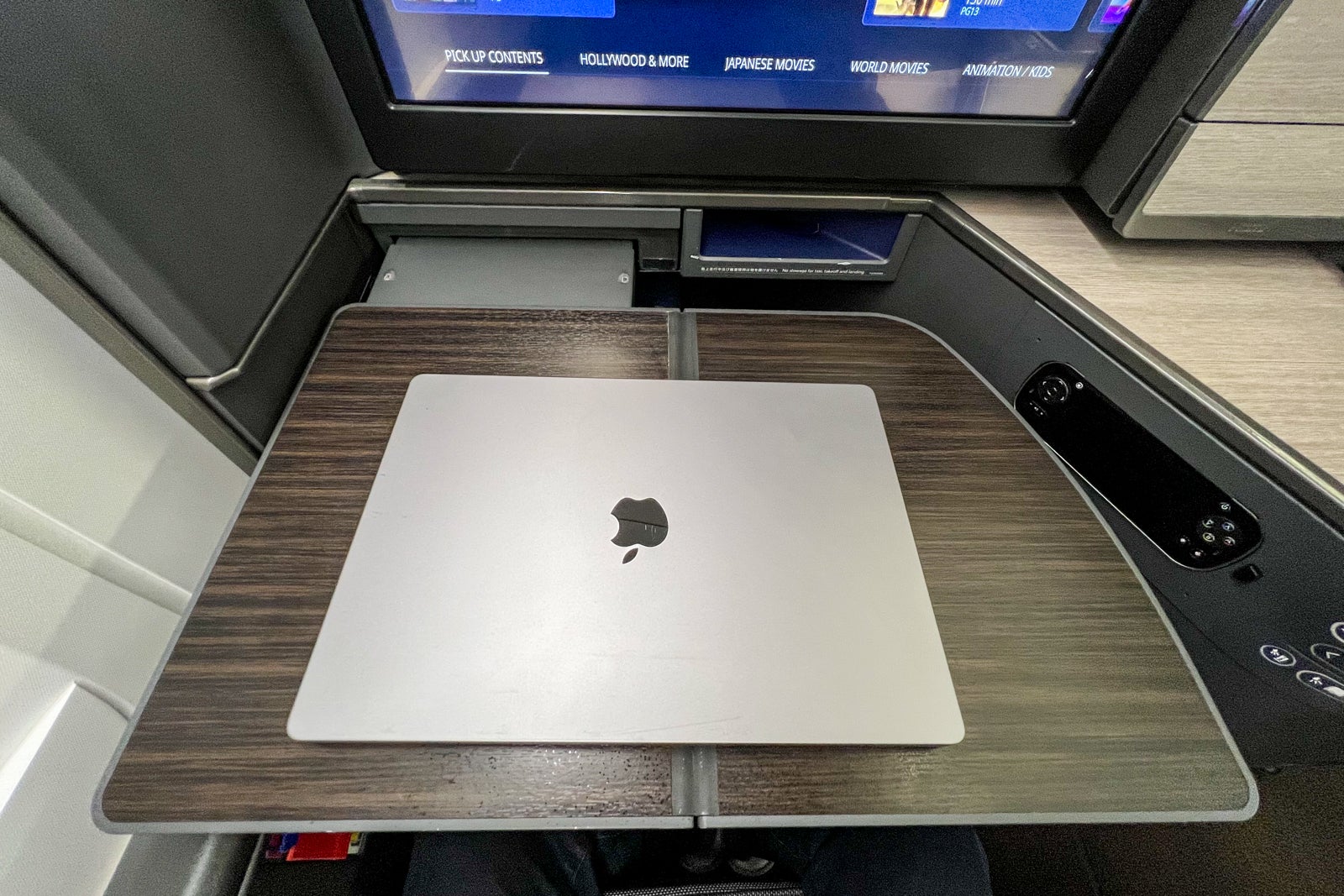
Also under the entertainment screen, next to where the table stows, is a small cubby for keeping an item like reading glasses or a bottle of antibacterial gel.
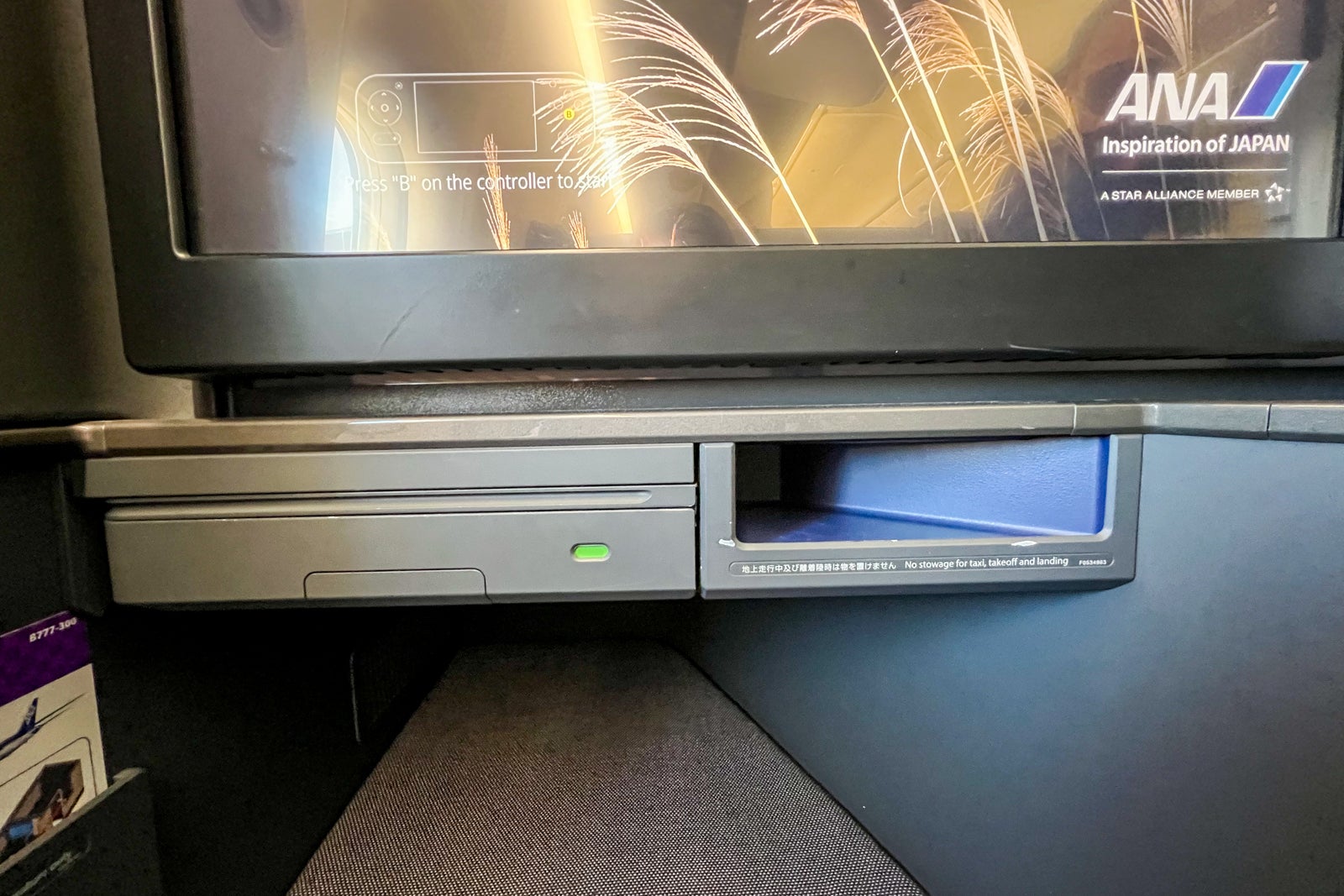
Next to the screen, on the side of the suite with the narrow armrest, is a reading light and a coat peg. There are also two overhead lights that you can illuminate with the touchscreen remote or the entertainment screen.
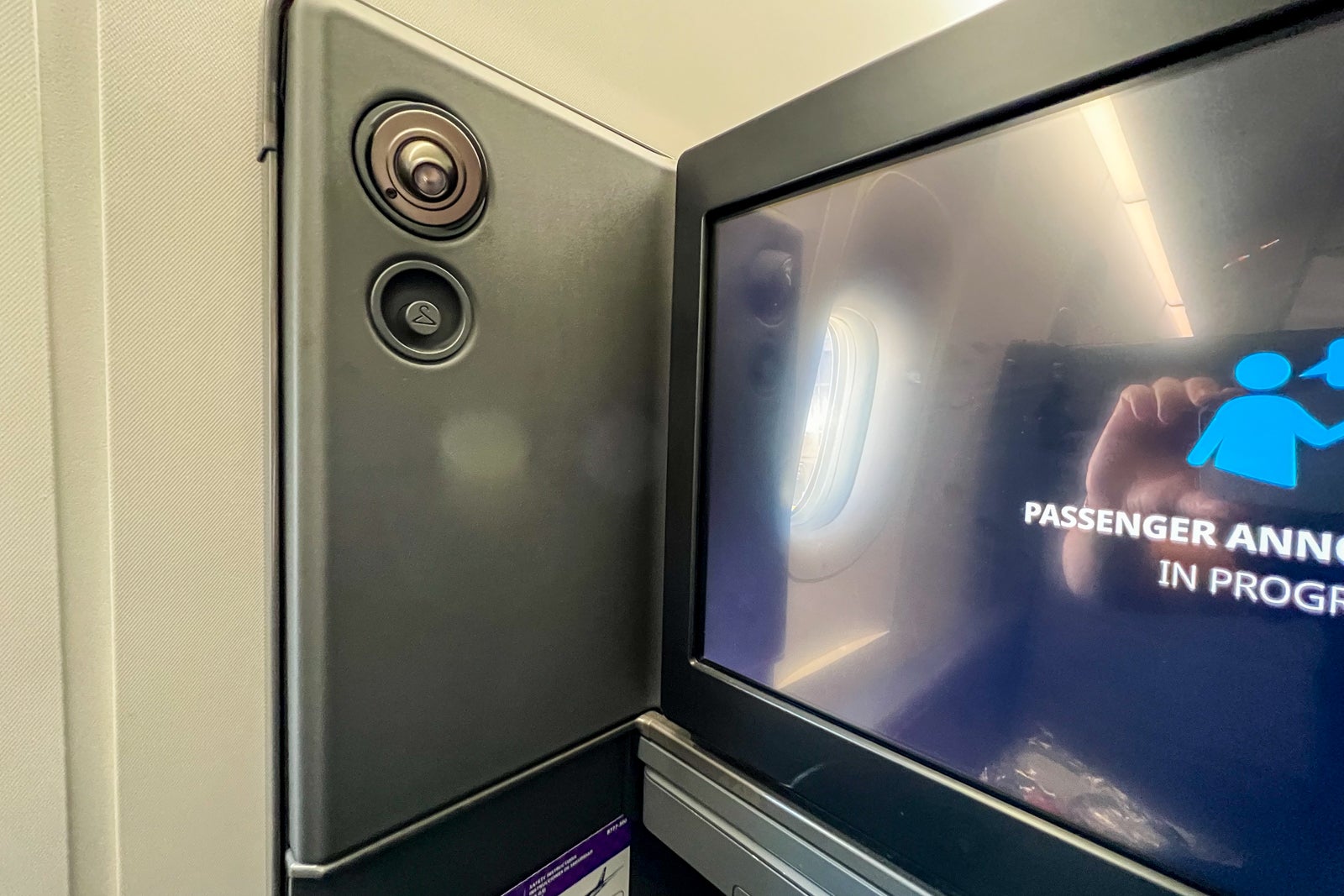
On the opposite side of the screen, a panel opens to reveal a shallow cabinet where you could stash your phone or tablet. It has two netted pouches for tucking in small items plus a mirror that swivels out for easy use.
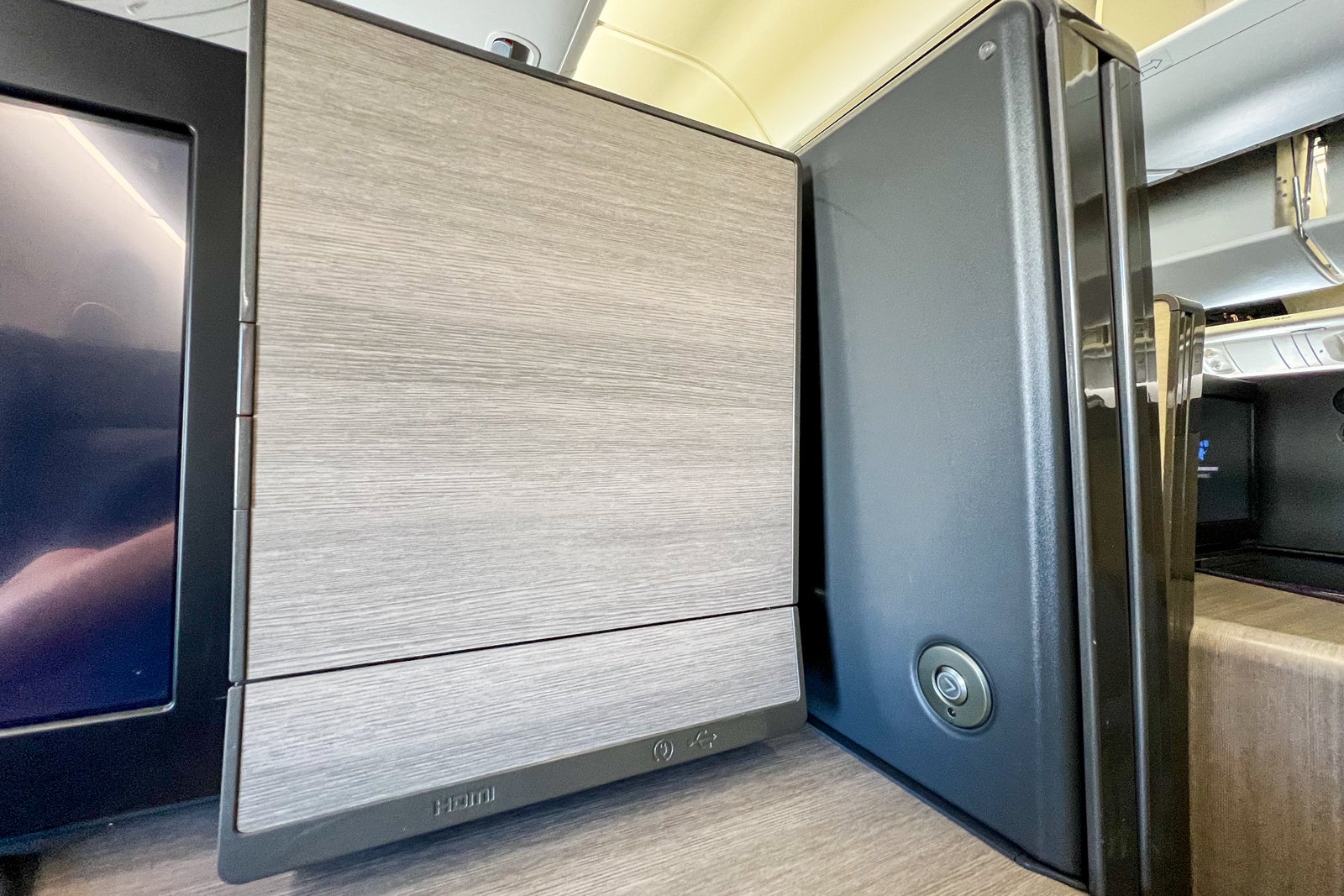
This cabinet also holds a universal power port and a USB-A charging point plus a taped-over HDMI port. The bottom part of this panel pops up so you can keep your devices plugged in even when it’s closed.
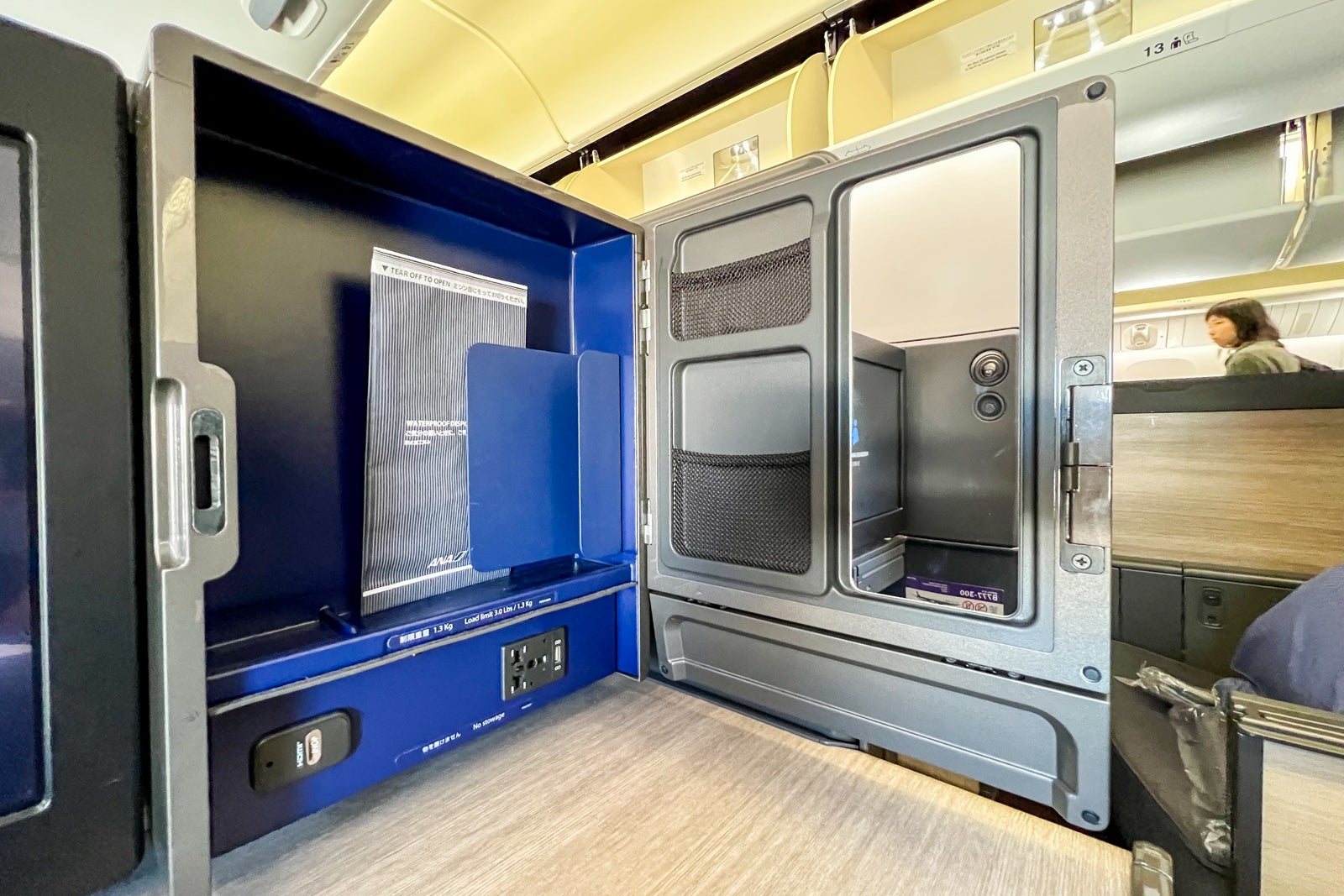
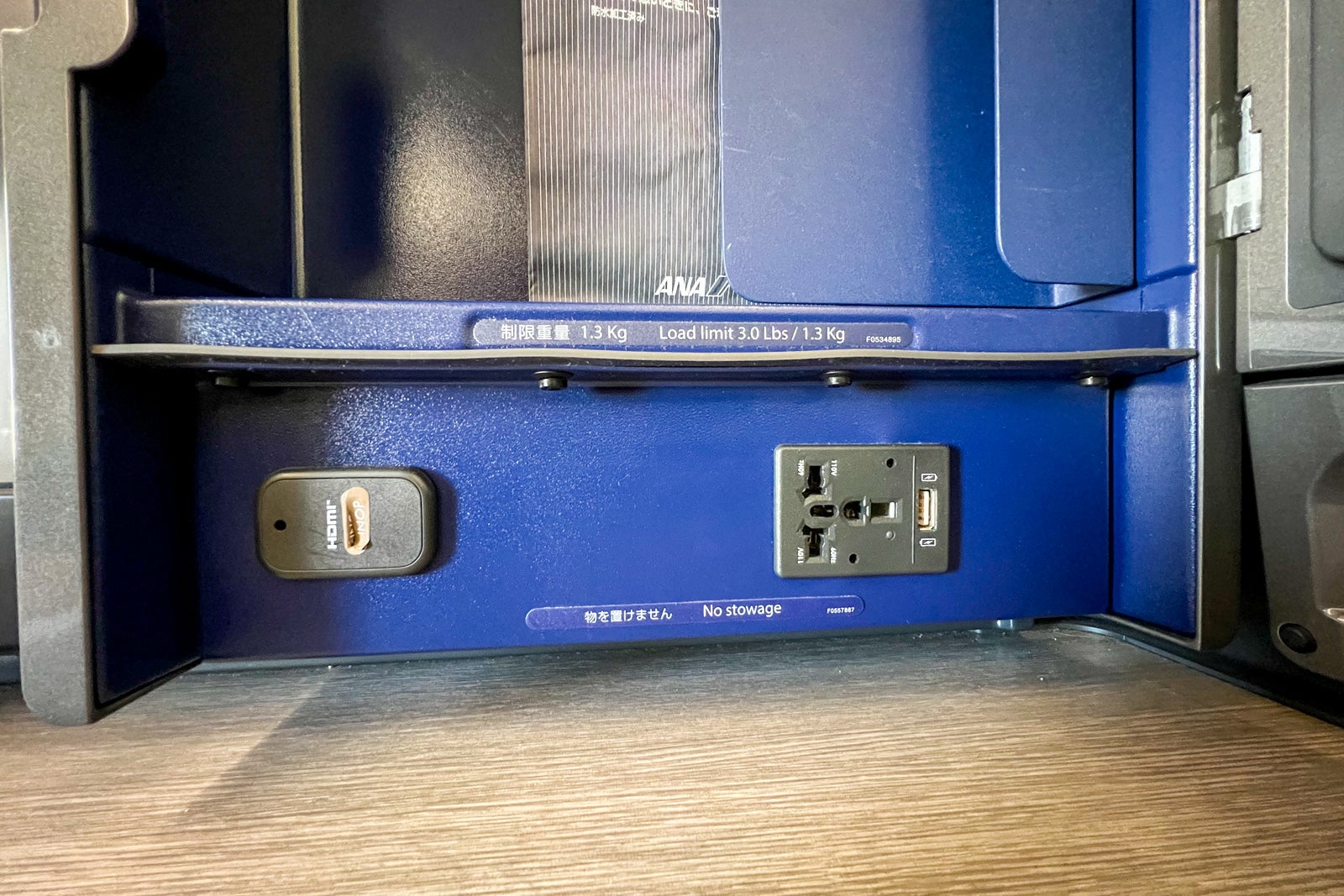
Below this cabinet is the wider console. Latched into one side of it is a handheld touchscreen remote for the entertainment system.
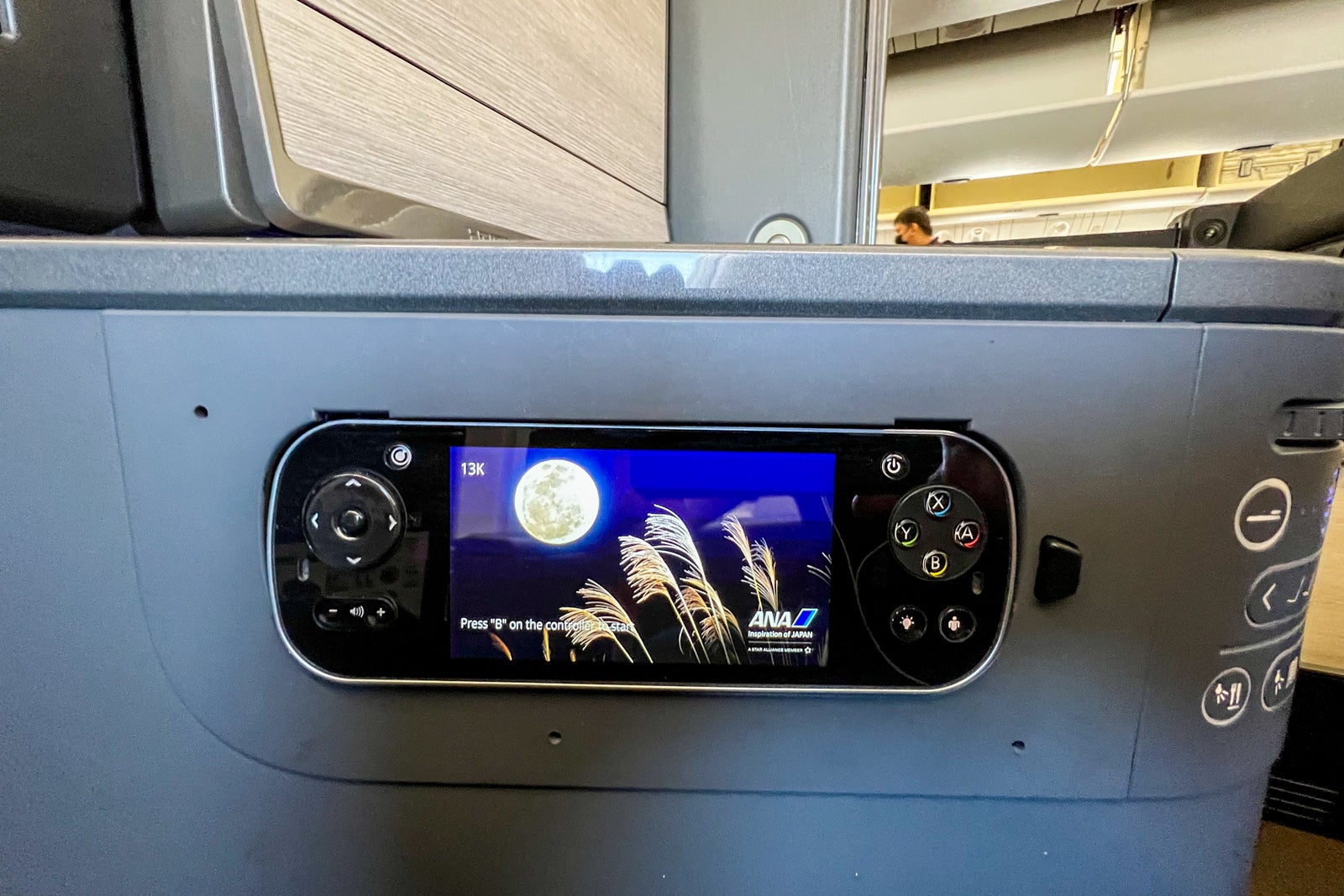
Around the corner from this are the seat controls. They include buttons with preset positions for takeoff and landing, for dining and to recline the seat into a lie-flat bed.
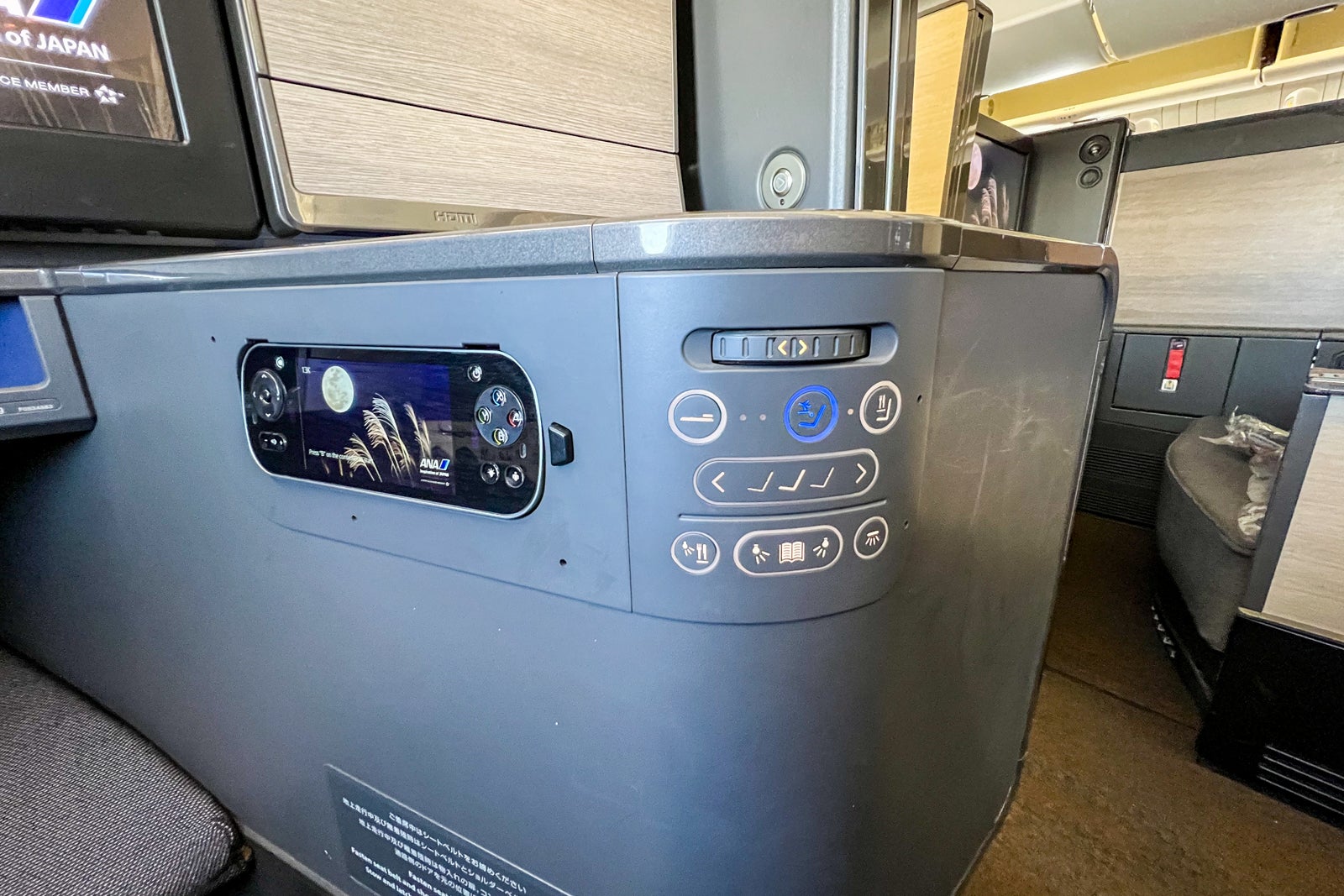
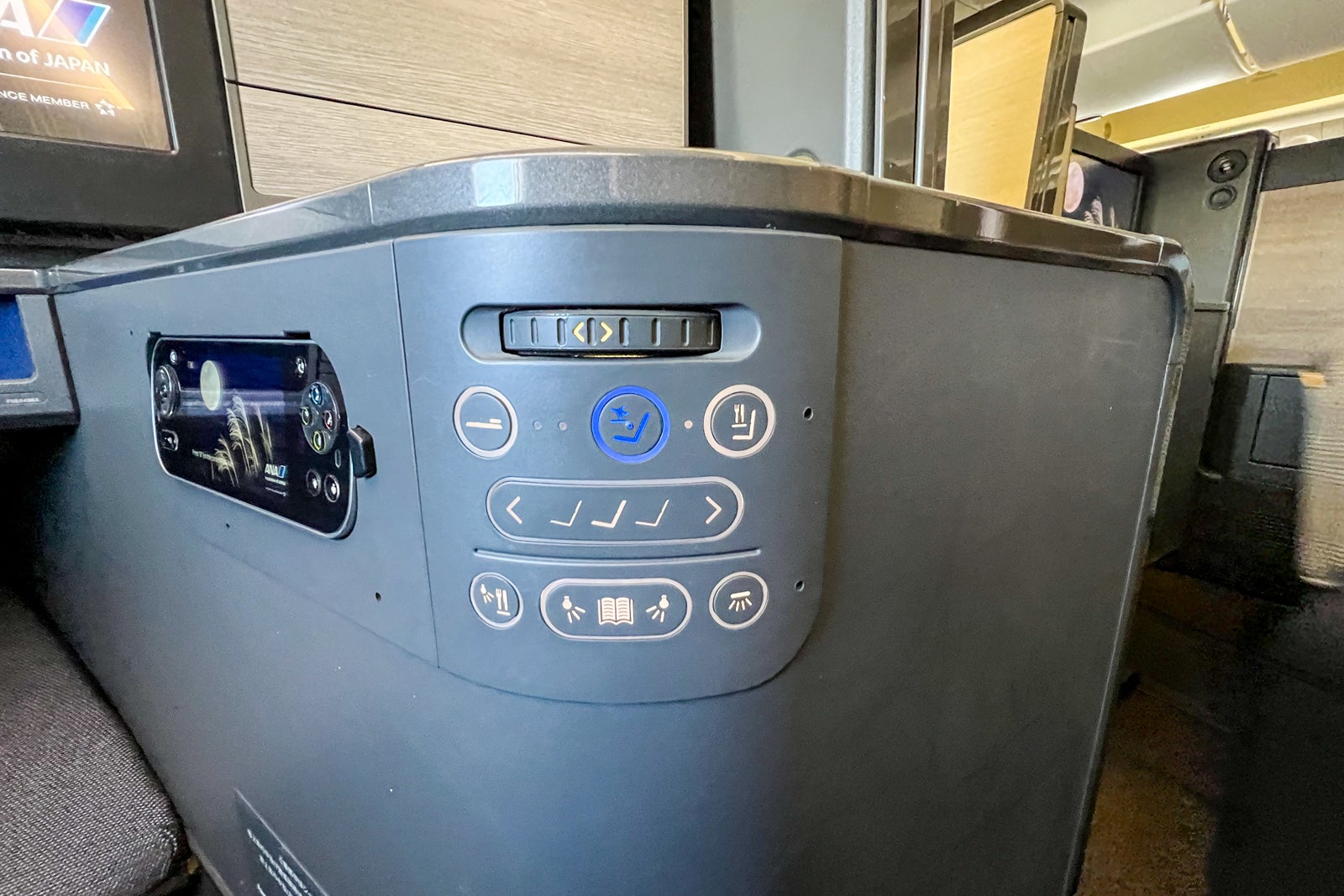
There is a wheel, sort of like United Polaris has, that reclines the seat or shifts it back to upright depending on how you turn it. There is also a sliding bar that shifts the seat forward or back, which can be helpful for getting closer to the table for dining. Unfortunately, it’s not possible to move the individual components of the seat like the leg rest or the seatback on their own, so you’re limited to a set range of reclining positions. You can also control the seat using the entertainment screen.

Below the seat controls are buttons to turn on and off the reading lights to either side of the seatback as well as the light next to the entertainment screen that is aimed where the table is positioned during meal service. There is another button that turns on a lighting feature under the stowage cubby for a relaxed nighttime vibe (this light is also good for seeing where things are if you need to get out of the bed after sleeping without turning on all the lights).
I personally appreciated the fact that seats had their own air nozzles so it was easy to adjust the temperature in the suite even as the cabin turned slightly warm.
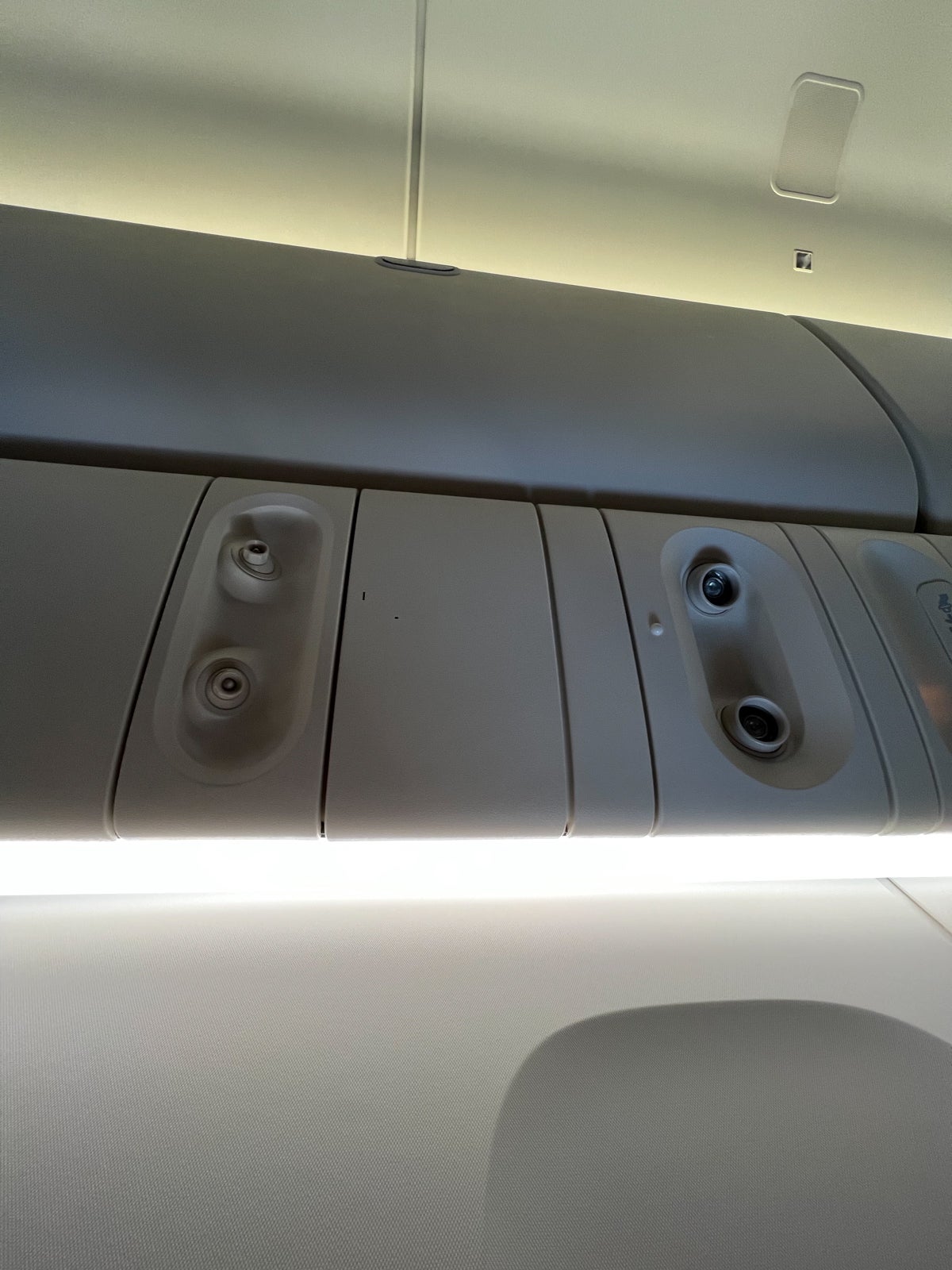
One of the complaints that folks tend to have about suite-style, lie-flat seats is that their footwells can feel somewhat cramped. That’s not the case with ANA’s The Room. I measured my footwell to be 21 inches wide at its mouth, though it narrows to about 12 inches at the back and 14 inches high. That meant it was easy to turn one way or another while resting.
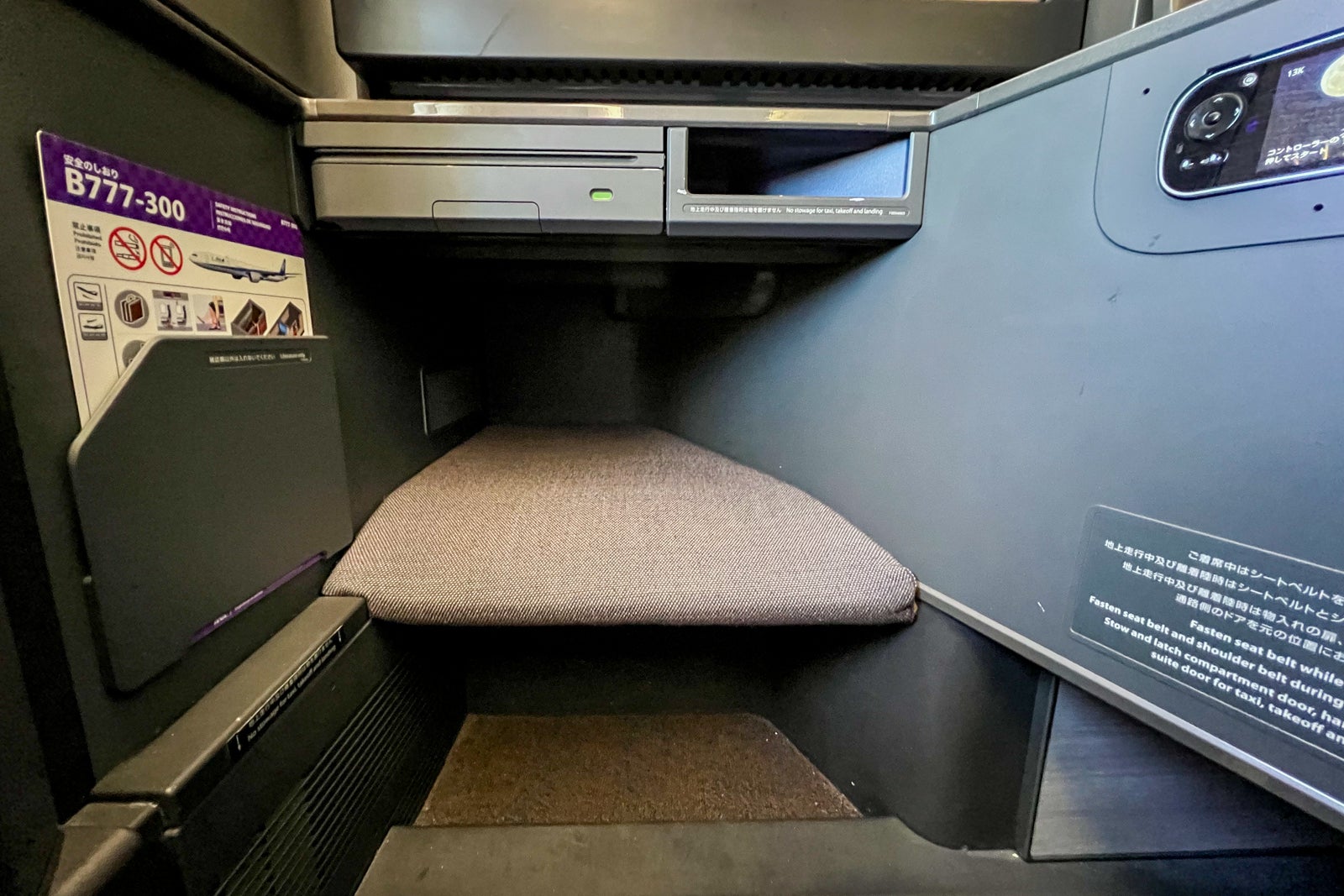
However, one of the main drawbacks to this seat is that in lie-flat mode it only measures 72 inches long. While that’s plenty long for shorter travelers like me, those even approaching 6 feet might start to feel constrained. Of course, it’s still very wide as a bed and that makes it easy to sleep in many different positions, so most folks might not be bothered.
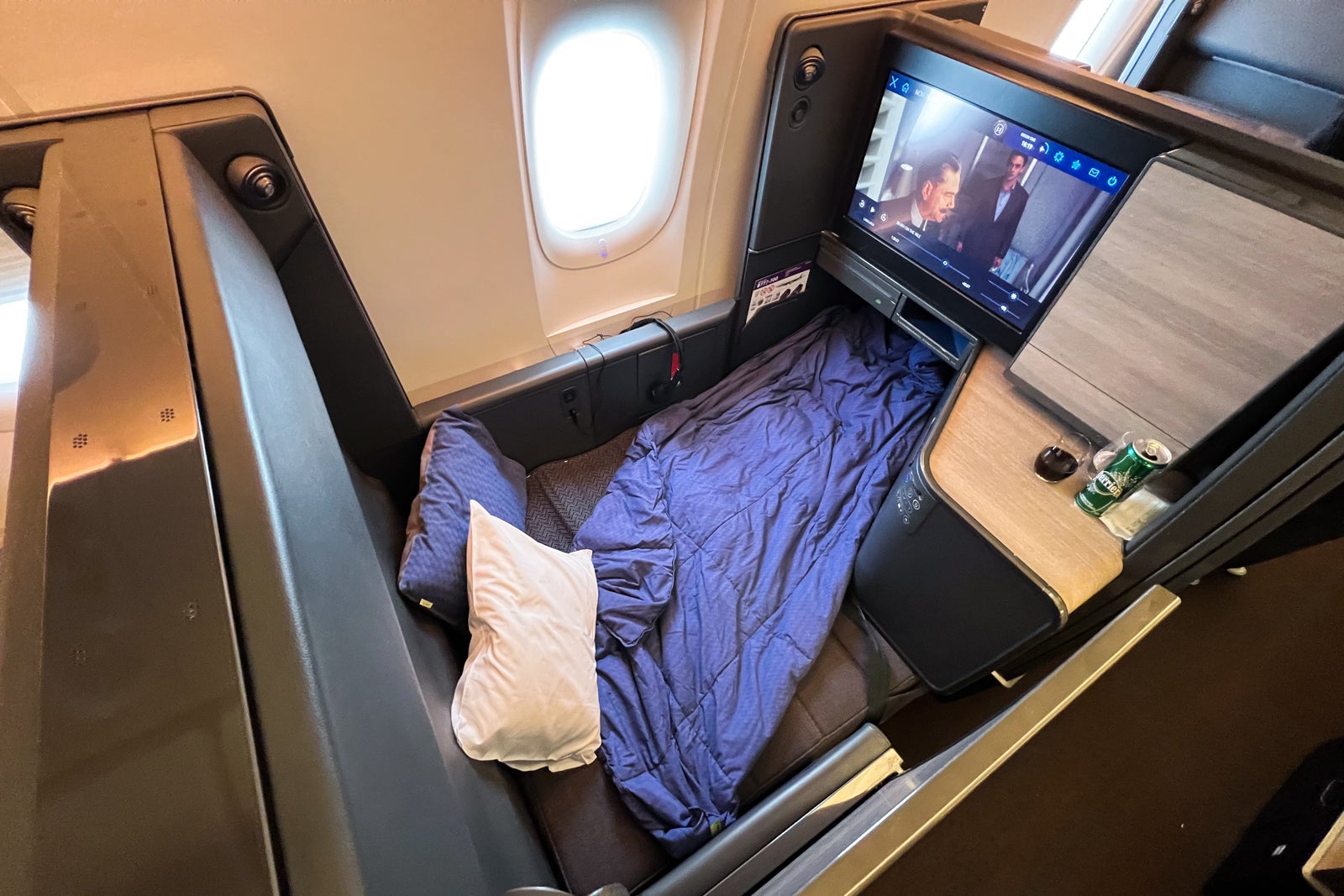
Passengers with window seats can use two buttons to electronically lower or raise the shades. A first set of accordion blinds still lets some light in while the second set is more like a blackout shade.
Armrests to either side of the seat have headphone jacks embedded in them; one armrest has a USB port and the other has a button for raising the seat’s smaller privacy panel.
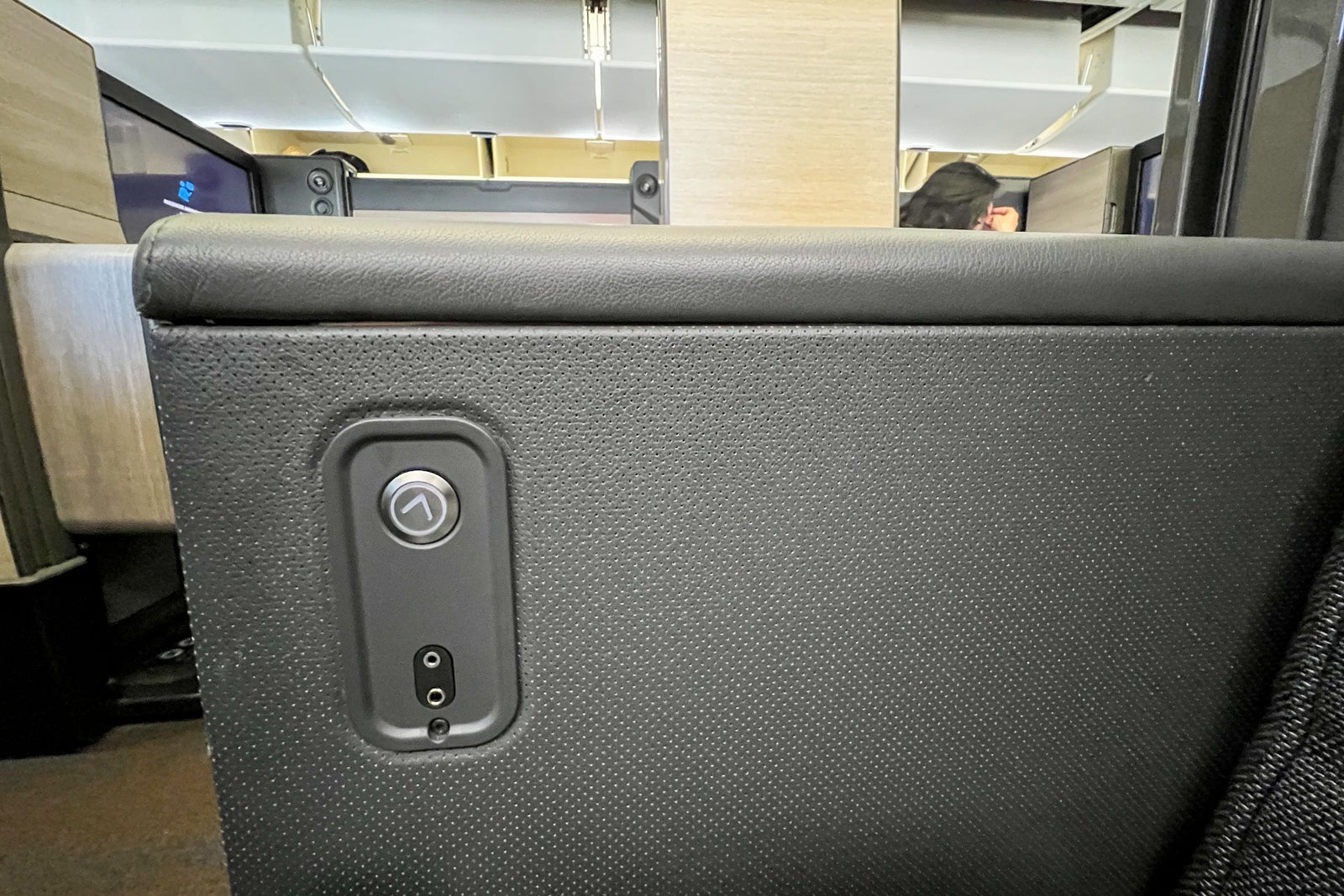
Unlike Qatar Qsuites, which have a single, full-length panel that slides shut to enclose the suite, ANA’s The Room has a larger panel across from the seat that slides toward the passenger, and a smaller side panel that is raised from the aisle-side armrest. Each is released by the press of a nearby button.
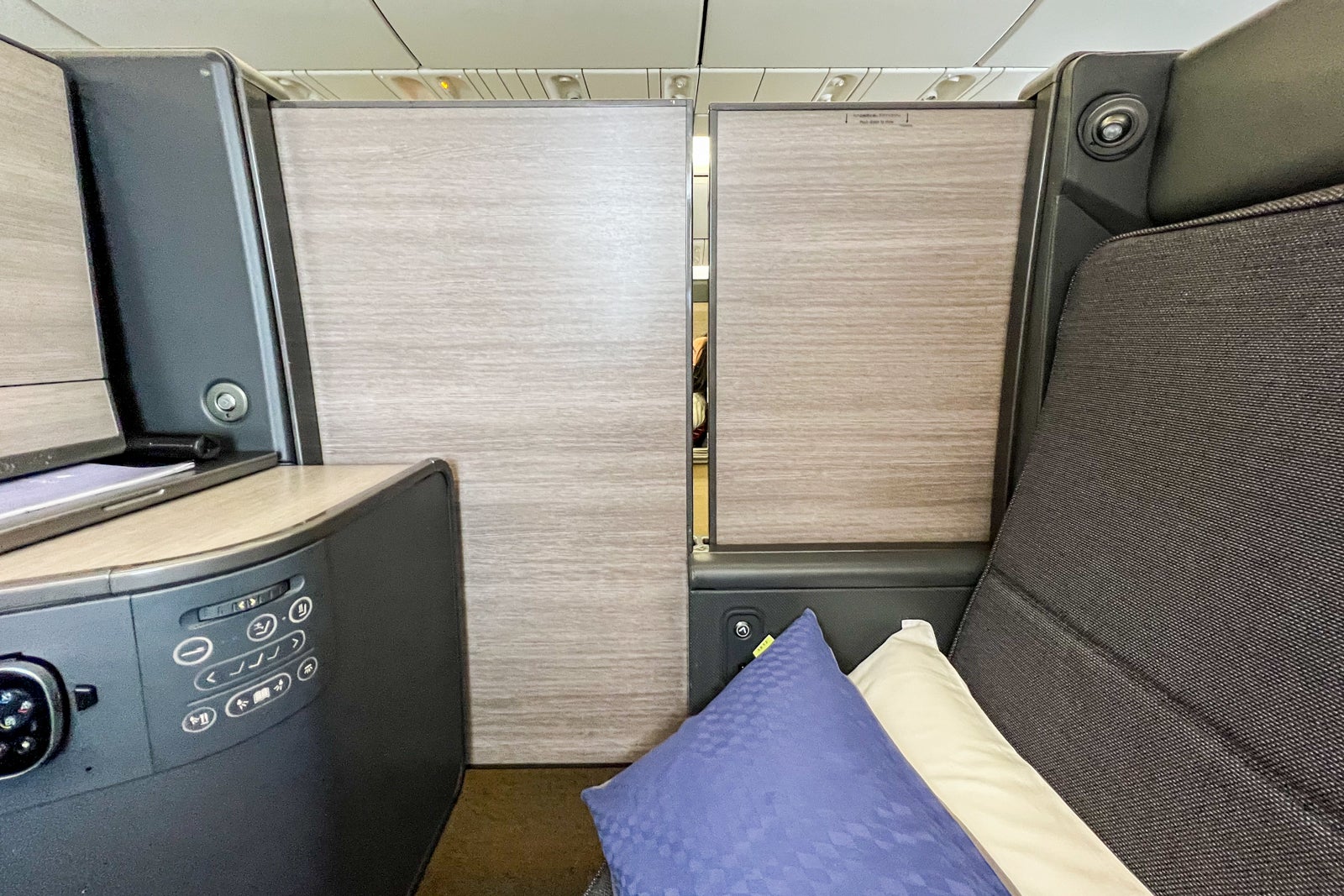
These two panels form a wall of sorts, but do not fully close and can be a little hard to push back into place. There is also a gap of just under a foot between the bottom of the larger panel and the floor, though that made it easier to tuck my slippers in there for easy access when I wanted to get out and use the lavatory.
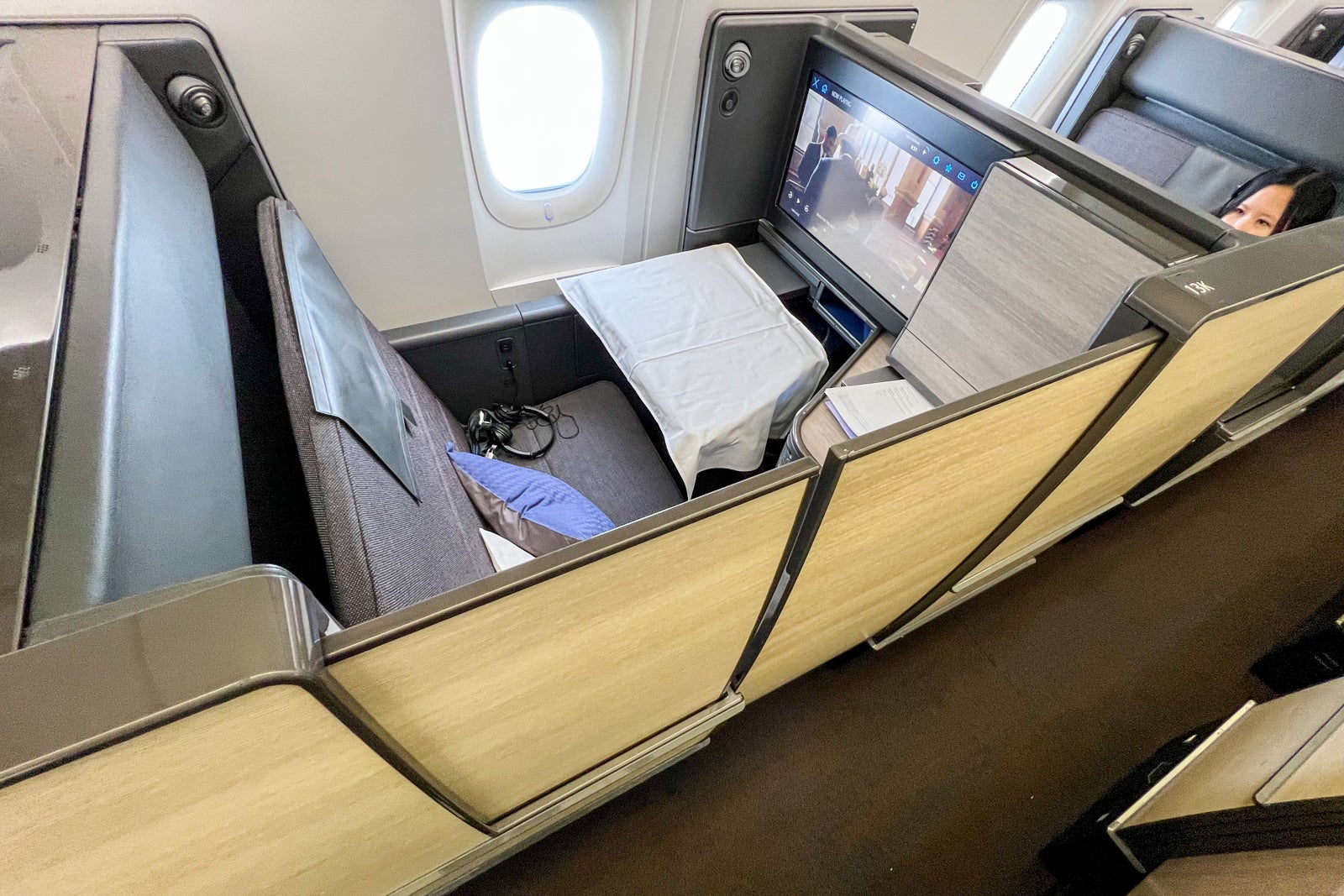
Despite the gaps, these panels still provide a high level of privacy that was more than enough to avoid noise and traffic from the aisle. Their slight curvature also helps maintain the spacious feeling of The Room, even when the panels are fully extended.
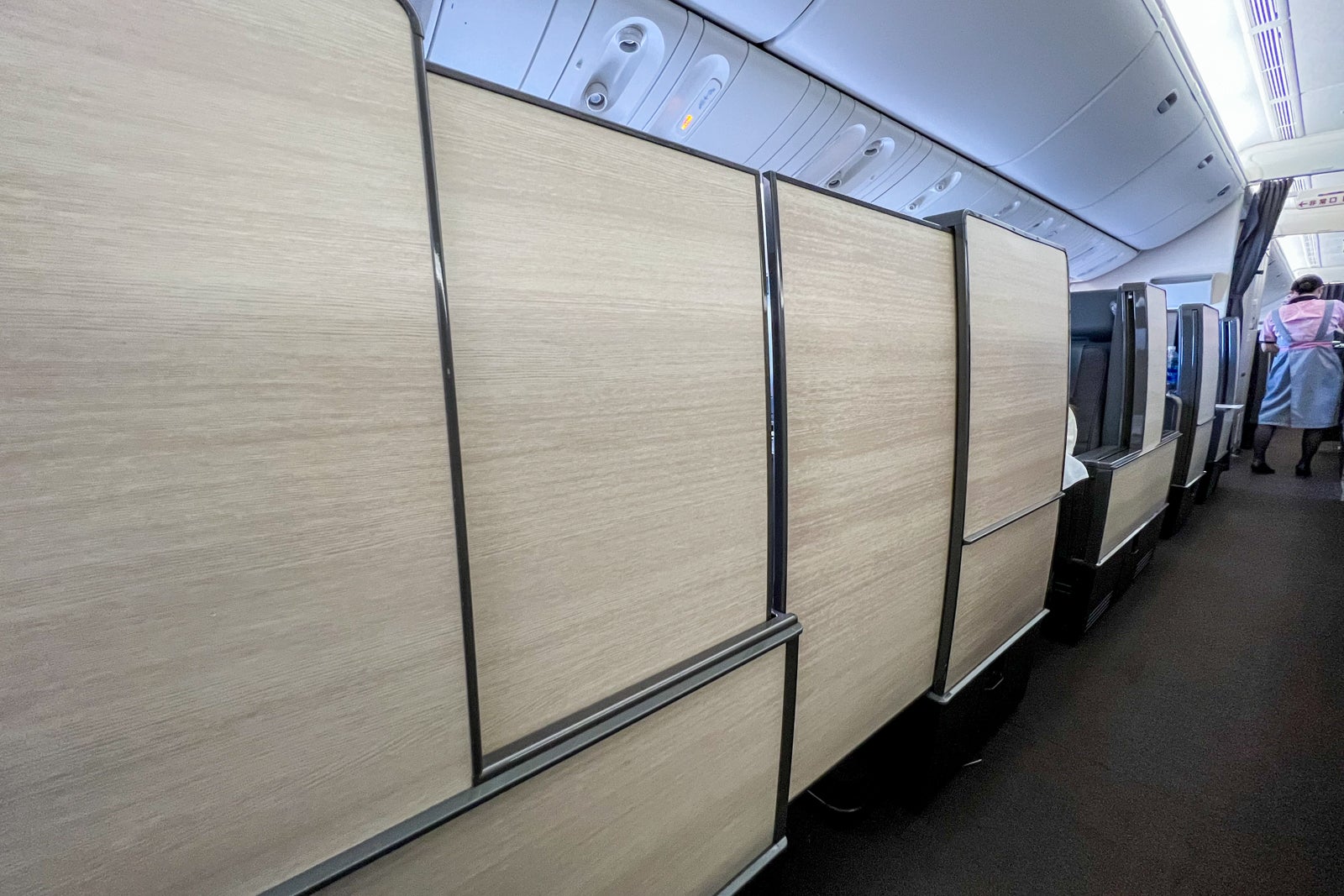
Overall, The Room is a stunning product. Its enormous size, comfortable positions and easy-to-use privacy panels all make it one of the best thought-out business-class experiences in the sky.
In terms of drawbacks, the main ones I noted were a lack of personal storage and not being able to move the individual components of the seat, though it is still maneuverable enough for most flyers to be able to get comfortable. The privacy panels are also a game changer that elevates the experience to something that feels more akin to first class on other airlines.
Amenities and service
Waiting at my seat when I boarded were a pair of soft slippers, a small blue pillow and a larger white one, plus a seat pad for bed mode and a lightweight blue blanket. There was also a basic set of headphones and a hot pink Globetrotter amenity kit.
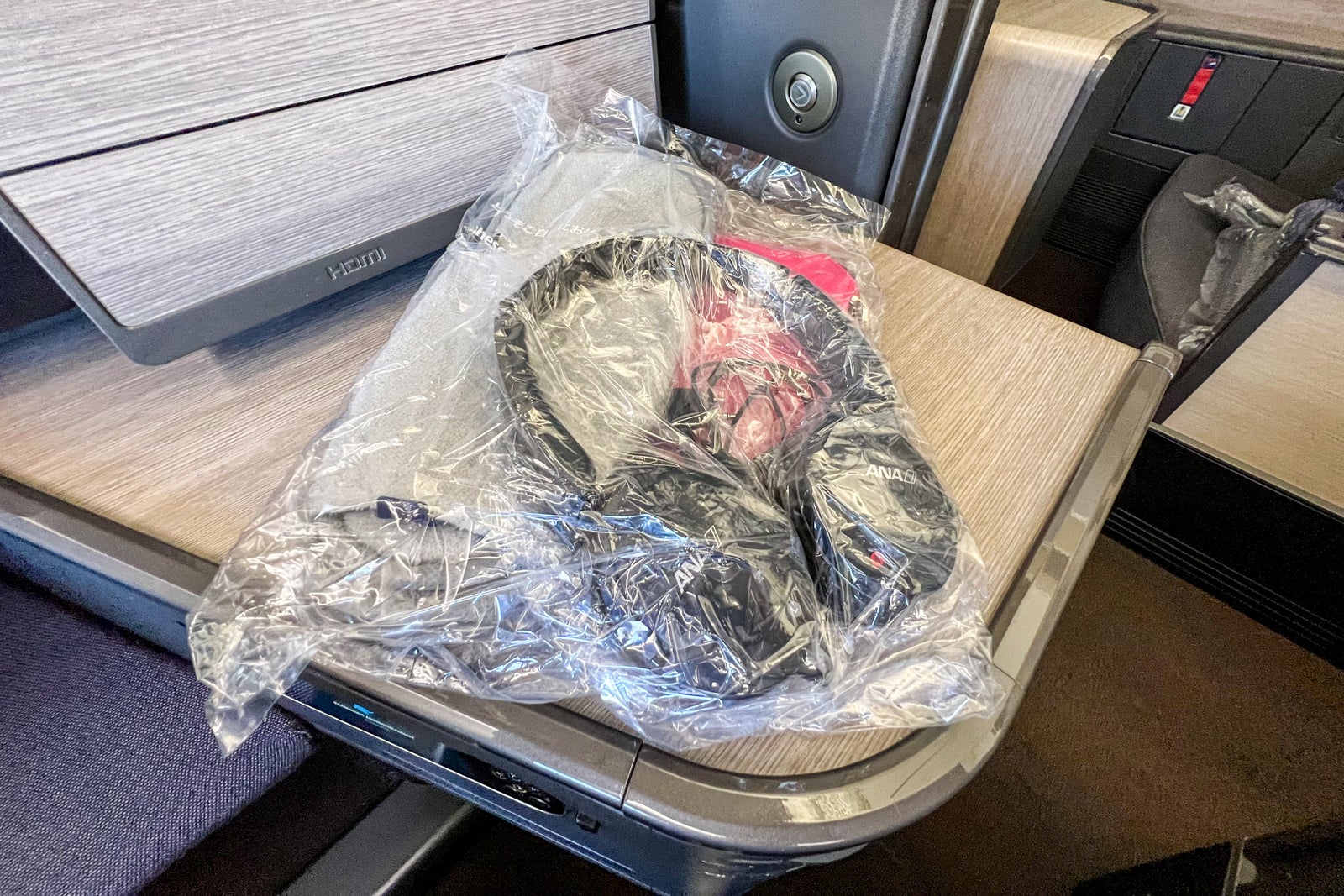
The kit contained a toothbrush and toothpaste, ear plugs, an eye mask, and Shiro-brand yuzu face mist and lip balm, both of which smelled fresh and fruity. Unfortunately, ANA does not provide pajamas, though you can borrow a type of cardigan to sleep in if you like. I just slipped into my own T-shirt and shorts for a snooze.
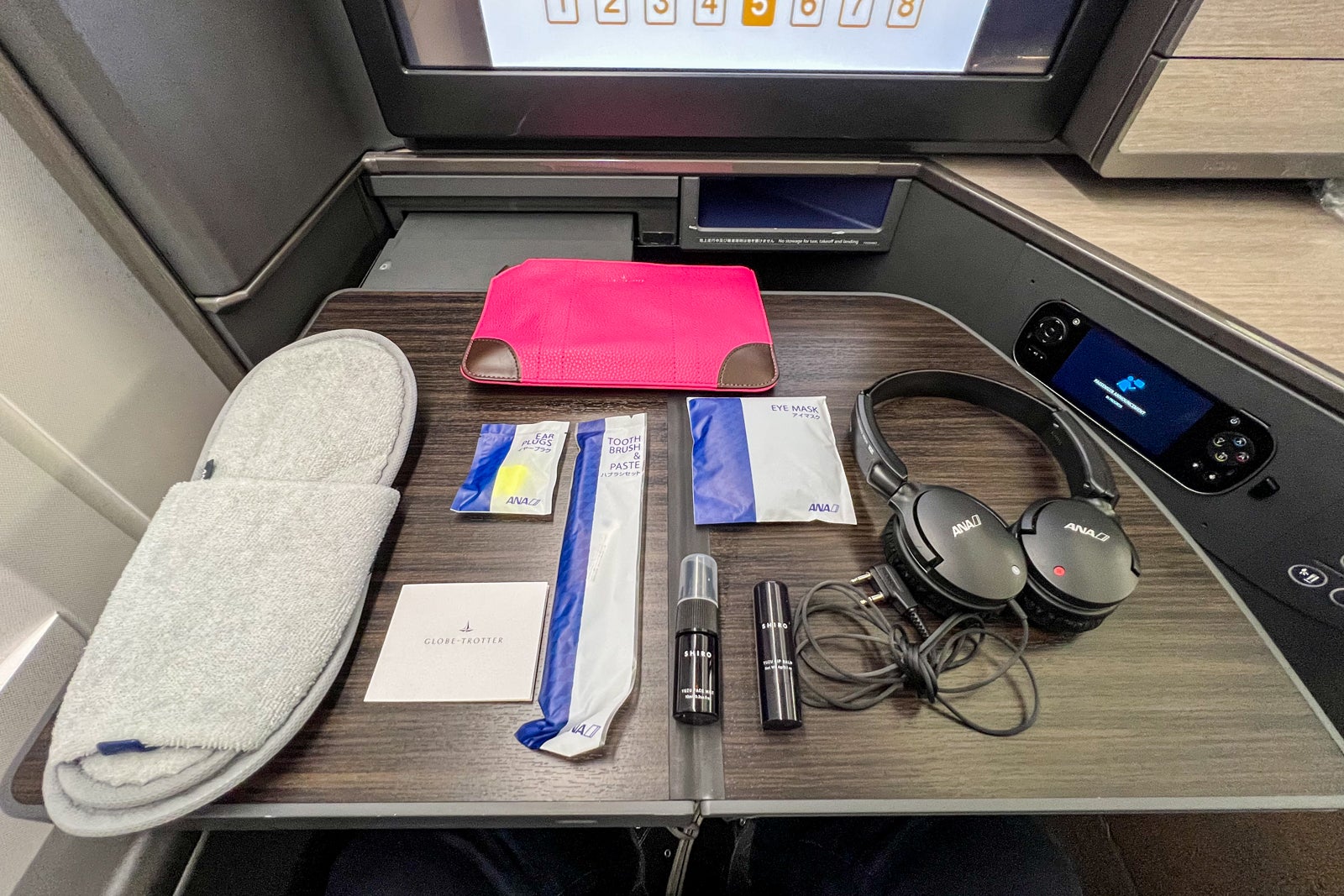
When it came time to turn in, I lowered my seat into bed mode and put down the seat pad that had been waiting at my place upon boarding as well as the lightweight blue blanket.
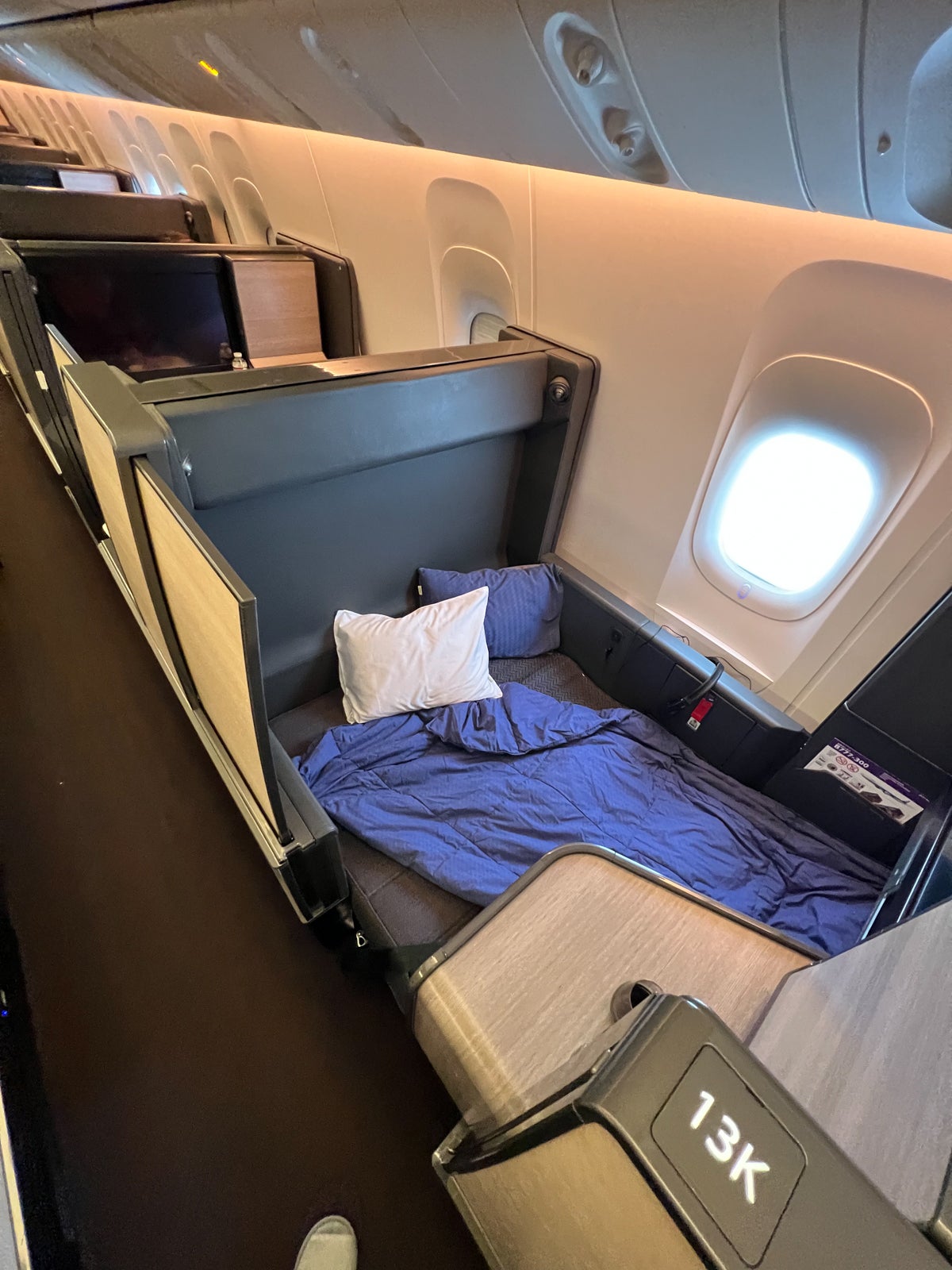
There was no extra mattress pad to cover the entire surface area of the seat as I’ve seen in other reviews of the product and which would probably have made the somewhat hard seat cushion a bit more comfortable. Still, I was able to sleep for several hours very comfortably.
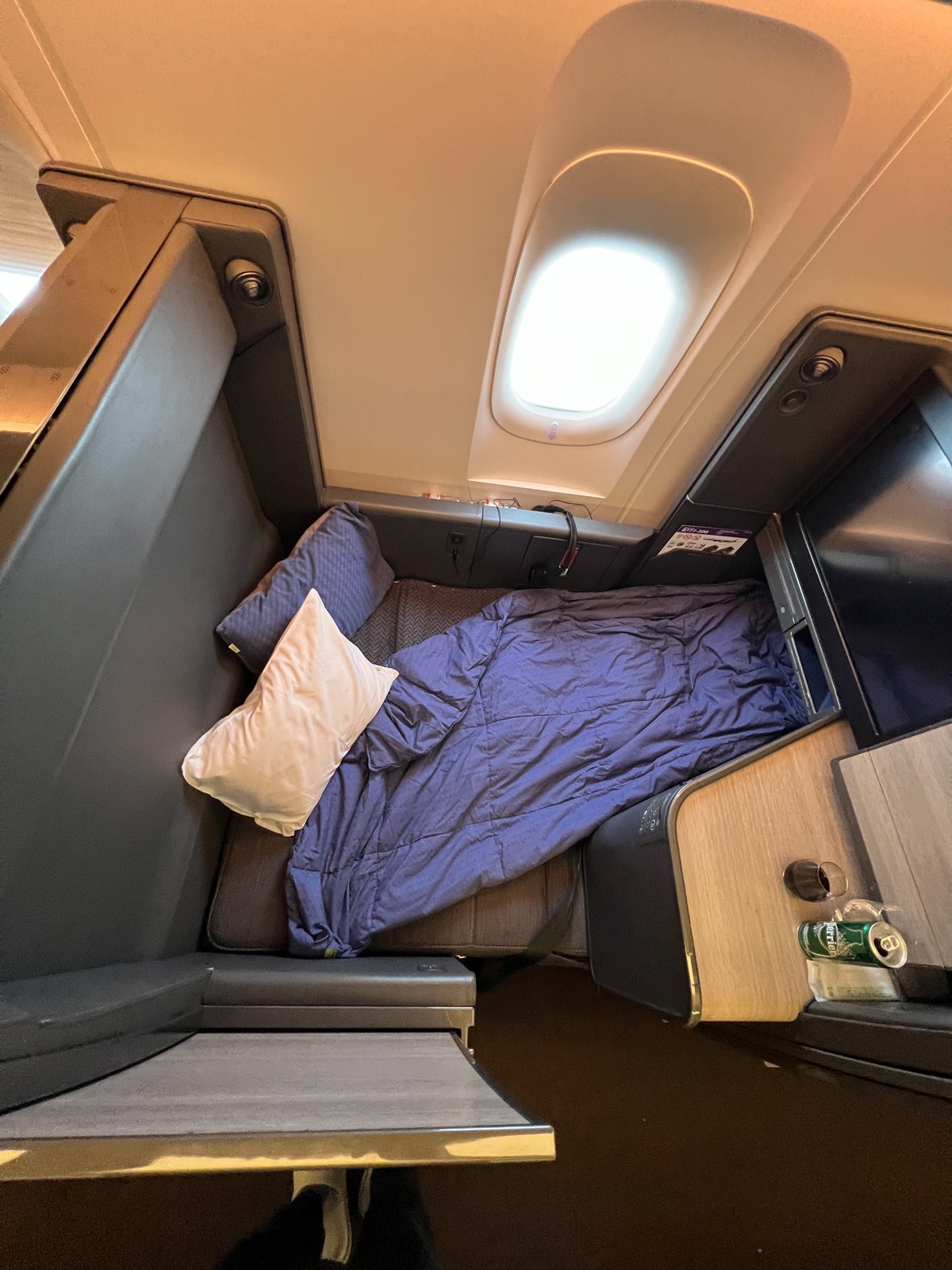
One of the best features of The Room is its up-to-the-minute 4K, 24-inch HD entertainment monitor, which passengers can control either with the touchscreen remote or by directly tapping on the main screen itself.
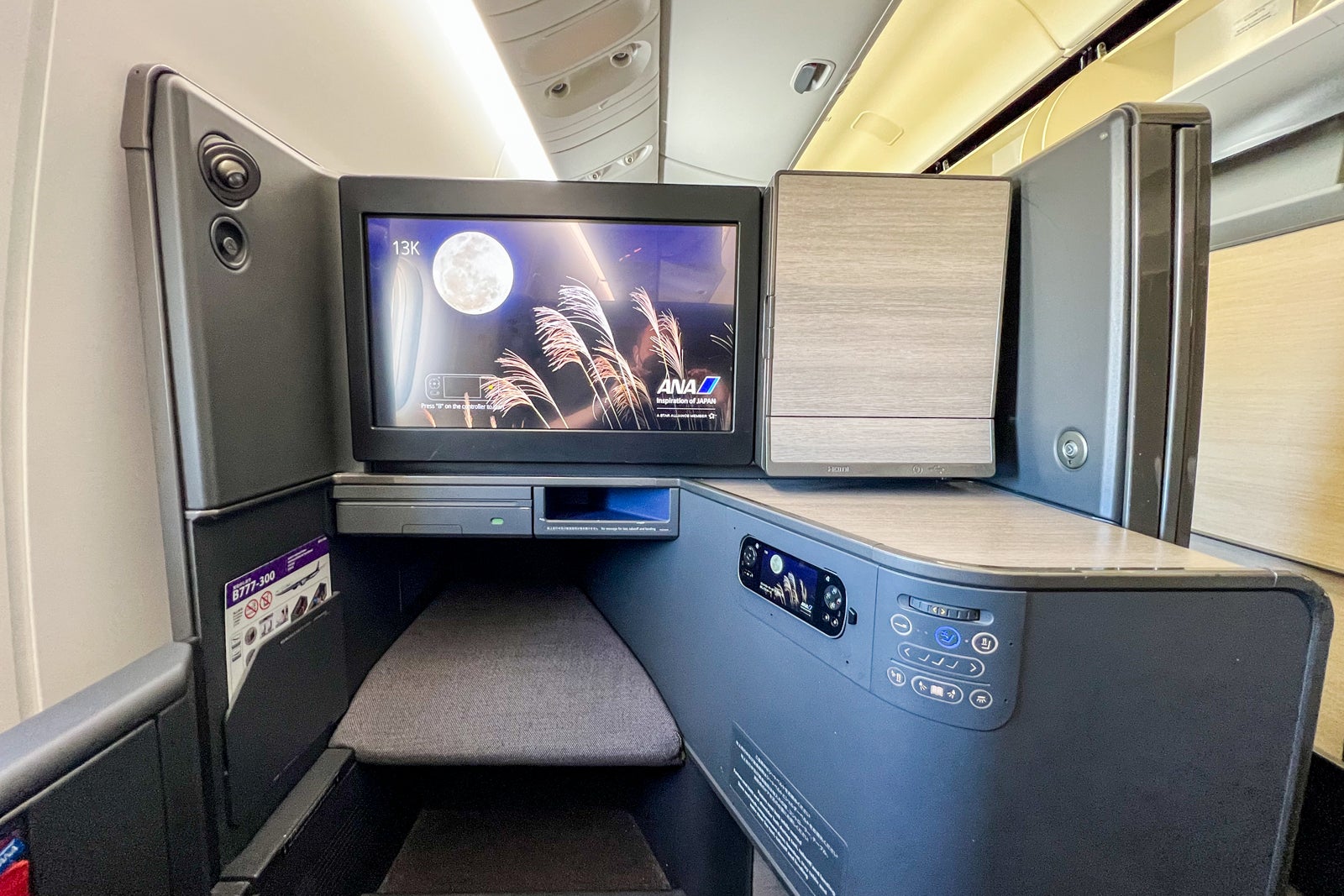
You can also pair your phone with the entertainment screen and use it as a control instead.
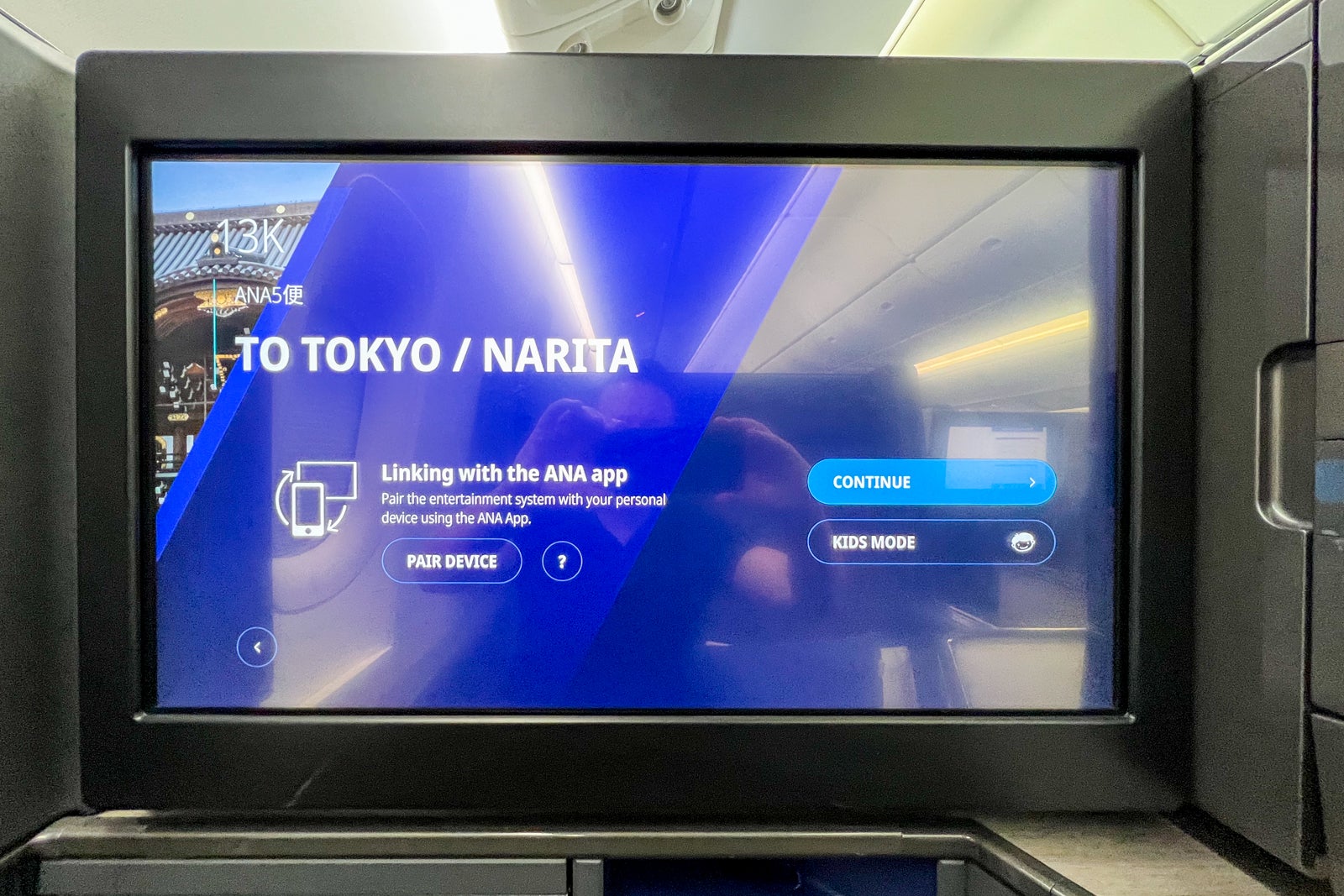
The welcome screen presented 11 different languages to choose from. From there, passengers could select from movies, music, games, e-books, SKY Live TV and more. The movies included some recent releases like the latest “Downton Abbey” installment and “Top Gun: Maverick,” as well as Japanese and other international options. Overall, though, the selection was fairly small.
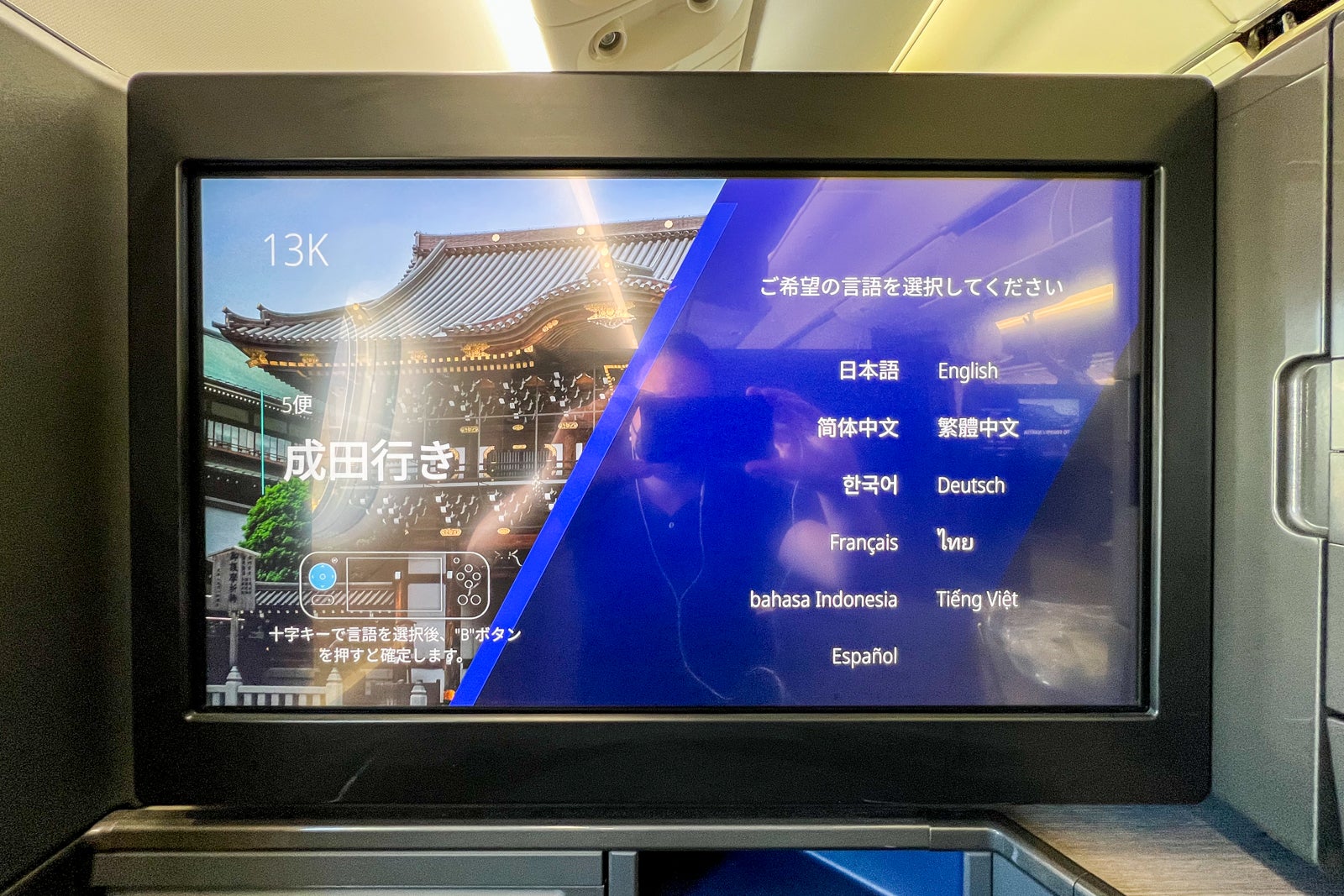
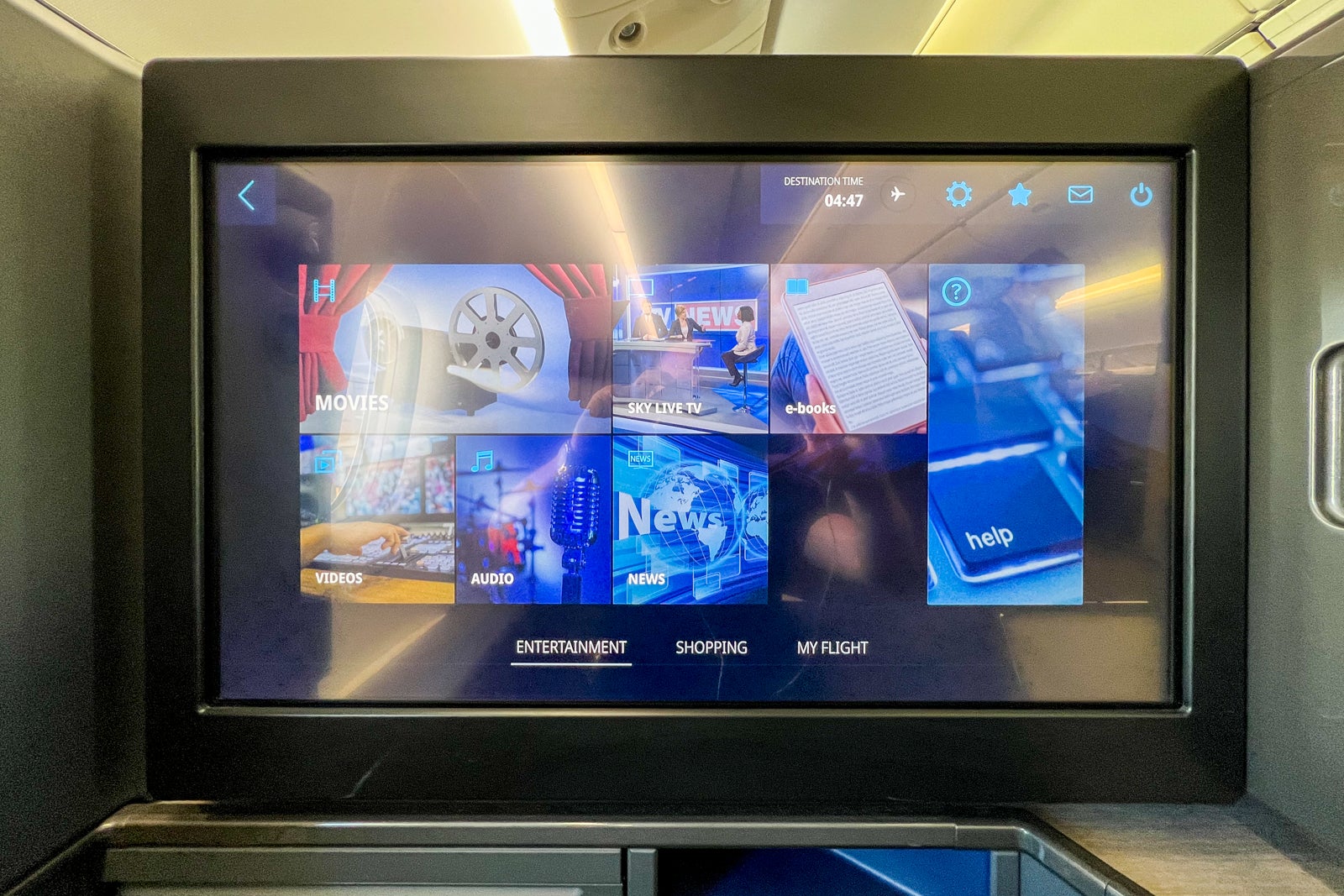
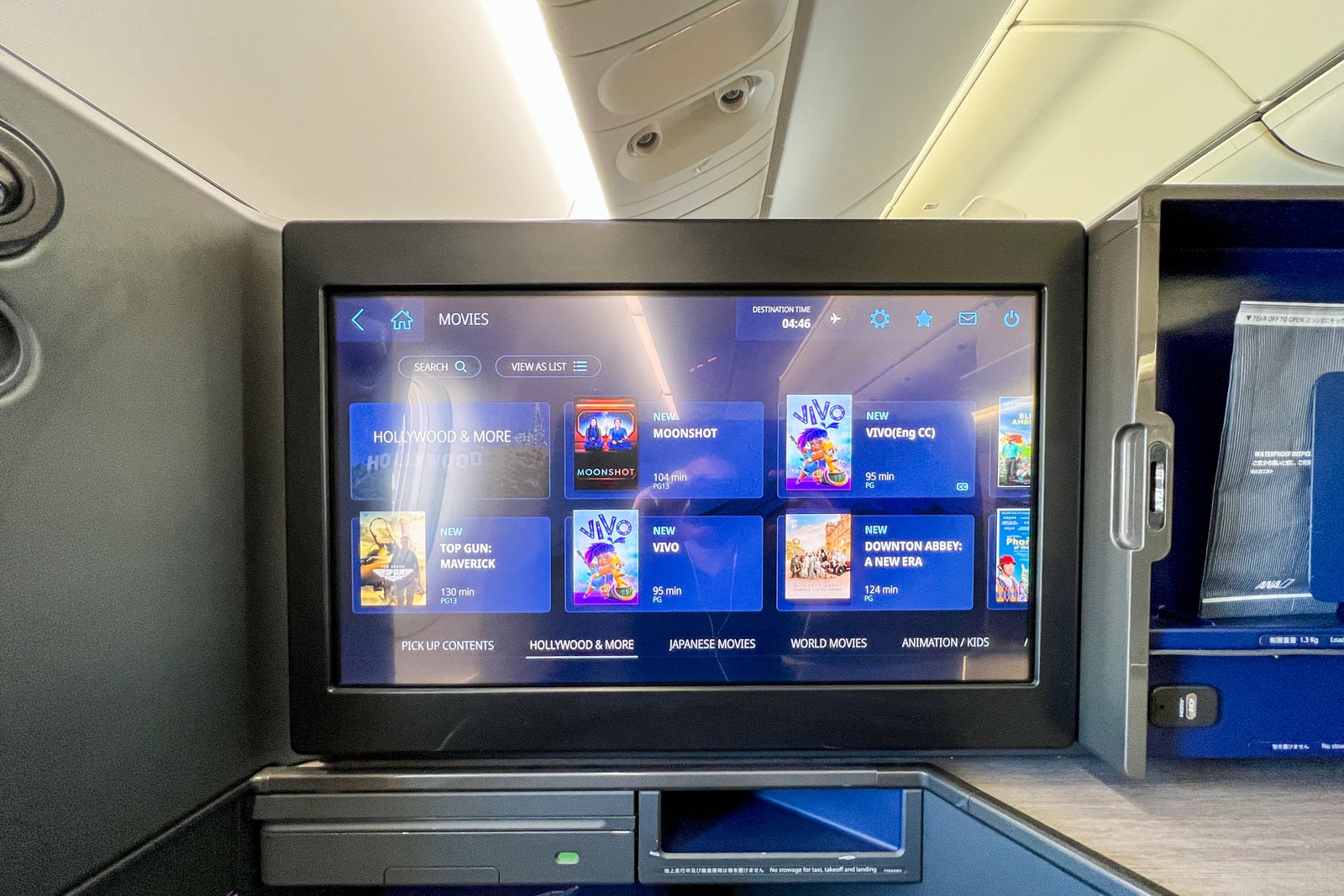
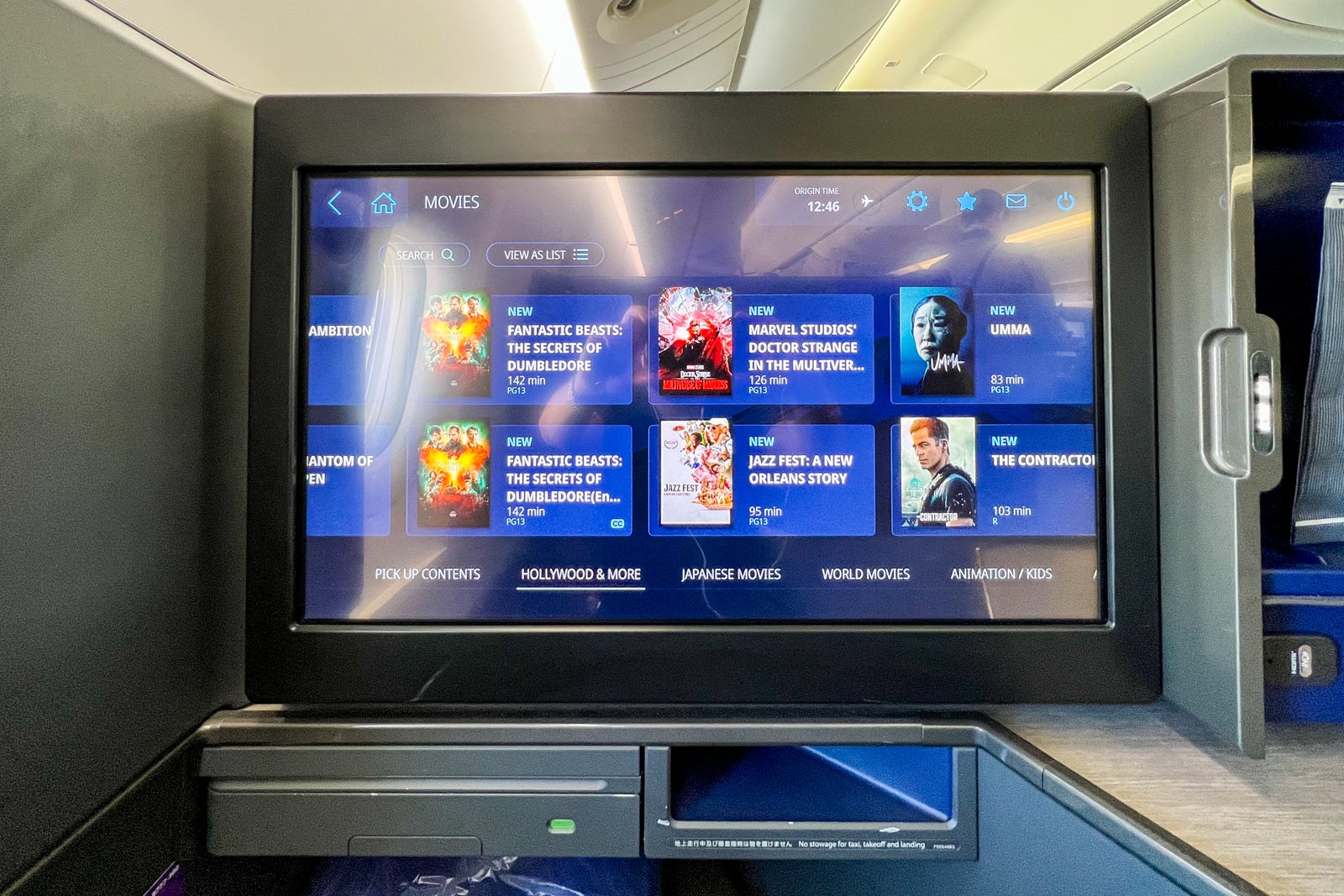
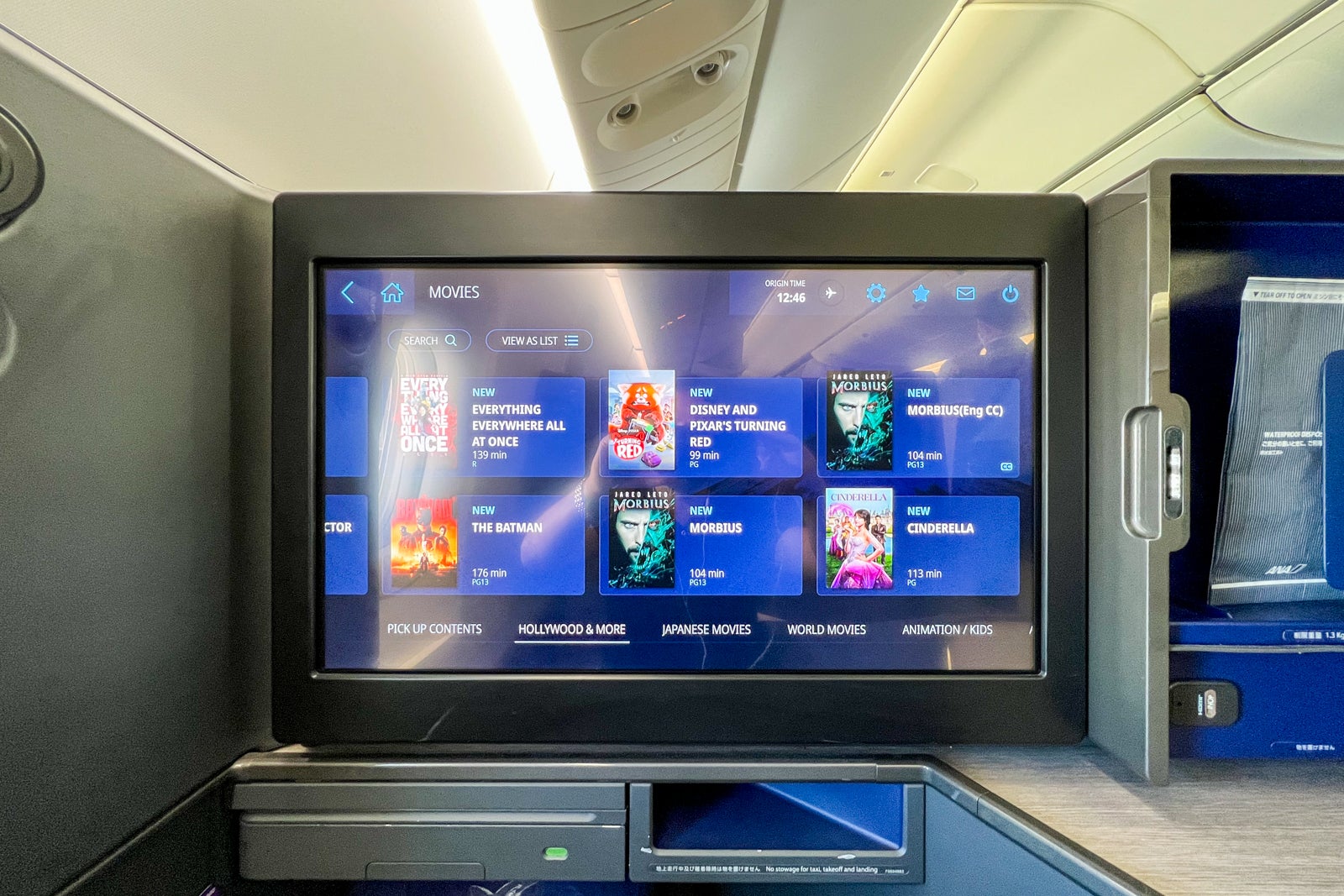
You could also peruse the ANA Sky Shop if you wanted to make any purchases, or simply zone out to a rotating flight map display, as I did.
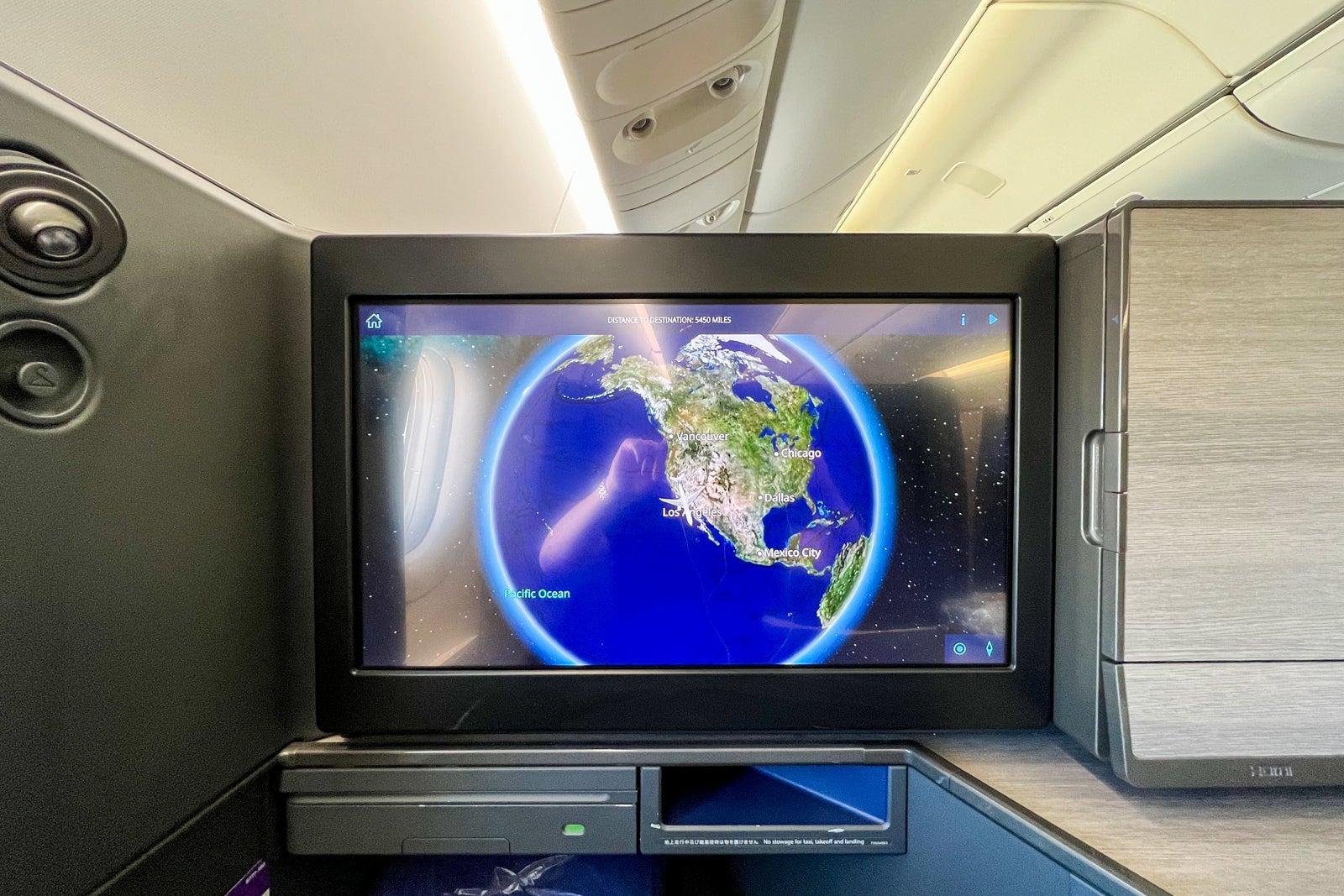
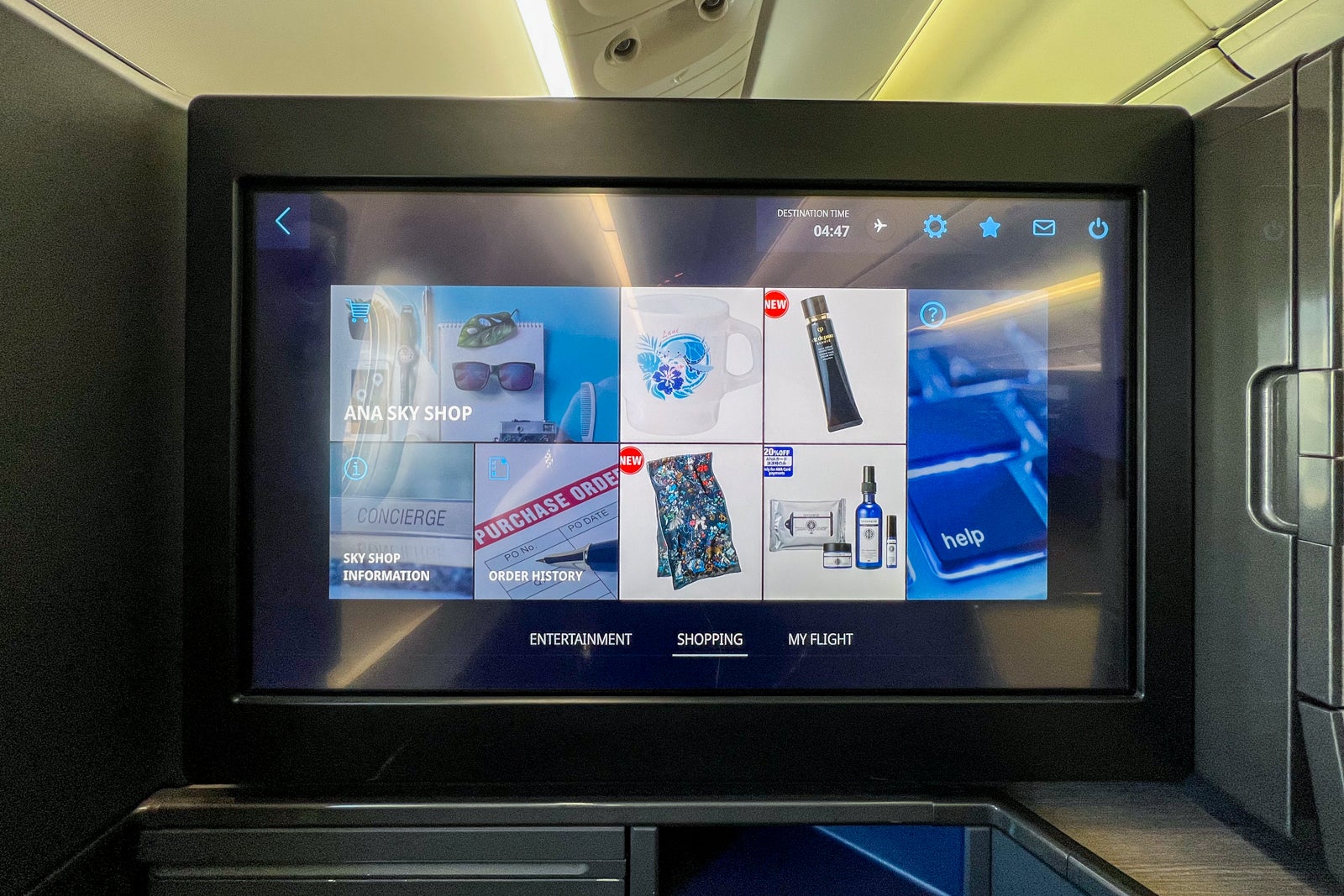
One major downside to my flight was that Wi-Fi was not available. Flight attendants informed passengers as soon as they boarded, but it would have been nice to know that ahead of time. For flights where the Wi-Fi is functioning, expect to pay $6.95 for a 30-minute plan, $14.40 or $16.95 for three hours, or $18.80 to $21.95 for the full flight depending on the aircraft, none of which have data limits.
Business class has four lavatories, so there was rarely a wait to use one of them. Two are located between the front mini-cabin and the main business-class cabin, with two more between the main part of the cabin and the aft mini-cabin.
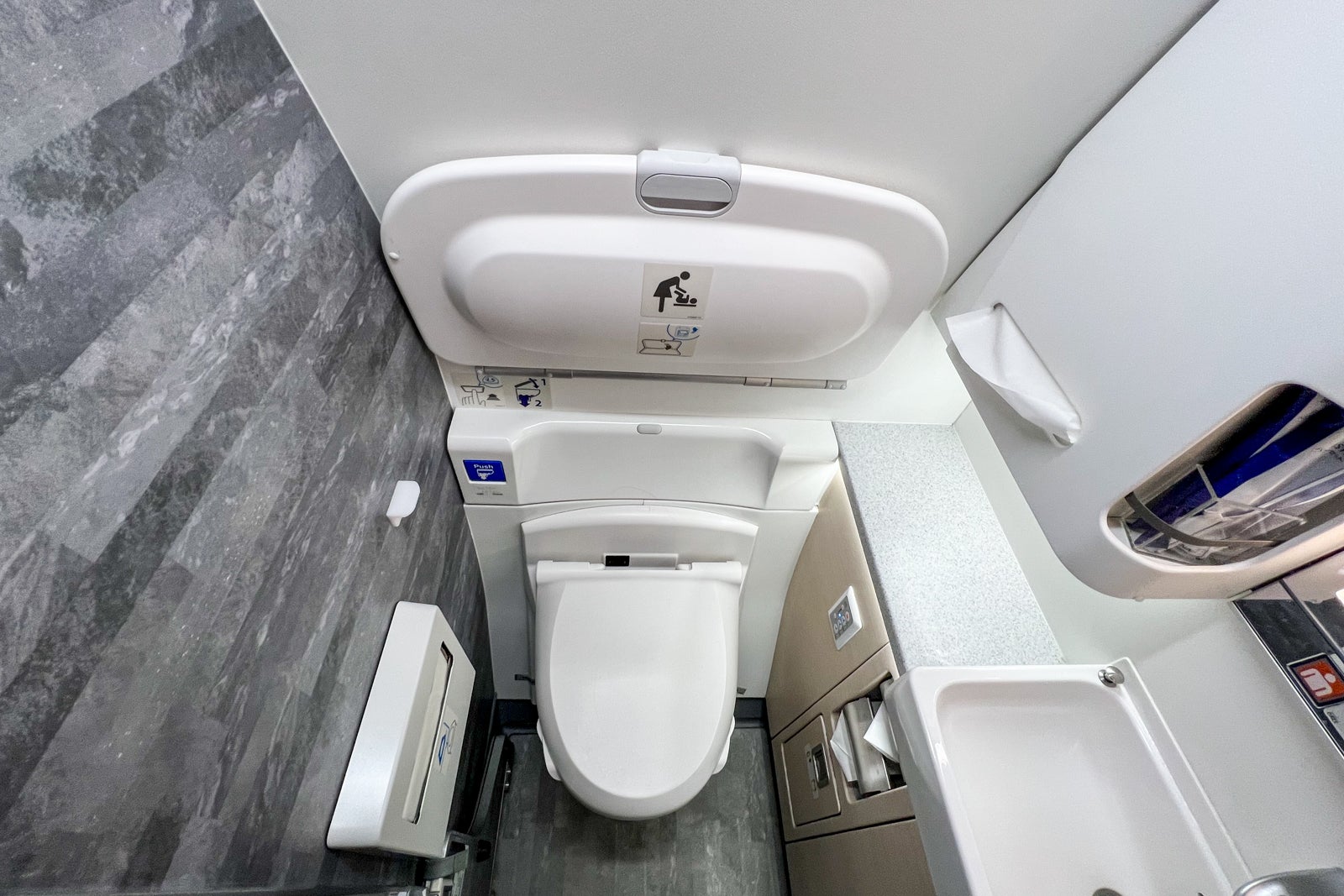
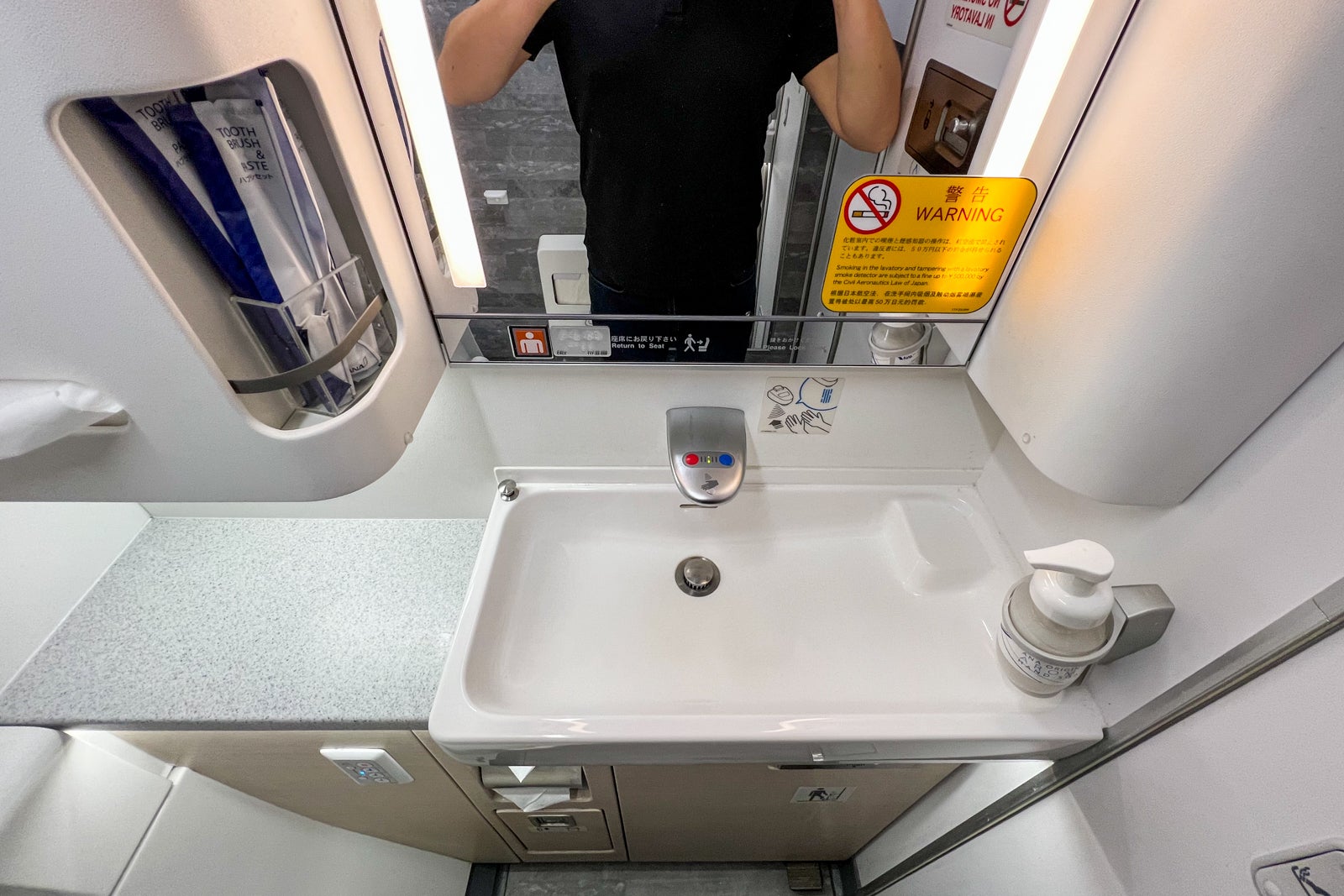
Each is equipped with a touchless sink, but you had to touch the faucet if you wanted to adjust the water temperature. The toilets also had bidet functions you could control with a side panel of buttons — though if you ask me, the last place I would want to use a bidet is in an airplane lavatory!

Flight attendants kept the lavatories stocked with dental kits and mouthwash the whole flight, and there was hand soap with ANA’s “Original Aroma,” which reportedly contains 12 scents including Japanese umbrella pine, cedar, mint and rosemary.
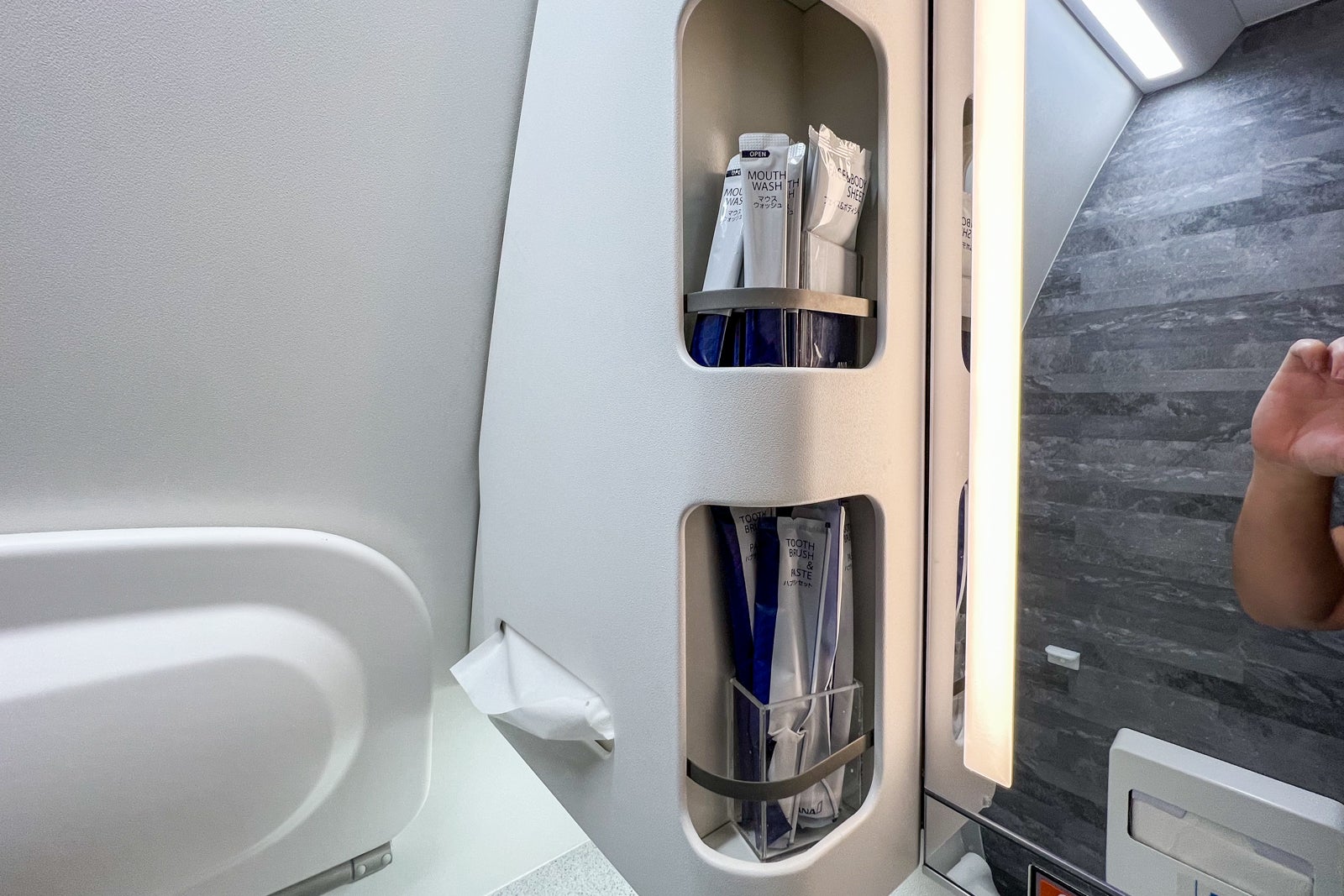
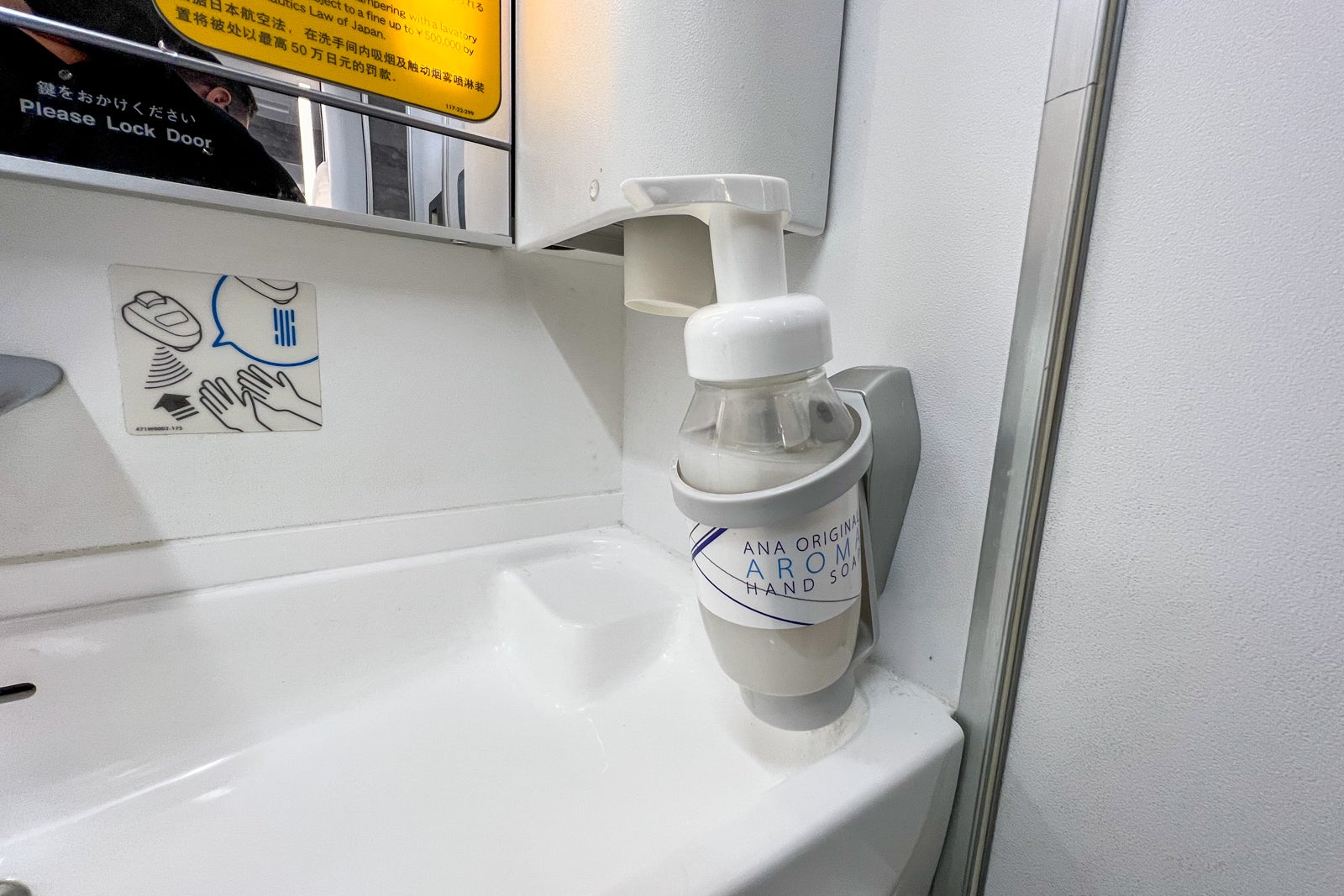
Speaking of the flight attendants, the several I interacted with on my journey from Los Angeles to Tokyo, including Kamo, who was taking care of my section, were simply excellent, especially considering the large size of the business-class section (my flight was mostly full).
It never took one of them more than 30 seconds to respond to the call button when I needed anything like a water bottle or a coffee refill. The meal service flow was quick and efficient but somehow remained personalized and warm. And I had several nice chats with various crew members about everything from the new seats to what traveling in Japan now is like to what the best choices from the menus were. In short, the service was on par with the seats, and that’s saying quite a lot.
Food and beverage
I’ll be honest – one of the reasons I was most excited to fly ANA was for its culinary program. The airline works with a panel of chefs dubbed “The Connoisseurs” who help create its menus. They include luminaries like Toru Okuda from Ginza Okuda, Ryuta Iizuka from Ryuzu plus sommeliers including Olivier Poussier, who was named best sommelier in the world in 2000. So I knew I was in for a treat.
Once general boarding began, flight attendants moved through the business-class cabin settling each passenger in individually and explaining the various seat functions and features to them.
When the foot traffic began to dwindle, they came through with trays offering glasses of orange juice or sparkling wine along with small bottles of water and hot towels. Then, after the boarding door was closed, the flight attendants began taking orders for the first meal service.
ANA lets business-class passengers check the menus for their flights and order in advance if they wish. Not wanting to take any chances, I had pre-ordered the Japanese meal for this flight, figuring I’d get a taste of the country even though I would not be stopping there.
Most orders were taken before takeoff, though I noticed flight attendants getting the last few once we were airborne.
About 20 minutes into the flight, Kamo came by to see if I would like anything to drink and I ordered a glass of sparkling water and a glass of Baddaginnie Run verdelho from Victoria, Australia. She brought glasses of each out a few minutes later accompanied by amuse bouches of caramelized walnuts and almonds and tangy marinated mushrooms, both served on Narumi bone china.
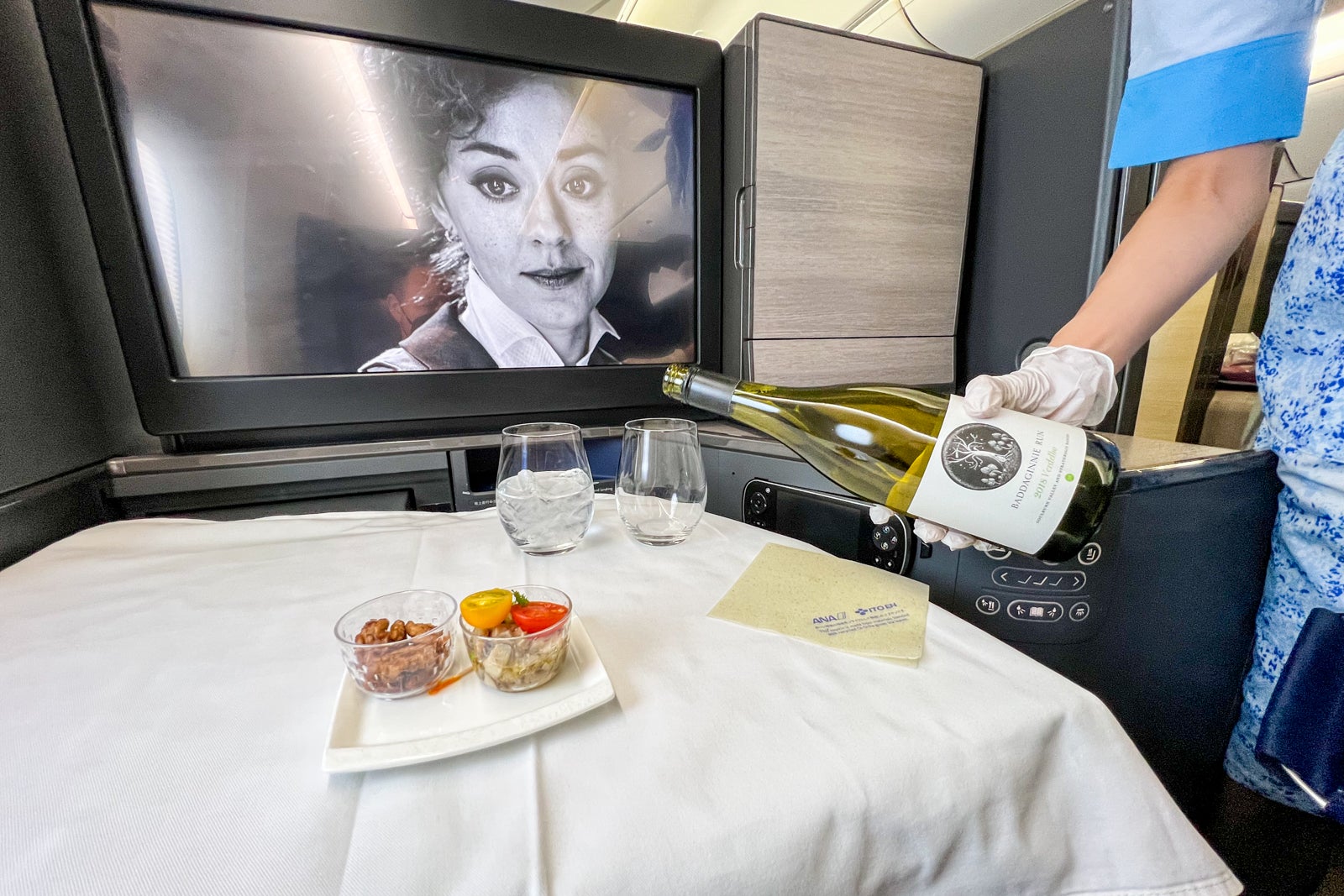
The main meal service commenced about 30 minutes after that. The Japanese menu I ordered began with a “selection of morsels” called zensai that included simmered pumpkin with minced chicken sauce, a cherry tomato marinated in wine sauce, grilled squid with soy sauce, a deep-fried chestnut with rice cracker crispies, luscious seared tuna and rich sesame tofu with sesame cream sauce. I paired them with a fruity but mellow Kubota Manjyu sake that was absolutely delicious. I loved getting to try a lot of different things rather than just having a single appetizer.
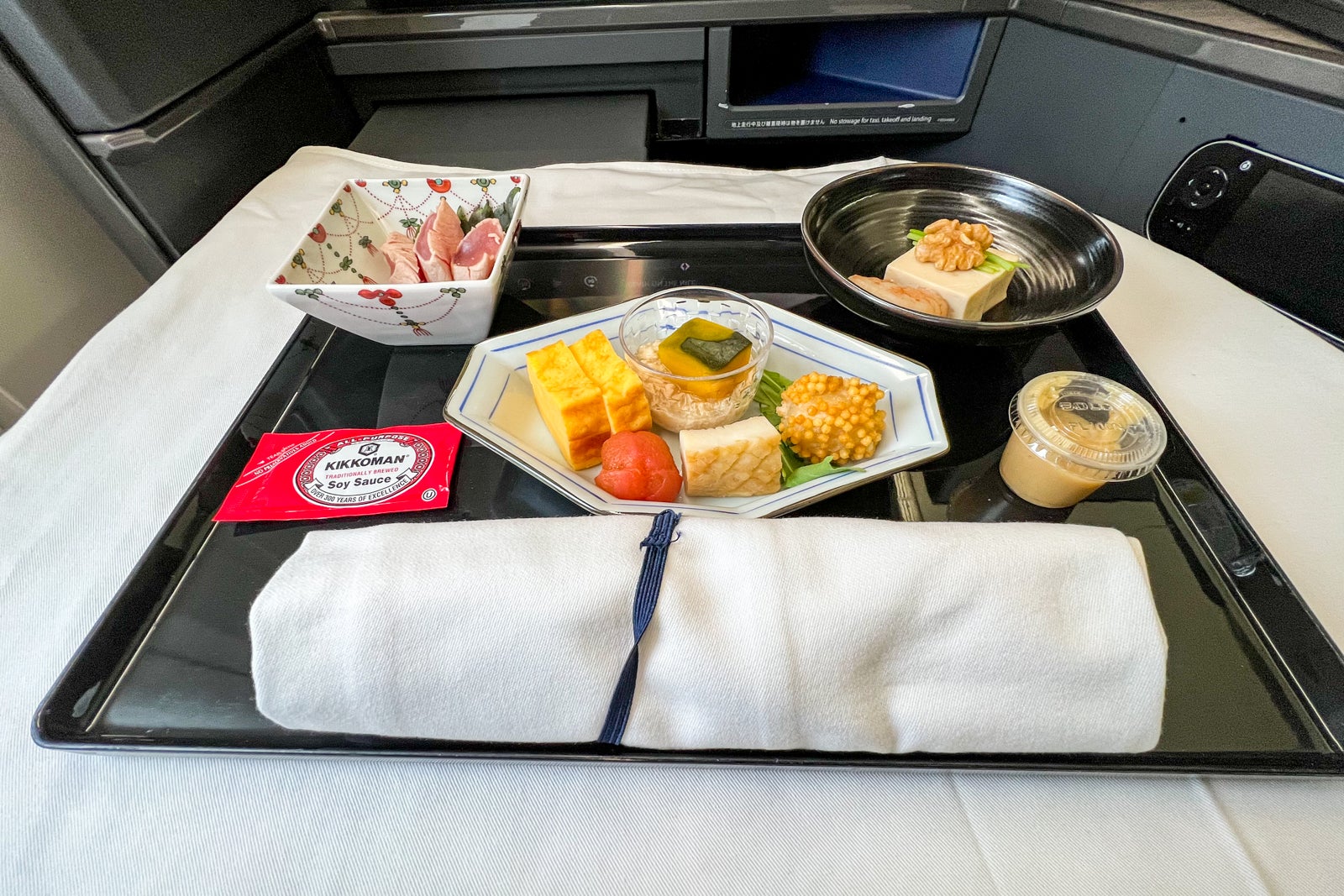
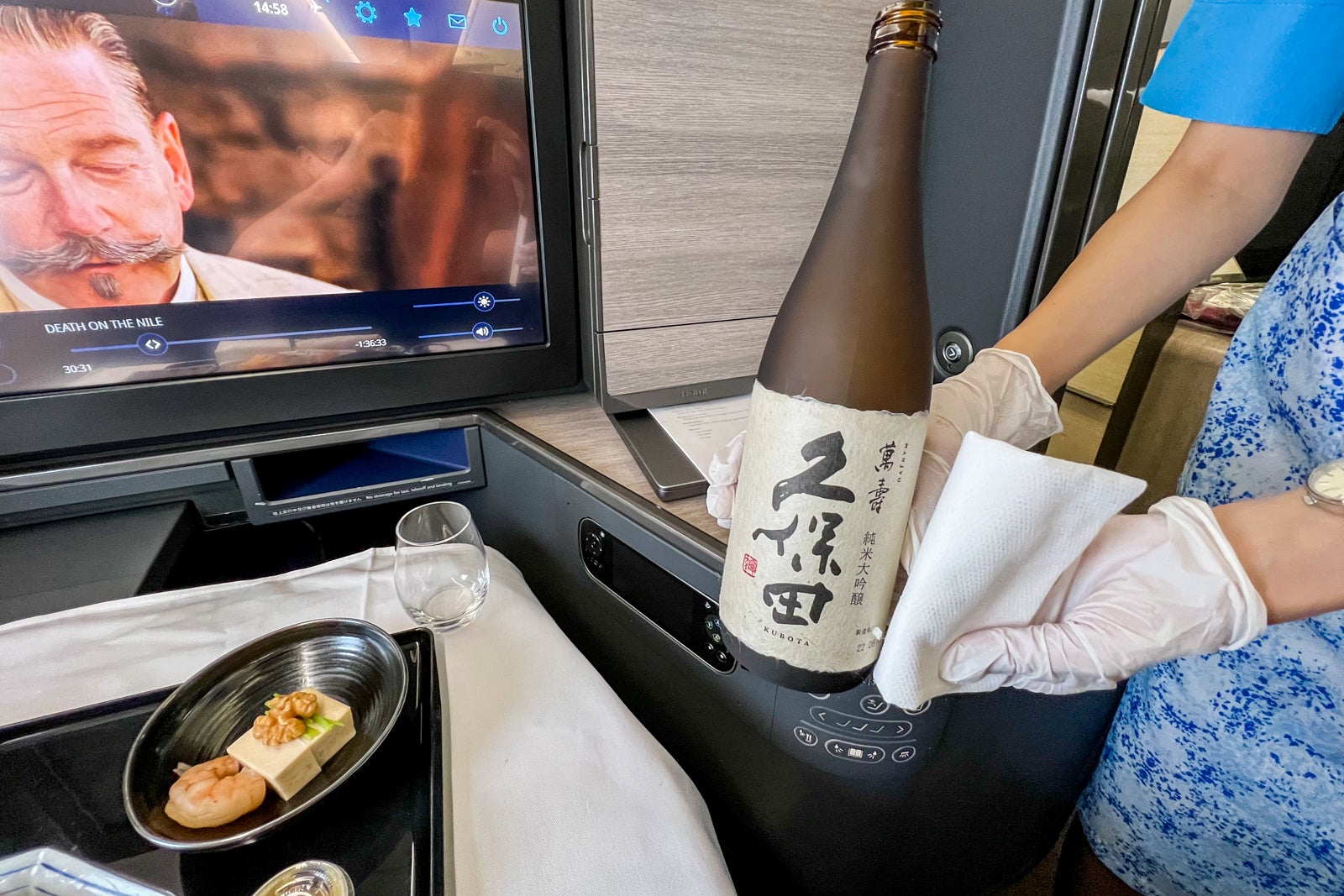
For my main, I enjoyed a filet of mackerel in ginger sauce with steamed rice, miso soup and pickled vegetables served on beautifully patterned Noritake china. The course was a great combination of savory and tangy flavors. For what it’s worth, the international menu included a roasted duck and freekeh salad then a choice of beef fillet with Port wine sauce or grilled salmon with lemon-herb butter, plus a selection of breads and dessert.
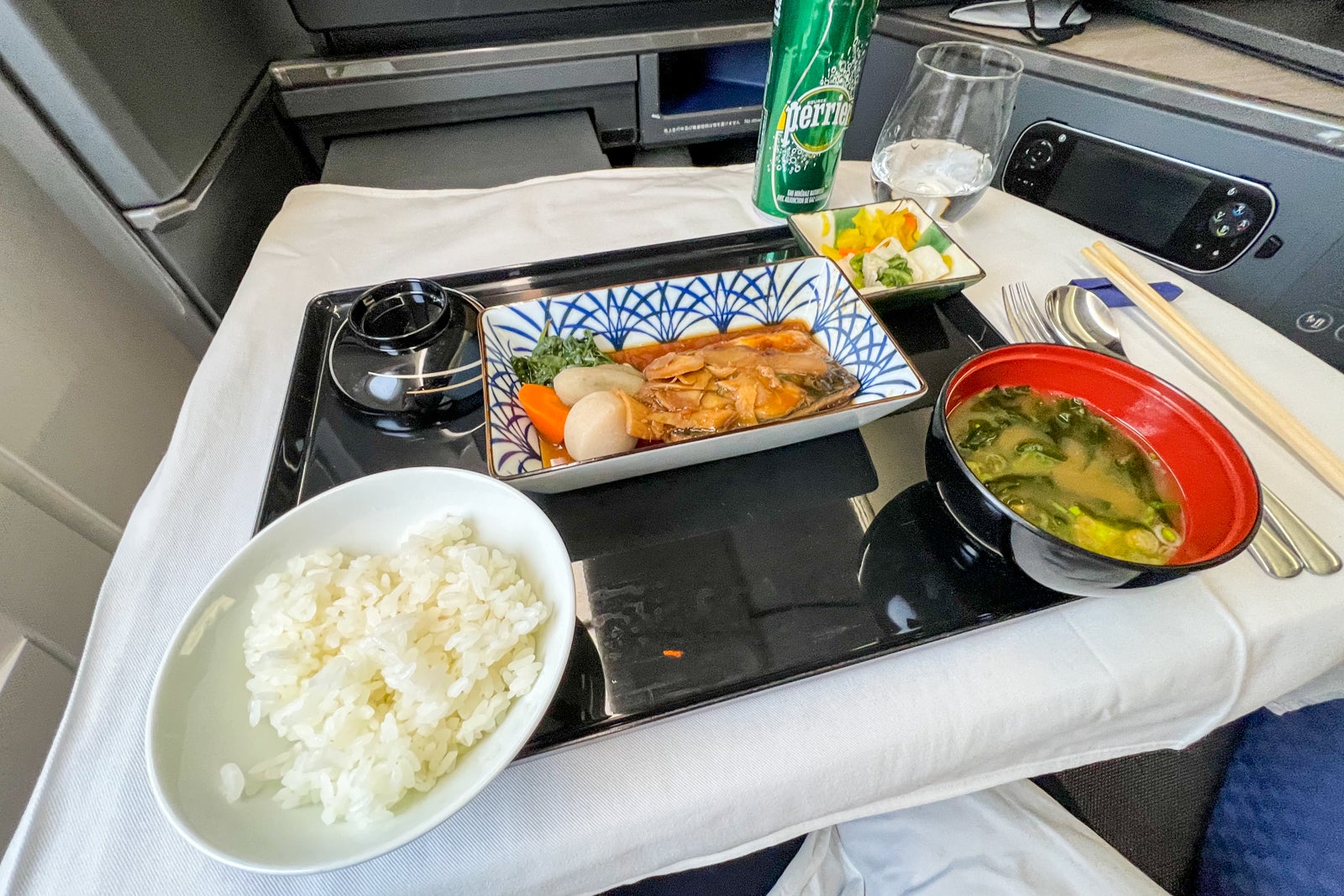
For dessert, I had a cup of Haagen-Dazs vanilla ice cream and a plate with three kinds of cheese ranging from mild and creamy to sharp and blue, plus a prune, some almonds and slices of bread. I skipped the fruit plate.
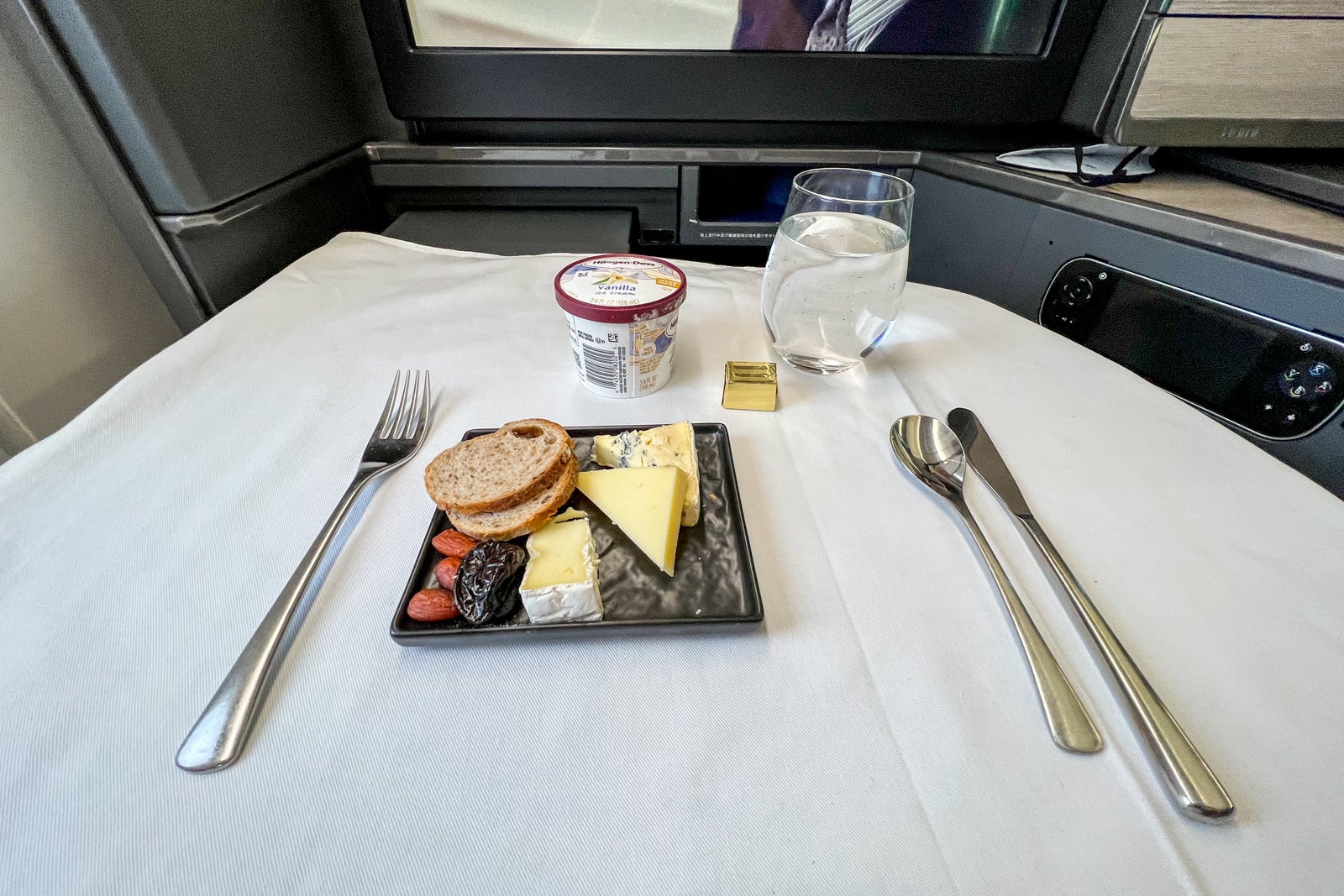
Service was completed about 2.5 hours into the flight. Though that’s a significant chunk of time, given the length of this flight it still left plenty of time to work, rest or relax while watching the entertainment system.
There were plenty of other wines to sample as well, including Chateau Ste. Michelle Mimi Chardonnay from Oregon, Chateau Souverain Merlot from California and a red blend called Sylph from South Australia that was made specially for ANA. The airline serves various Japanese beers like Asahi Super Dry and Kirin Ichiban Shibori, plus Quinta de la Rosa Port, a selection of whiskies and other spirits like shochu.
About two hours before landing, flight attendants came through the cabin for the second meal service, which included both Japanese and international menus. The Japanese one started with marinated spinach and mushrooms in a soy sauce then a main of grilled gold-striped amberjack with steamed rice and a side of miso and pickles. The international fare included duck lasagna and a selection of bread and fruit.
Instead, I asked if I could have something from the anytime menu that’s available after the first meal service since I’d slept most of the time since then. Those dishes included a panini with chicken and mozzarella with sundried tomato, a rice bowl with ginger-fried pork, corn soup, and a variety of snacks like mixed nuts, crackers, yogurt, cereal, fruit and cheese. Wanting something light yet flavorful, I ordered the Ippudo miso ramen (there’s an Ippudo down the street from where I live) and enjoyed the savory broth and hearty noodles.
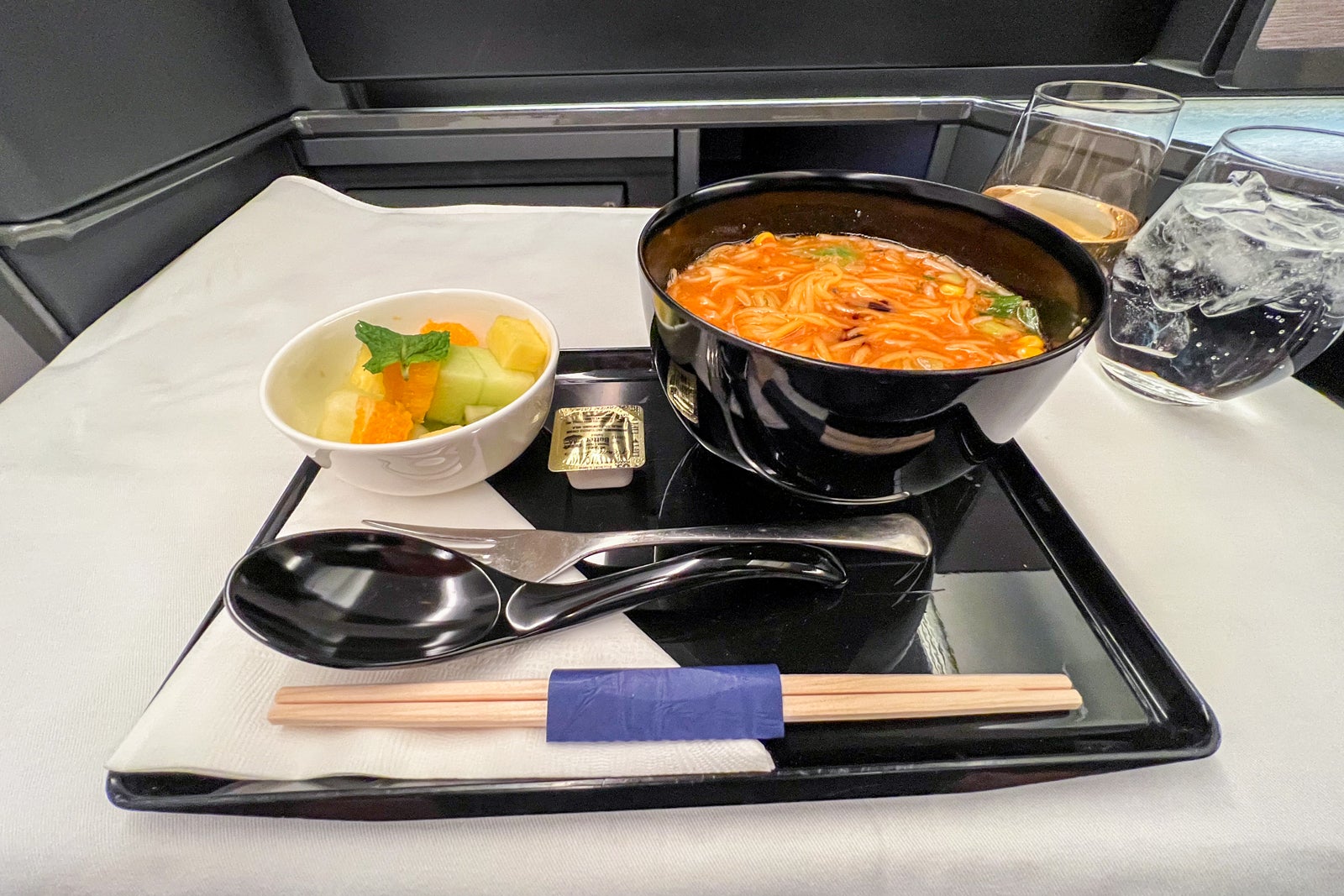
I also got a bowl of fresh fruit for something healthy … though I did want to try a glass of the Duval-LeRoy Brut Reserve Champagne as well. After that, I had a cup of coffee to perk up before landing then changed back into my street clothes for our final descent.
The food, including that sumptuous Japanese meal plated on beautiful Narumi and Noritake china, was definitely a highlight of the experience.
Final approach
After years of anticipation, I finally had the opportunity to fly ANA’s The Room on my flight from Los Angeles to Tokyo, and the experience did not disappoint.
No business-class seat is going to be absolutely perfect, even the best of them, like Qatar’s Qsuite and the Delta One Suite. But ANA’s The Room came as close to it as any of them.
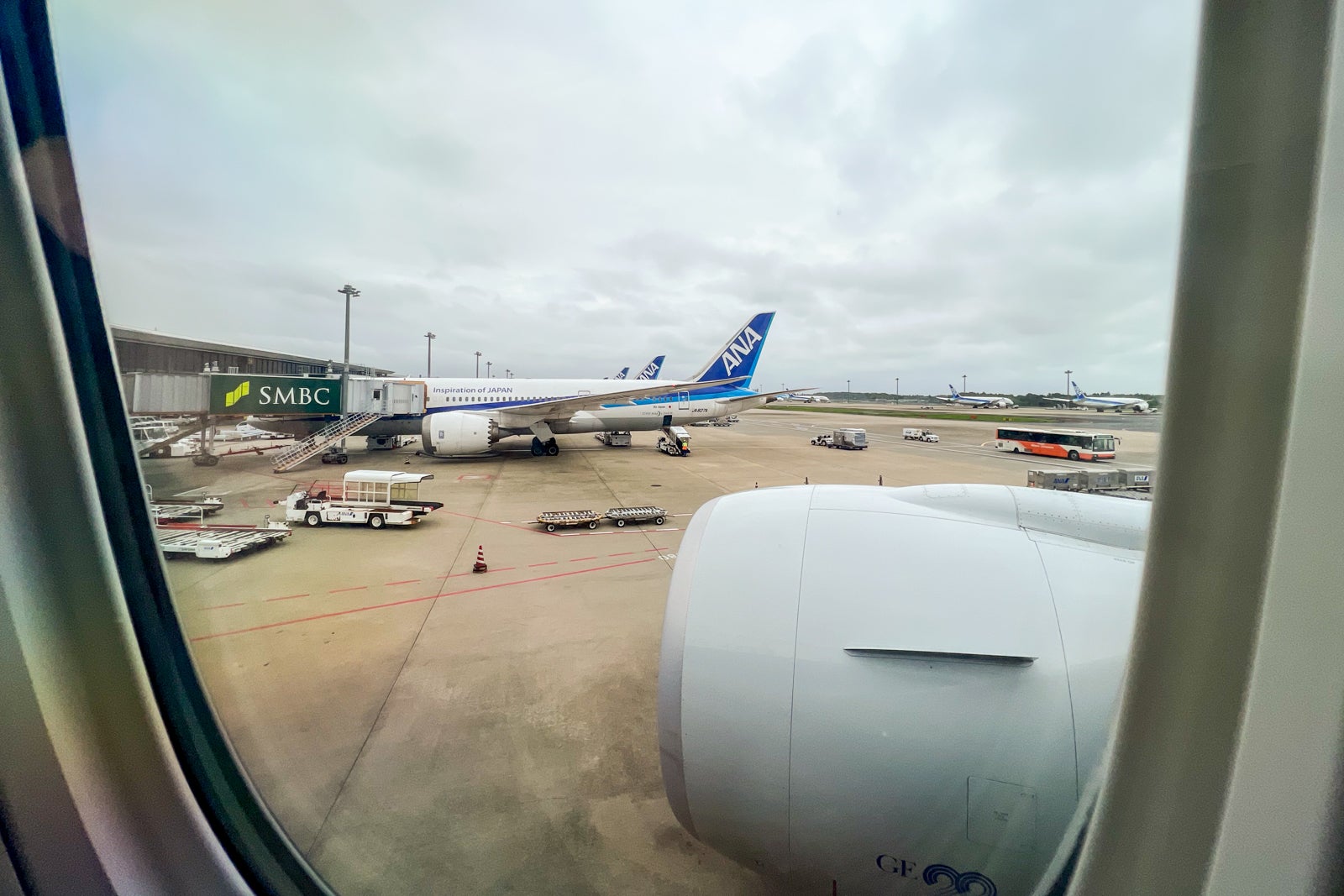
The suite’s huge footprint along with its surfeit of personal space and high-tech features all put it a step ahead of most business-class seats.
The soft amenities could be more extensive, including better bedding, more complete amenity kits and bespoke pajamas.
That said, the seat itself, paired with ANA’s unparalleled service and appetizing menus, meant this was an experience I’ll continue to savor … and will seek out again. The only thing that could stop me is if I find an award ticket to fly the first-class The Suite instead next time.



